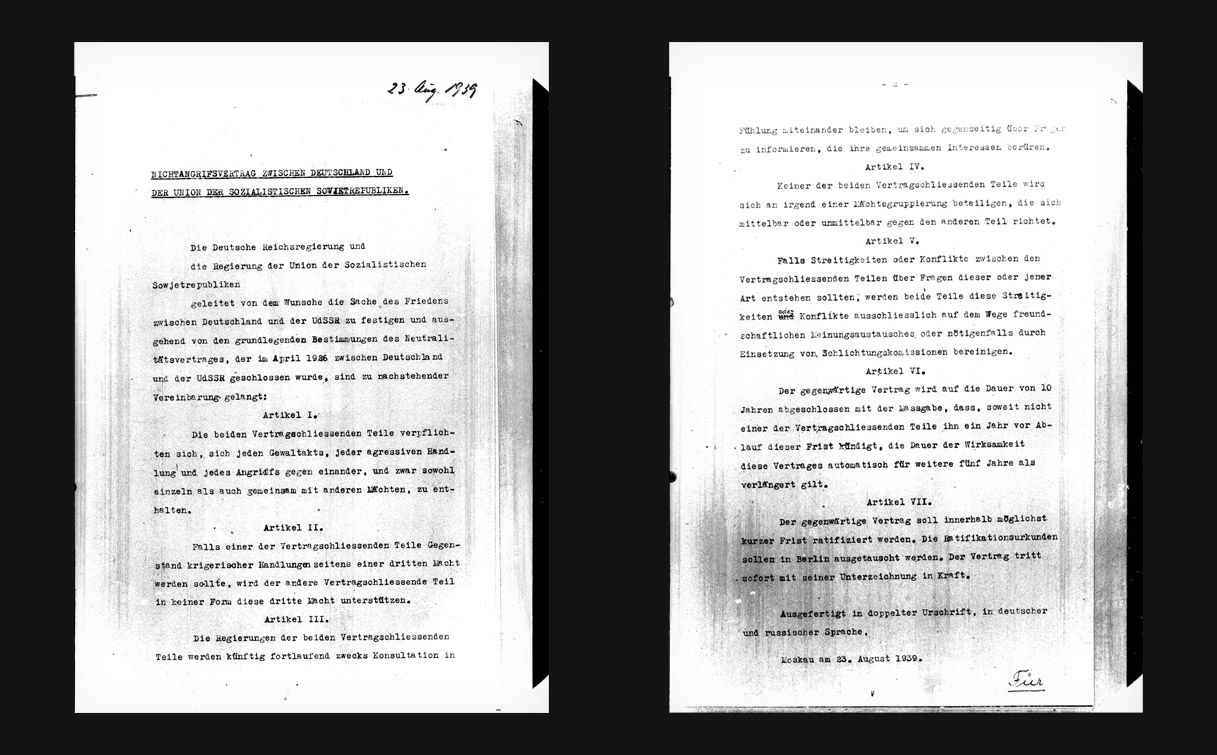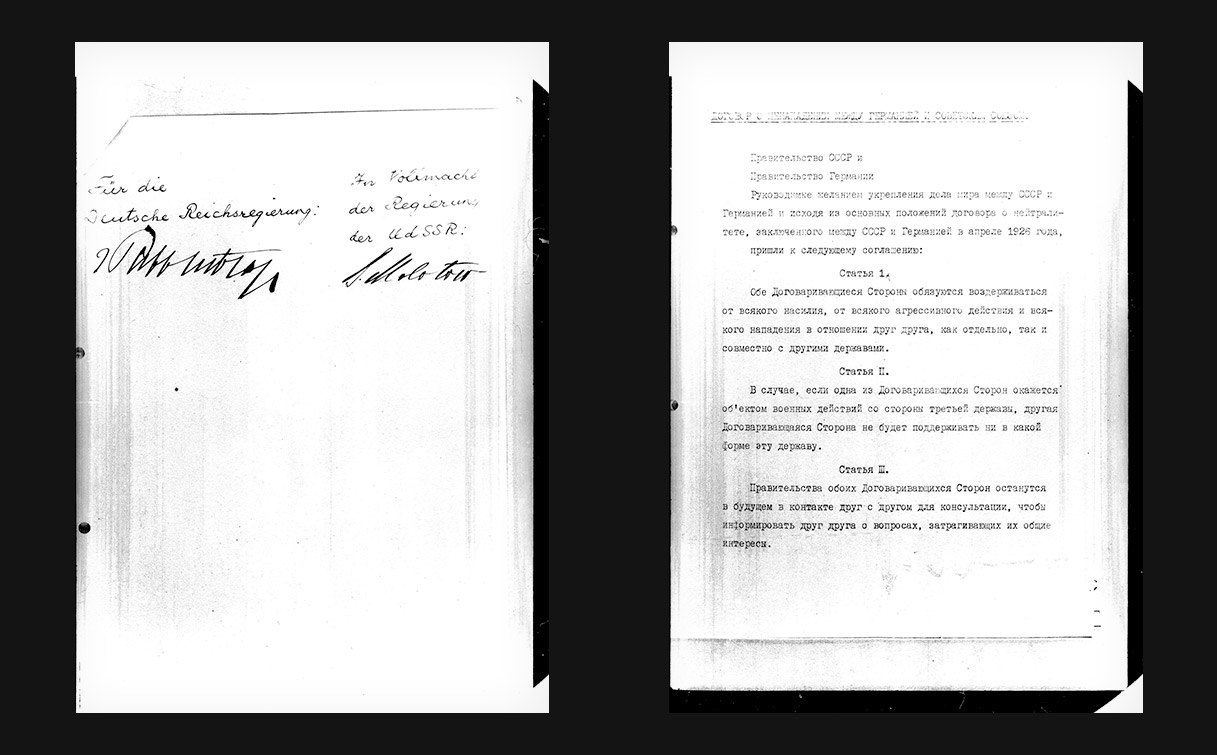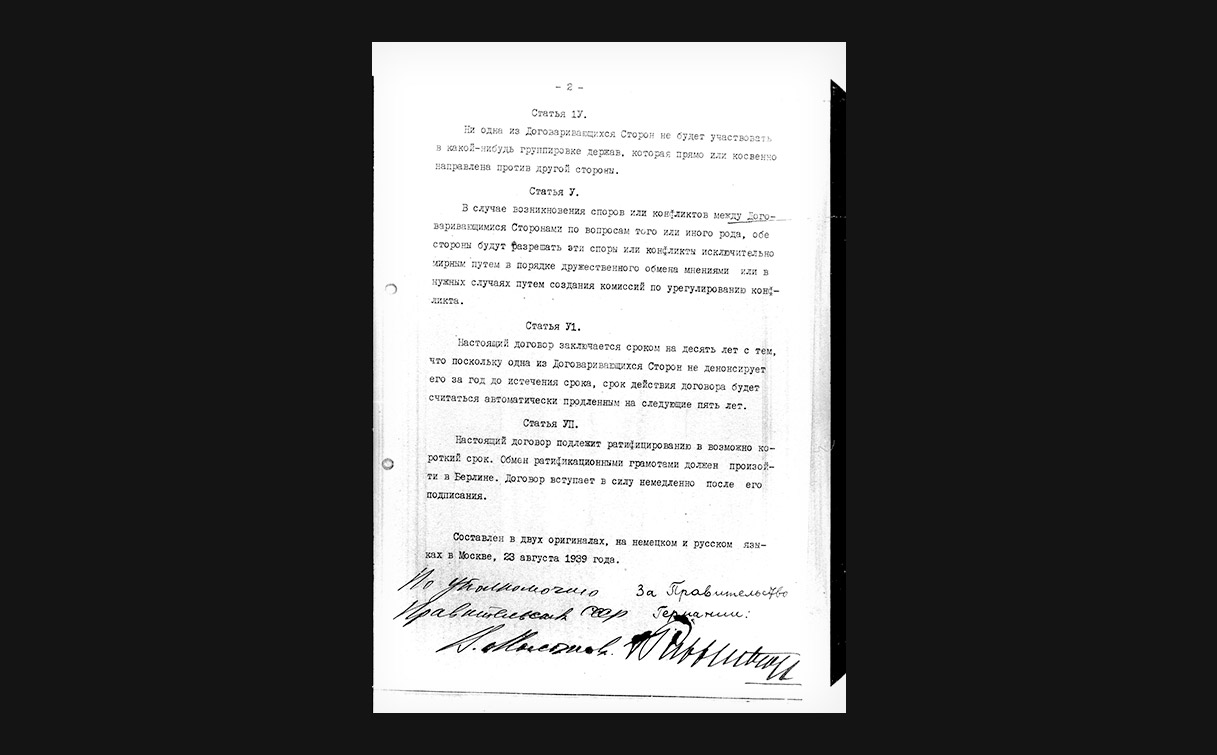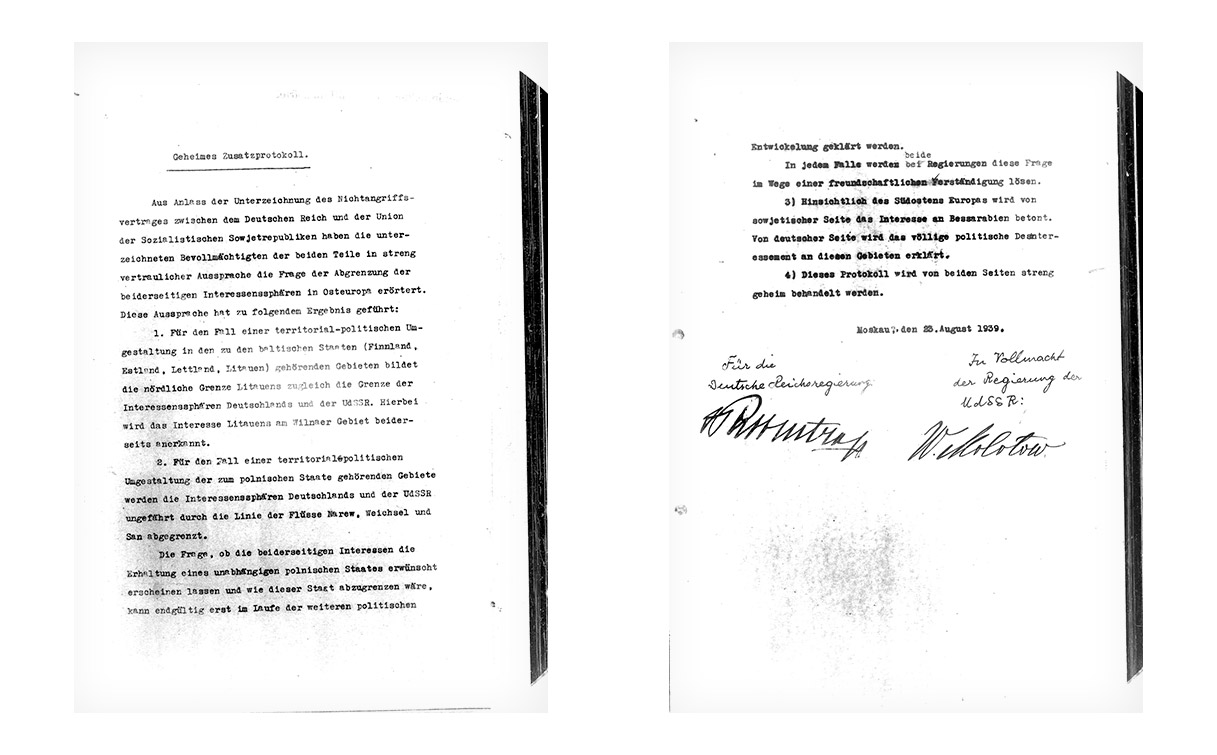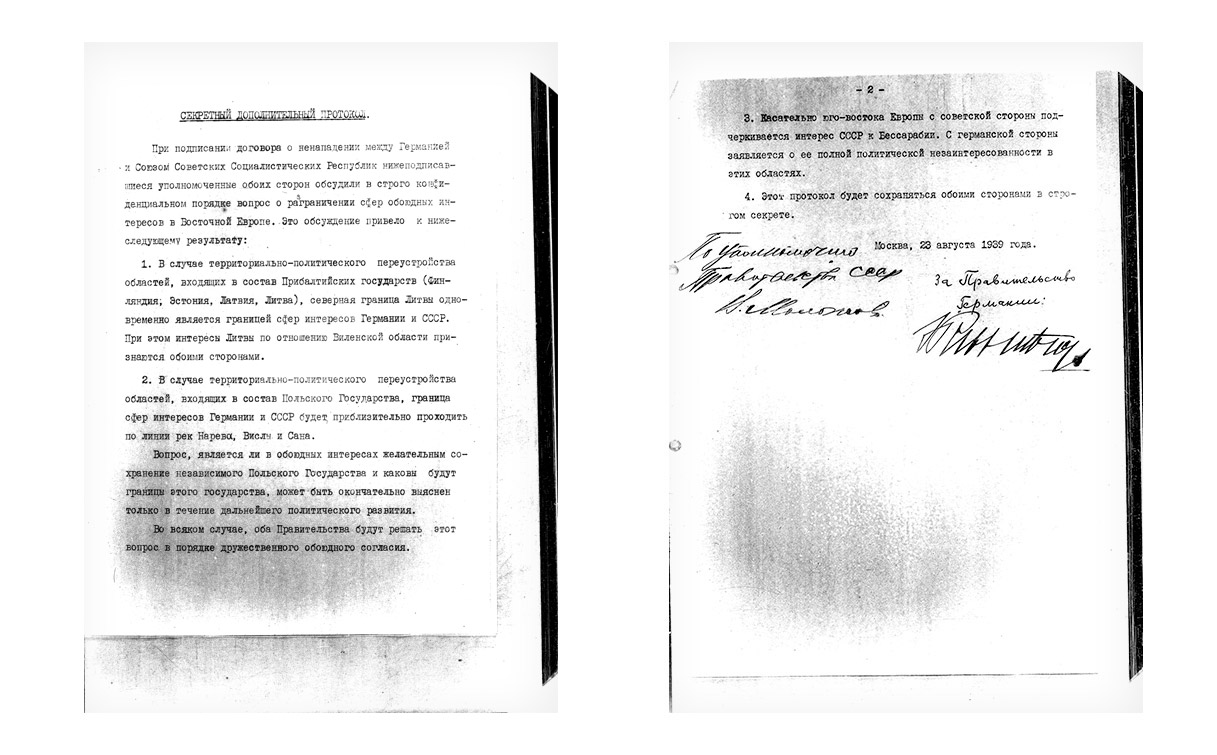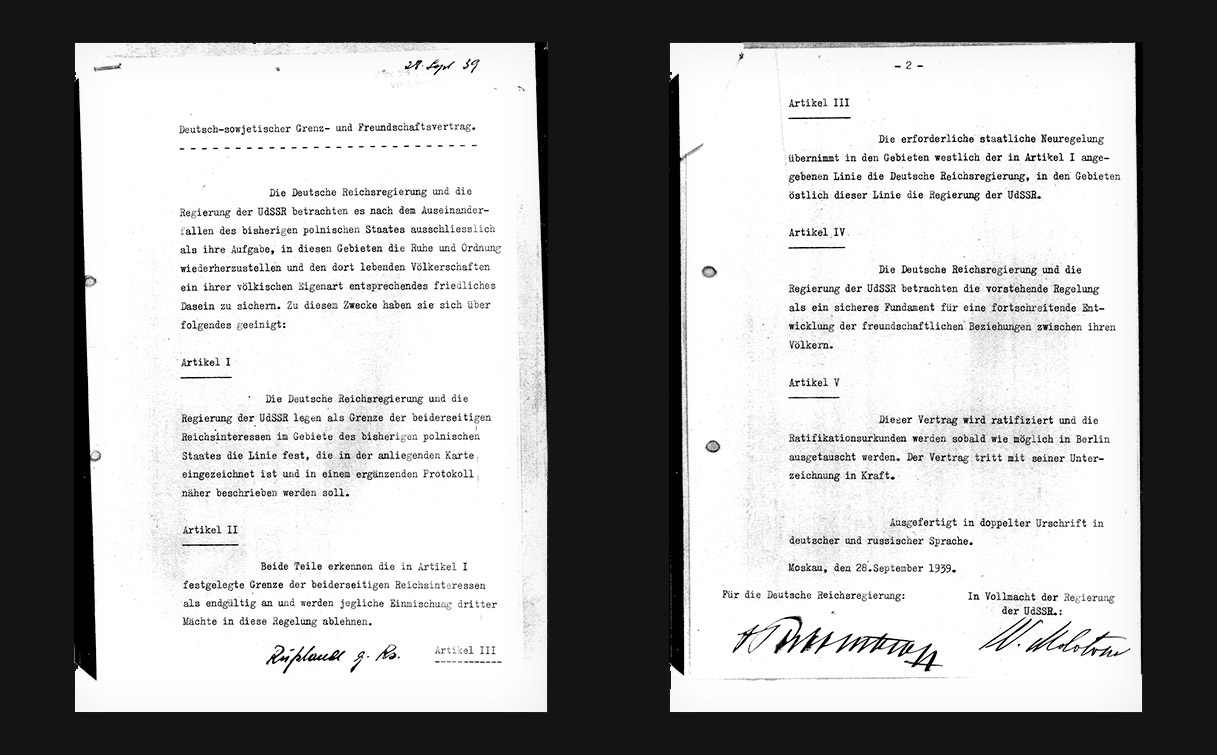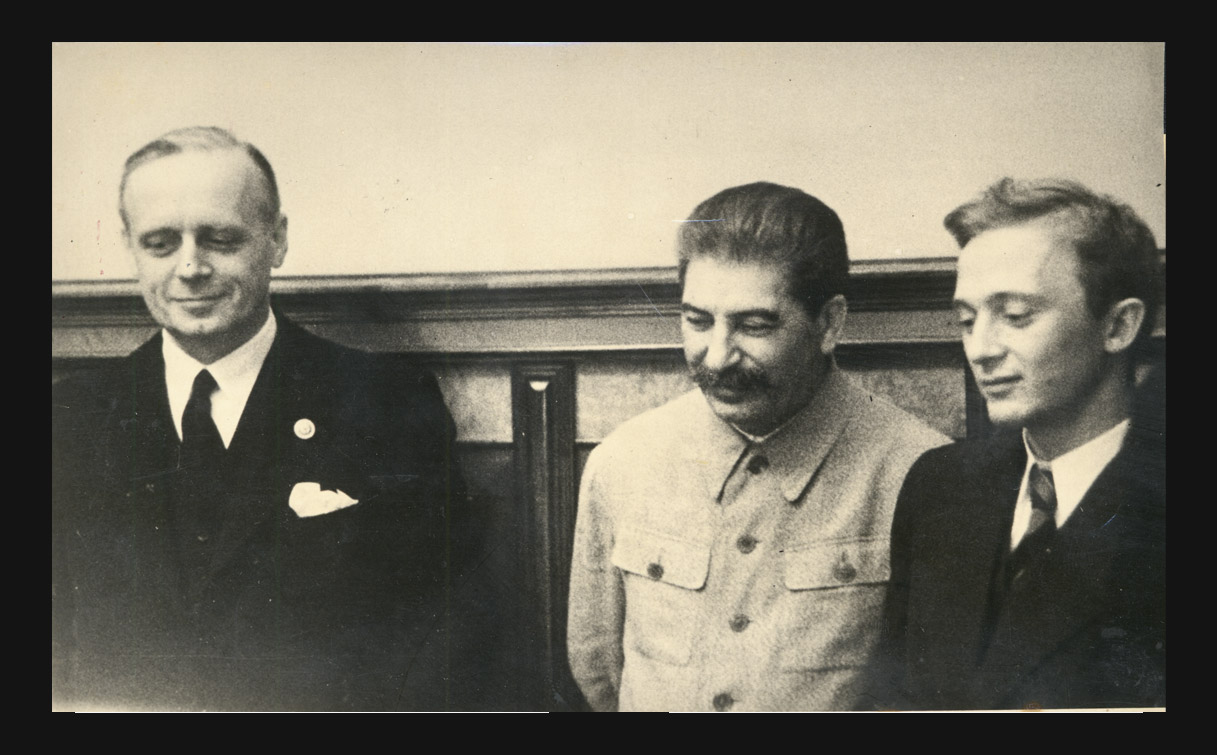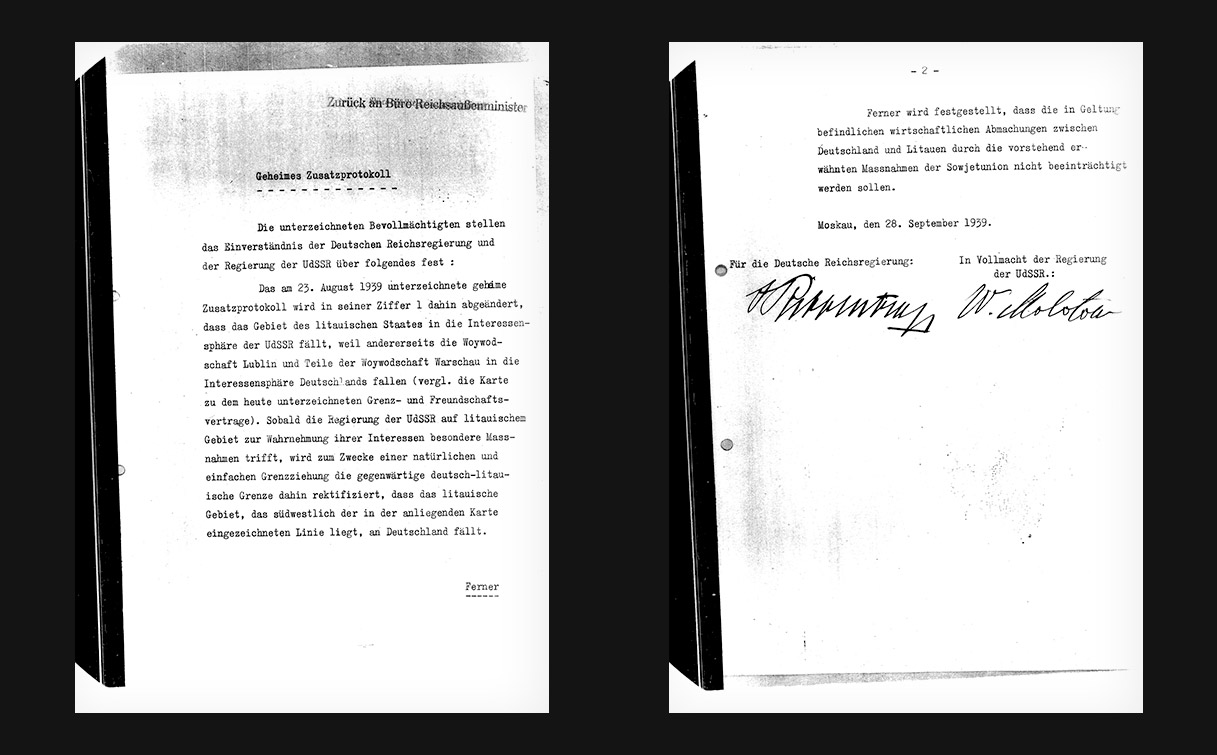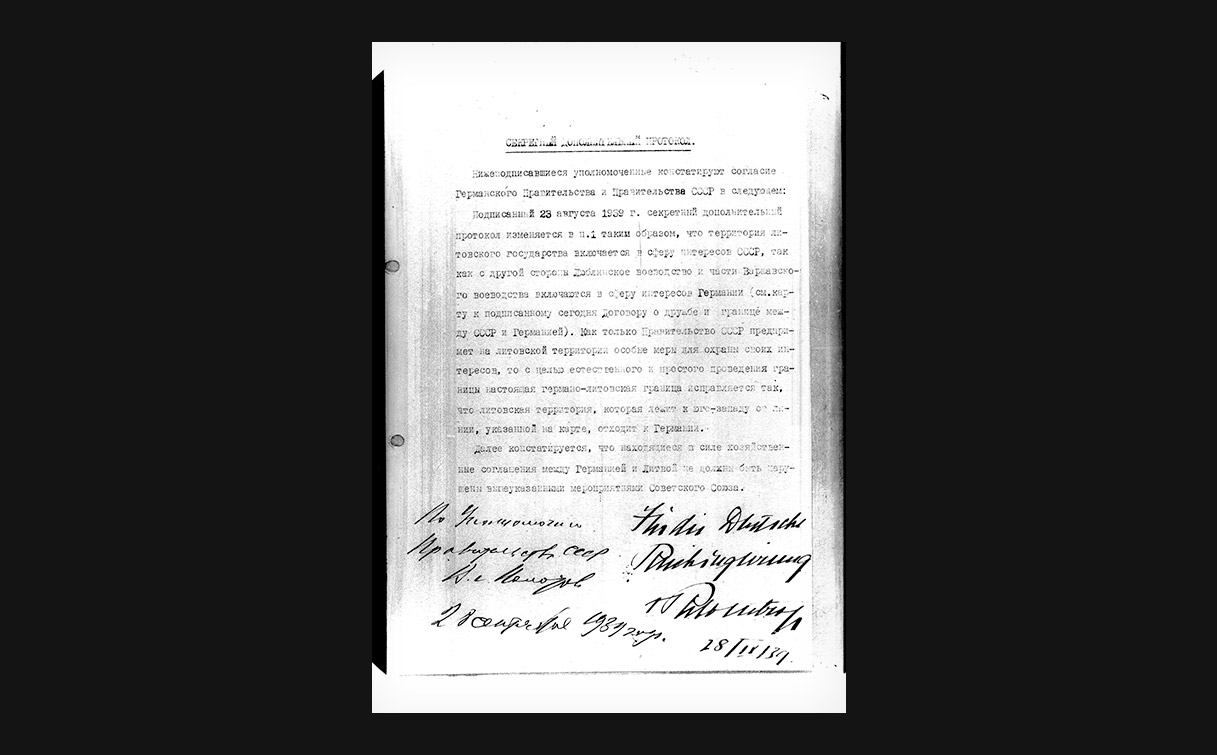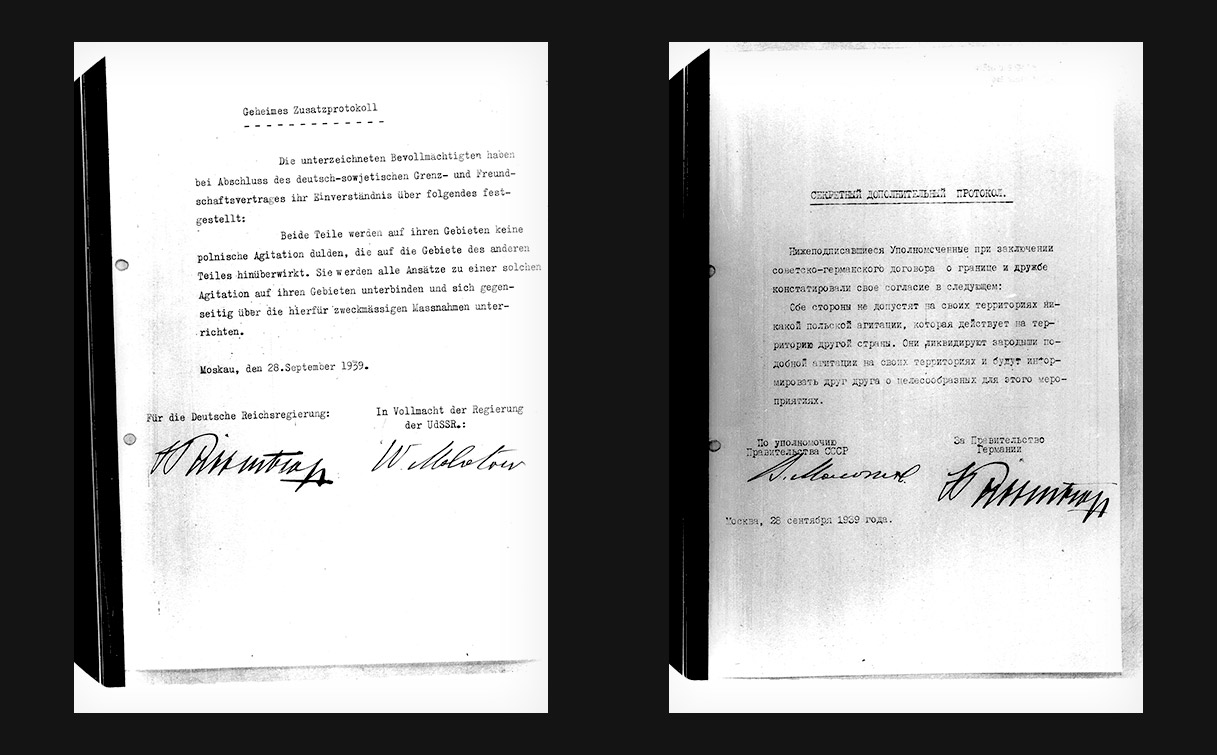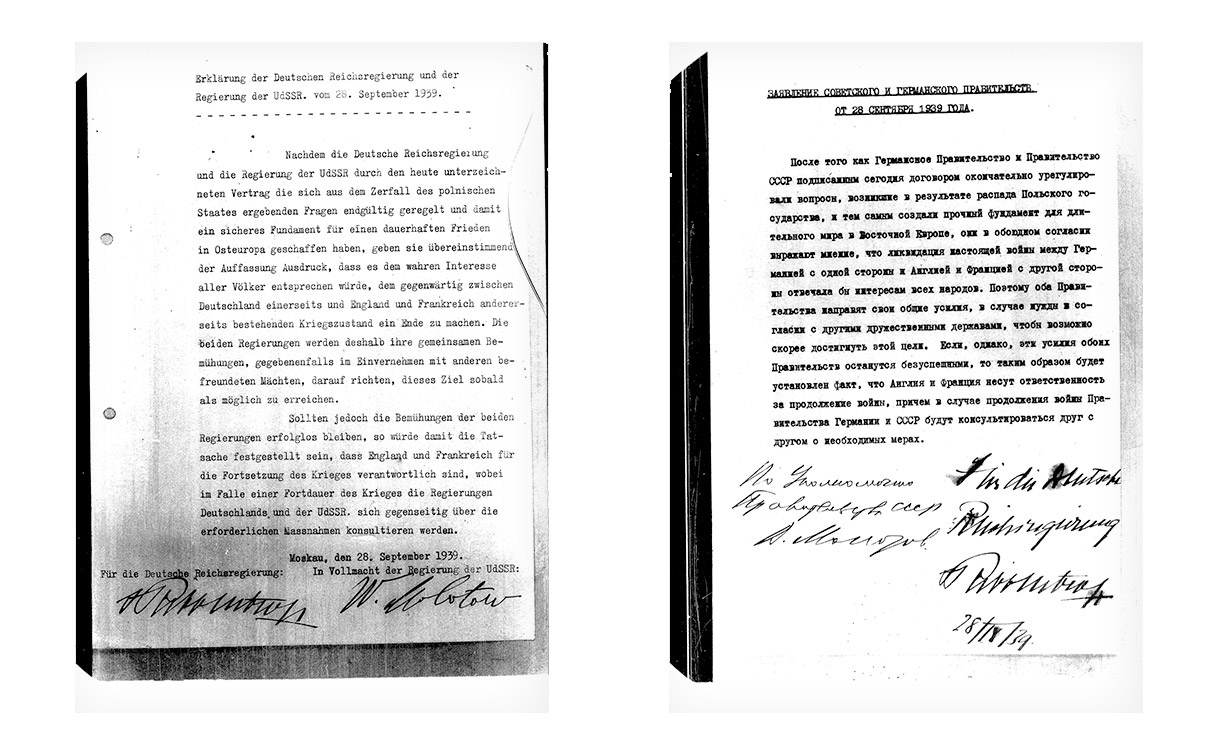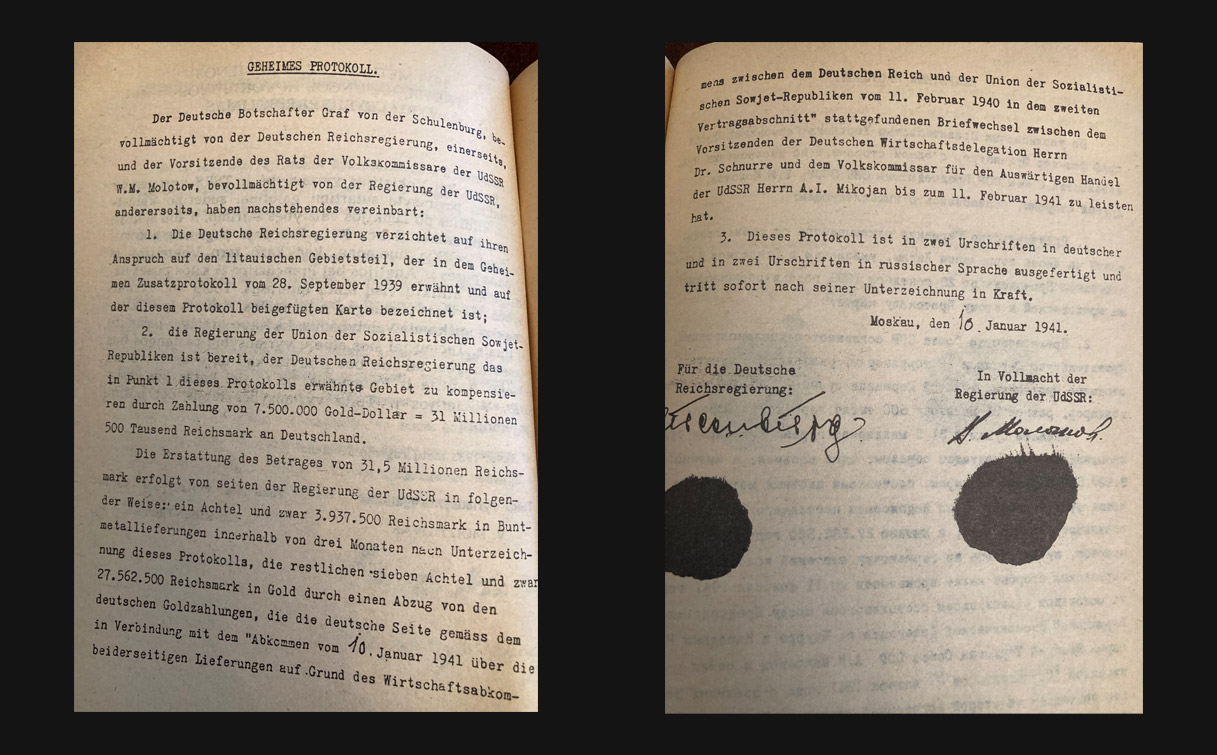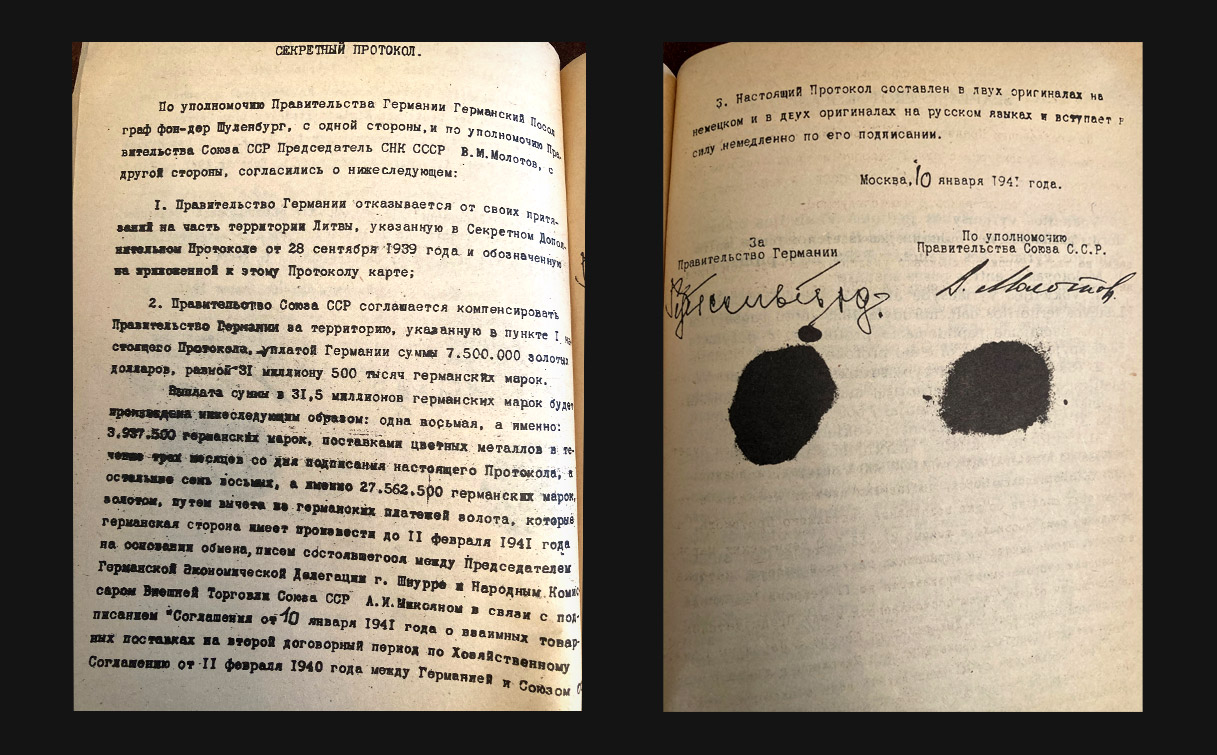About the exhibition
The credo of this virtual exhibition is twofold: to DEFEND and to REMEMBER. The duty of Lithuanian citizens is to defend the national history and historical truth of their nation and state. On the other hand, a no less important duty of our citizens and the state is to remember the most significant historical facts and events, to prevent their falsification, and collectively preserve the historical memory of the nation and its people. Because, in addition to language, culture, and the land itself, historical memory is the basis for the survival and historical progress of every nation.
23/08/1939
TREATY OF NON-AGGRESSION BETWEEN GERMANY AND THE SOVIET UNION
On 23 August 1939, the ministers of foreign affairs in Germany and the Soviet Union, Joachim von Ribbentrop and Vyacheslav Molotov, signed a non-aggression pact that differed from other agreements of a similar nature in that it was concluded by two aggressive totalitarian states, that it had its secret protocols, and was directly against the independence and sovereignty of third countries.
“Both High Contracting Parties obligate themselves to desist from any act of violence, any aggressive action, and any attack on each other, either individually or jointly with other Powers.”
SECRET SUPPLEMENTARY PROTOCOLS OF THE MOLOTOV-RIBBENTROP NON-AGGRESSION PACT
According to the Secret Protocol of the Treaty of Non-Aggression between Germany and the USSR, Latvia, Estonia, Finland, eastern Poland, and parts of Romania (Bessarabia) remained within the USSR’s sphere of influence, while Lithuania and West Poland “went to Germany”.
“In the event of territorial-political reorganisation of the districts making up the Baltic States (Finland, Estonia, Latvia, Lithuania), the northern border of Lithuania is simultaneously the border of the spheres of interest of Germany and the USSR. The interests of Lithuania with respect to the Vilnius district are recognised by both sides.”
28/09/1939
THE GERMAN-SOVIET TREATY OF FRIENDSHIP, COOPERATION AND DEMARCATION
On 28 September 1939, another treaty was signed in Moscow, establishing new borders between Germany and the USSR, increasing the territories of these states at the expense of third countries, de facto liquidating Polish statehood and the right of the Polish people to sovereignty and establishing the actual geopolitical partnership between Germany and the USSR.
“The Government of the German Reich and the Government of the USSR consider it as exclusively their task, after the collapse of the former Polish state, to re-establish peace and order in these territories and to assure to the peoples living there a peaceful life in keeping with their national character.”
SECRET CONFIDENTIAL PROTOCOL OF THE GERMAN-SOVIET TREATY OF FRIENDSHIP, COOPERATION AND DEMARCATION
The secret “confidential protocol” under the German-Soviet Treaty was devoted to certain “national policies” and principles of Nazi Germany and Stalinist USSR.
“The Government of the USSR will not impede German citizens or other persons of German ancestry residing within its spheres of interest should they desire to move to Germany or to German spheres of interest.”
SECRET SUPPLEMENTARY PROTOCOL ON TRANSFERRING LITHUANIA FROM THE SPHERES OF INTEREST OF GERMANY TO THE USSR
Following the clarification of a paragraph of the Secret Supplementary Protocol signed on 23 August 1939 with a new Secret Supplementary Protocol, the fate of the Lithuanian State and the Lithuanian people was determined for more than half a century. It was this paragraph de facto and de jure that separated Lithuania and Lithuanians from Western culture and civilisation for decades.
“The territory of the Lithuanian state is included in the sphere of interest of the USSR because, on the other side, Lublin voivodeship and parts of Warsaw voivodeship are included in the sphere of interest of Germany.”
MAP ACCOMPANYING THE GERMAN-SOVIET BOUNDARY AND FRIENDSHIP TREATY OF 28 SEPTEMBER 1939, SHOWING THE NEW BORDER BETWEEN GERMANY AND THE USSR AND THE BOUNDARIES OF AREAS OF INTEREST
A special map was added to the German-Soviet Boundary and Friendship Treaty of 28 September 1939, which basically recorded the fourth division of the Polish state between Germany and the USSR (Russia).
Looking south to north, the border between Germany and the Soviet Union, in the territory of Poland, was drawn almost parallel to the San-Bug-Narew-Pisa rivers. On the map we can see that in the south, the border began near Przemyśl, and in the north ended at the southern border of Lithuania, leaving the rest of Lithuania (excluding the Klaipėda region, which Germany had taken from Lithuania on 22 March 1939) in the Soviet “sphere of interest”. That wall is broadly, but not very carefully, drawn on the map with a black pencil. On the right are the signatures of Soviet dictator, Joseph Stalin, and Foreign Minister of the Third Reich, Joachim von Ribbentrop, and the date. The eloquent attributes of the treaty should have evidenced the great mutual trust between the signatories.
On the eve of World War II, Poland had an area of 389.7 thousand km². It had a population of about 35.339 million people. According to the division of Poland by Berlin-Moscow, Germany received 188.7 thousand km², or 48.4% of the total Polish territory, with a population of approximately 22.140 million (62.7%). Of this area, a territory of 92,000 km², with a population of approximately 9 million, was annexed by Hitler already in October 1939 and directly incorporated into the Third Reich. The remaining Polish-occupied lands, with a population of about 13 million, formed the so-called General Governorate of Berlin.
According to the agreement recorded on the map, the Soviet Union received 201.000 km² or 51.6% of the former Polish territory, with 13.199 million inhabitants (37.3%). Of this territory, to the Belarusian SSR – an area of 103.000 km² with a population of 7.733 million was transferred; to the Ukrainian SSR – 89.7 thousand km² with a population of 7.929 million; to the Republic of Lithuania, pursuant to the Soviet-Lithuanian Peace Treaty of 12 July 1920, under the Soviet-Lithuanian Non-Aggression Pact of 28 September 1926, and under the Soviet-Lithuanian Mutual Assistance Treaty of 10 October 1939 –Vilnius, and about one third of south-eastern Lithuania: 8.3 thousand km² with a population of approximately 537,000. [For more information on the geopolitical and demographic consequences of Hitler-Stalin’s fourth division of Poland, see: Eberhardt, P. Przemieszczenia ludności na terytorium Polski spowodowane II wojną światową. Warszawa: Pan Instytut Geografii i Przestrzennego Zagospodarowania im. Stanisława Leszczyckiego, 2000].
SECRET SUPPLEMENTARY PROTOCOL ON PREVENTING POLISH AGITATION ON THE TERRITORY OF THE OTHER TREATY SIGNATORY
This Secret Supplementary Protocol in fact denied the right of the Polish nation to sovereignty and national statehood.
“Neither side will permit on their territories any sort of Polish agitation affecting the territory of the other country. They (will) abort such agitation on their own territories and will inform each other as to effective measures to accomplish this.”
JOINT DECLARATION BY THE GOVERNMENTS OF GERMANY AND THE SOVIET UNION FOLLOWING THE SIGNING OF THE GERMAN-SOVIET BOUNDARY AND FRIENDSHIP TREATY ON THE FUTURE POLICY OBJECTIVES OF THOSE STATES
This document clearly illustrates the difficult geopolitical situation in Western democracies at the end of 1939.
“…England and France are responsible for the ongoing war, and if the war continues, the German and USSR governments will discuss the necessary measures.”
10/01/1940
GERMAN-SOVIET BORDER AND COMMERCIAL AGREEMENT
The document clearly reflects the goals and methods of major totalitarian states in the international arena at the beginning of World War II. It is evidence of the total disregard of international law by Berlin and Moscow, failure to accept the sovereignty of independent states and their territorial integrity, as well as the political will of the peoples living here.
“The Government of the USSR agrees to compensate the Government of Germany for the territory indicated in point 1 of the present Protocol with a payment to Germany in the amount of 7,500,000 gold dollars, the equivalent of 31,500,000 German marks.”
1953 – 1986
LITHUANIAN DIASPORA PROTESTS IN THE USA, AUSTRALIA AND EUROPE, DEMANDING THE ABOLITION OF THE CONSEQUENCES OF THE MOLOTOV-RIBBENTROP PACT AND FREEDOM FOR LITHUANIA
In 1944–1945, during the Soviet reoccupation of Lithuania, more than 50,000 politically active and literate Lithuanians emigrated from their homeland to Western Europe. Since it was difficult to settle in war-torn Europe and the various secret services of the USSR monitored or persecuted political emigrants, from the late 1940s and especially in the 1950s, the absolute majority of Lithuanian emigrants from Europe moved to the United States or other countries less affected by the World War. Especially attractive to Lithuanians was the economic prosperity of the USA, where Lithuanian communities were strong and rich, and Lithuanian parishes had been established since the end of the 19th century. In addition, the local Lithuanian press, Sunday schools, and the multifaceted cultural and political life of the local Lithuanian communities was being developed there.
It is not surprising, therefore, that in America an entire network of Lithuanian political patriotic organisations formed and here the largest, most extensive, and active Lithuanian political emigration’s resistance against the consequences of the Molotov-Ribbentrop Pact occurred. It was a fight against the occupation and annexation of Lithuania and the restoration of an independent state. Especially active anti-Soviet political-propagandist and liberation activities were developed by the Supreme Committee for the Liberation of Lithuania, American Lithuanian Council, Lithuanian World Community, National Lithuanian Society of America and a number of others. It was through their initiative, efforts, and funds that the main political work was organised.
Various anti-Soviet political demonstrations, manifestos, pickets, rallies, and campaigns were held in cities across the USA and in Europe. Various memoranda, petitions, letters of protest were sent to international organisations, US and foreign governments. Particular efforts were made to act wherever and whenever the issues of the world’s other enslaved nations were dealt with, where the world’s public attention was concentrated at one point or another, or when representatives of the Soviet Union visited.
Therefore, protests against the consequences of the Molotov-Ribbentrop Pact, the annexation of Lithuania, and demands for the freedom of Lithuania were often carried out at the headquarters of the United Nations in New York or even after entering the actual headquarters; in Paris – at the UNESCO Palace; in Madrid and Vienna – during Conferences of the Organisation for Security and Cooperation in Europe, as well as at embassies of the USSR in various capitals of the world.
The fact that the resistance of the Baltic nations against the Soviet occupation/annexation was the most prominent in North America was determined by the position of the US administration. Since 23 July 1940, when Under Secretary of State, Sumner Welles, made a declaration that the USA does not recognise the legitimacy of the incorporation of the Baltic States into the USSR, Washington consistently maintained this position until the disintegration of the Soviet Union and the final liberation of the Baltic States in 1990–1991. Thanks to this attitude of the United States, the Embassy of the Republic of Lithuania remained in Washington throughout the Soviet period while Lithuanian consulates remained active in New York and Chicago.
Work towards the liberation of Lithuania was also carried out in Europe. First, in those countries that did not recognise the legitimacy of the Soviet occupation/annexation of Lithuania (and other Baltic States) and where remnants of the diplomatic service of Lithuania remained: London, Paris, Berne, Rome (Vatican). Here the diplomatic case of Lithuania’s liberation from the Soviet occupation was curated and continued by Lithuania’s diplomatic chief Stasys Lozoraitis Sr. and his sons Stasys Lozoraitis Jr. and Kazys Lozoraitis, Stasys Antanas Bačkis, Ričardas Bačkis, Jurgis Baltrušaitis Jr., Antanas Liutkus, Žiba Klimienė, Bronius Bazvardys Balutis, Vincas Balickas, Dr Jurgis Šaulys, Edvardas Turauskas and many other Lithuanian diplomat patriots. This fight on the part of the Lithuanian political emigration for the liberation of their homeland from foreign oppression remained vitally important until the first public protest rally of the LLL in Vilnius in August 1987, the birth of Sąjūdis in June 1988 and the restoration of Lithuania’s independence on 11 March 1990.
-
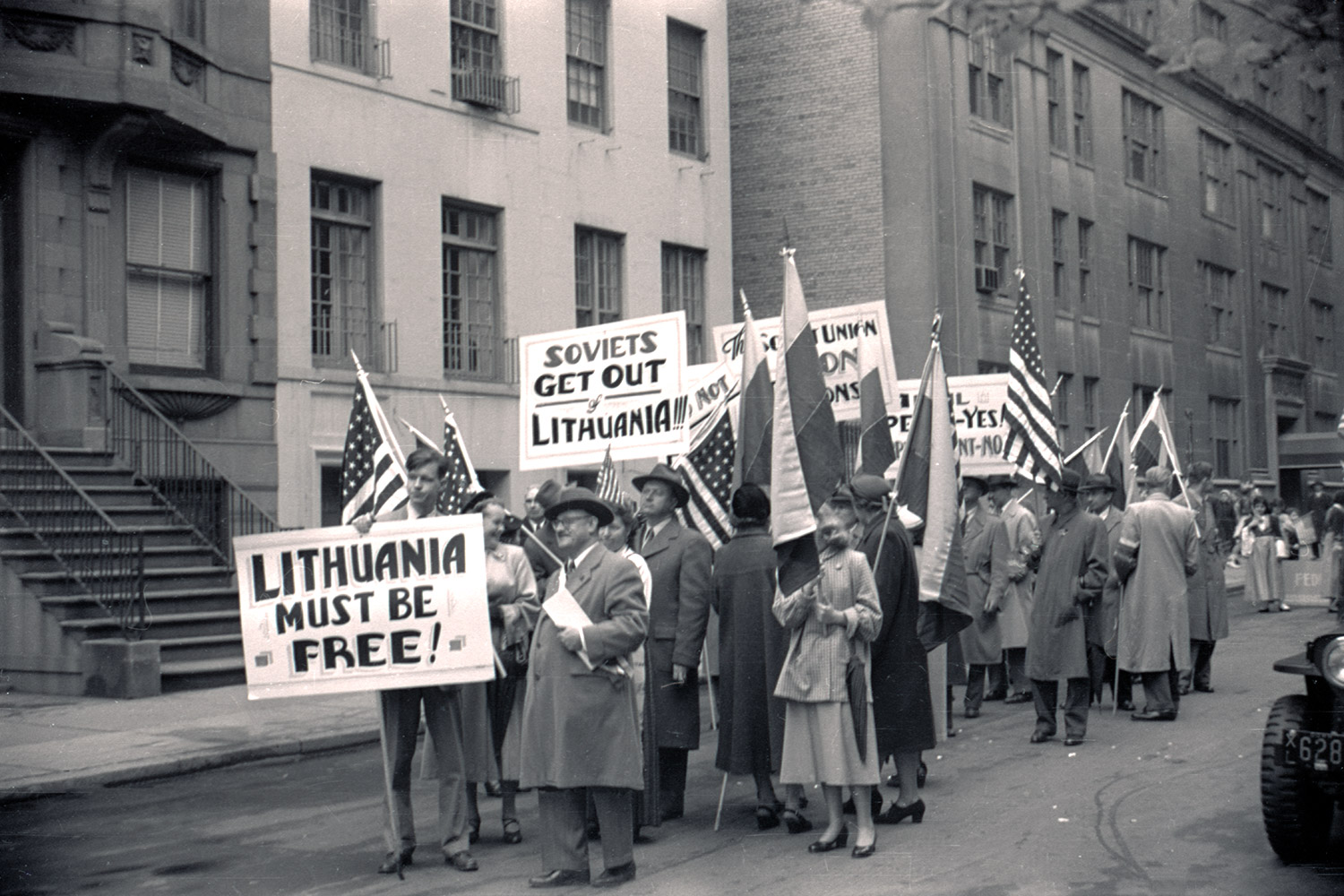 1953 – New York, USA. A group from the Lithuanian American community protests against the Molotov-Ribbentrop Pact and the occupation/annexation of Lithuania, at the Loyalty Day parade. They carry 14 Lithuanian and 14 US flags. In the first row, Kęstutis Trimakas, a member of the Lithuanian National Union of Students (LSS), hold a poster. LVCA, photographer: G. Penikas.
1953 – New York, USA. A group from the Lithuanian American community protests against the Molotov-Ribbentrop Pact and the occupation/annexation of Lithuania, at the Loyalty Day parade. They carry 14 Lithuanian and 14 US flags. In the first row, Kęstutis Trimakas, a member of the Lithuanian National Union of Students (LSS), hold a poster. LVCA, photographer: G. Penikas. -
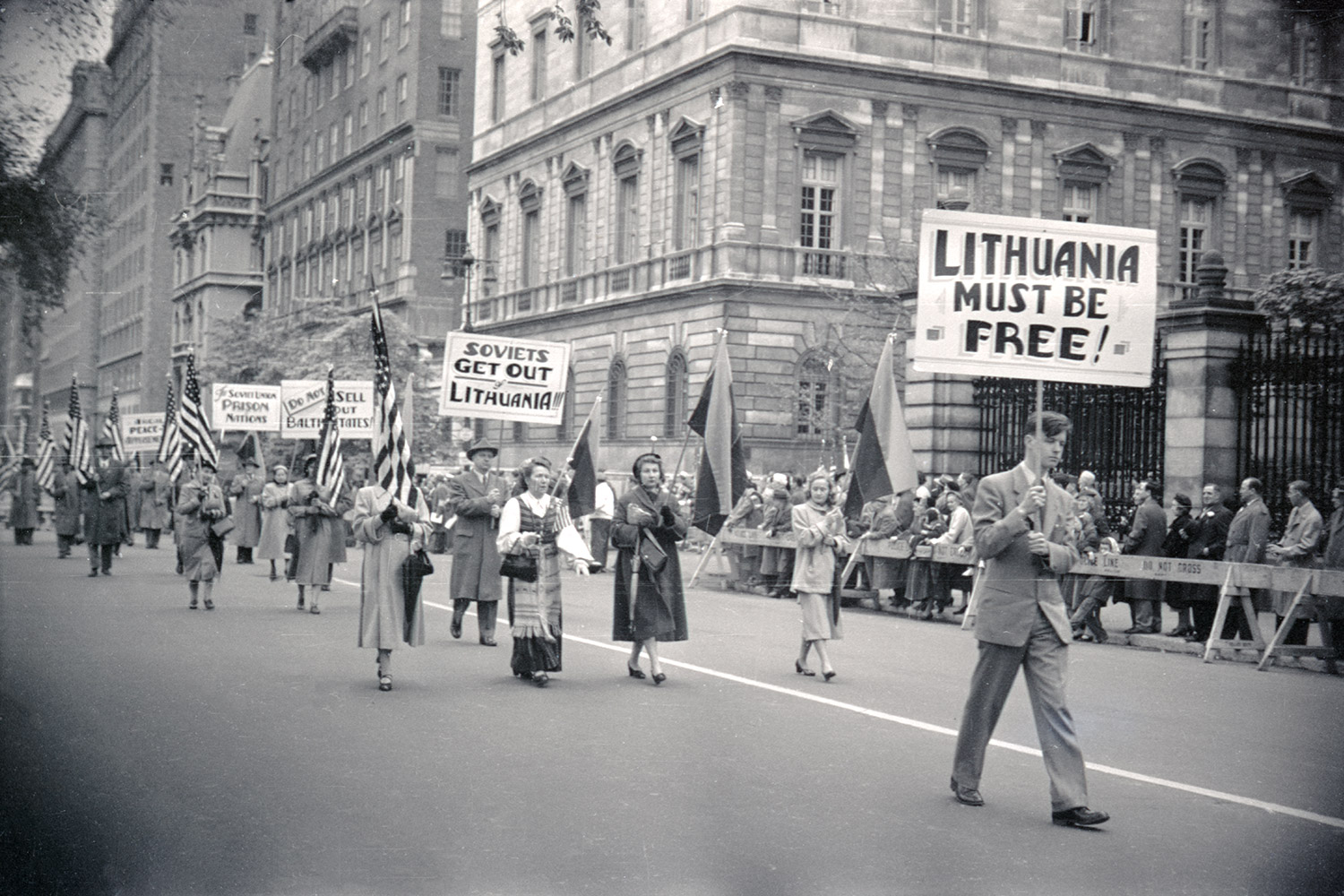 1953 – New York, USA. A group from the Lithuanian American community at the Loyalty Day parade. In the first row, Kęstutis Trimakas holds a poster, next to him – the Chairman of the American Lithuanian Council of New York, organiser of the parade’s Lithuanian group, publicist and lawyer Steponas Briedis. LVCA, photographer: G. Penikas.
1953 – New York, USA. A group from the Lithuanian American community at the Loyalty Day parade. In the first row, Kęstutis Trimakas holds a poster, next to him – the Chairman of the American Lithuanian Council of New York, organiser of the parade’s Lithuanian group, publicist and lawyer Steponas Briedis. LVCA, photographer: G. Penikas. -
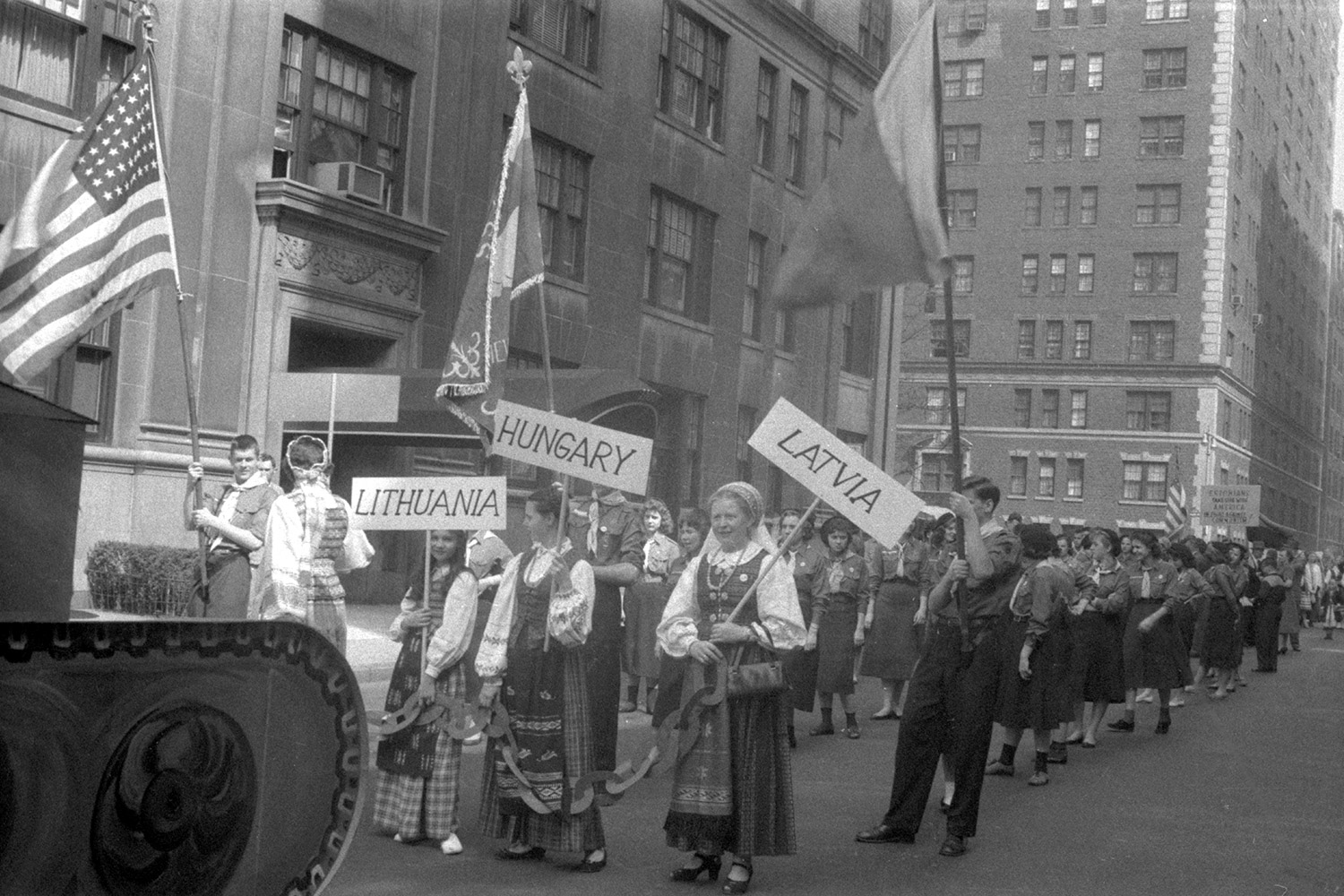 1957 – New York, USA. Members of the Lithuanian American community and Lithuanian youth organisations at the Loyalty Day parade. LVCA, photographer: G. Penikas.
1957 – New York, USA. Members of the Lithuanian American community and Lithuanian youth organisations at the Loyalty Day parade. LVCA, photographer: G. Penikas. -
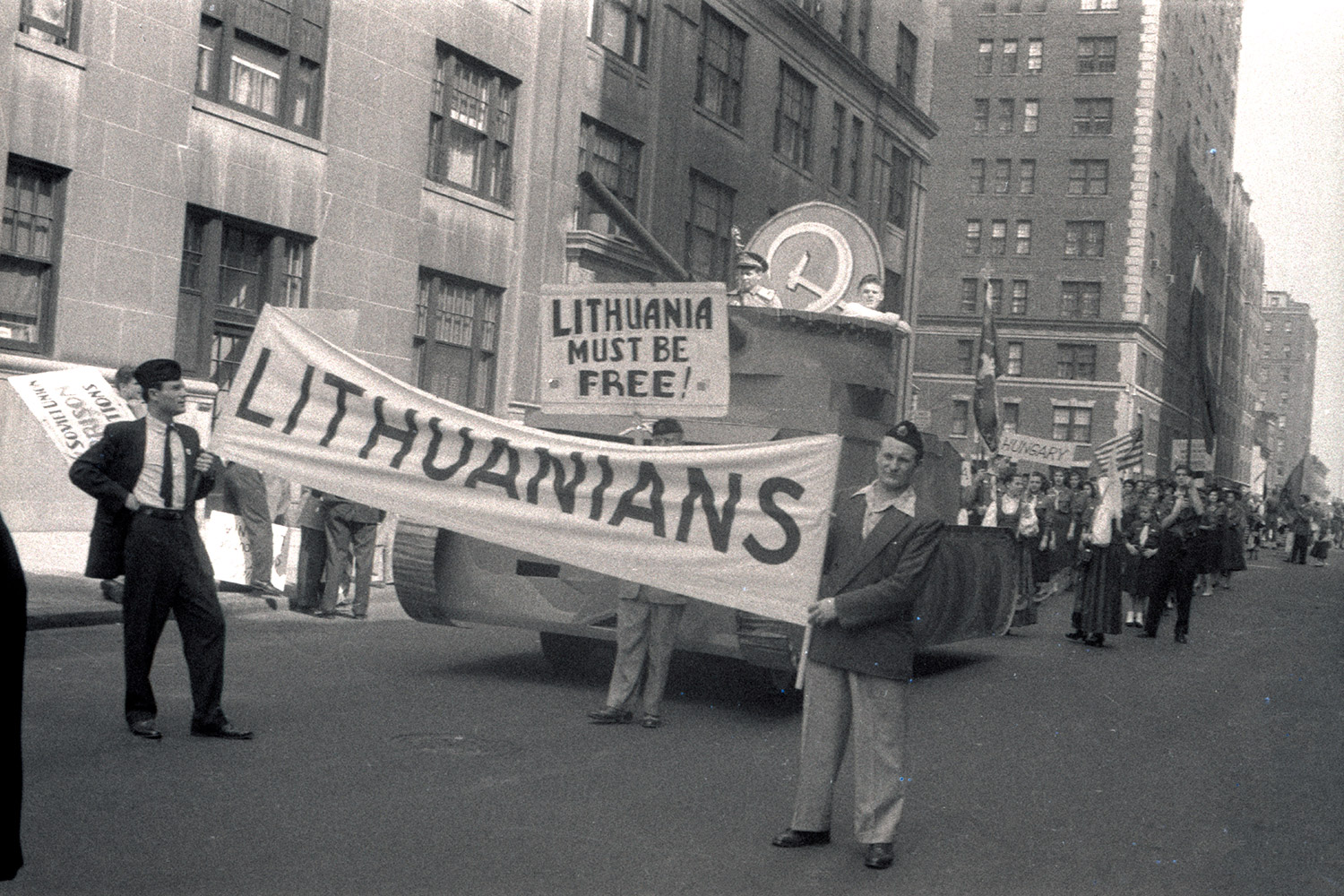 1957 – New York, USA. Members of the Lithuanian American community and Lithuanian youth organisations at the Loyalty Day parade protest against Lithuania’s occupation and annexation by the Soviets. Soviet tank built by Scouts and the Lithuanian National Union of Students (hereinafter – LSS). LVCA, photographer G. Penikas.
1957 – New York, USA. Members of the Lithuanian American community and Lithuanian youth organisations at the Loyalty Day parade protest against Lithuania’s occupation and annexation by the Soviets. Soviet tank built by Scouts and the Lithuanian National Union of Students (hereinafter – LSS). LVCA, photographer G. Penikas. -
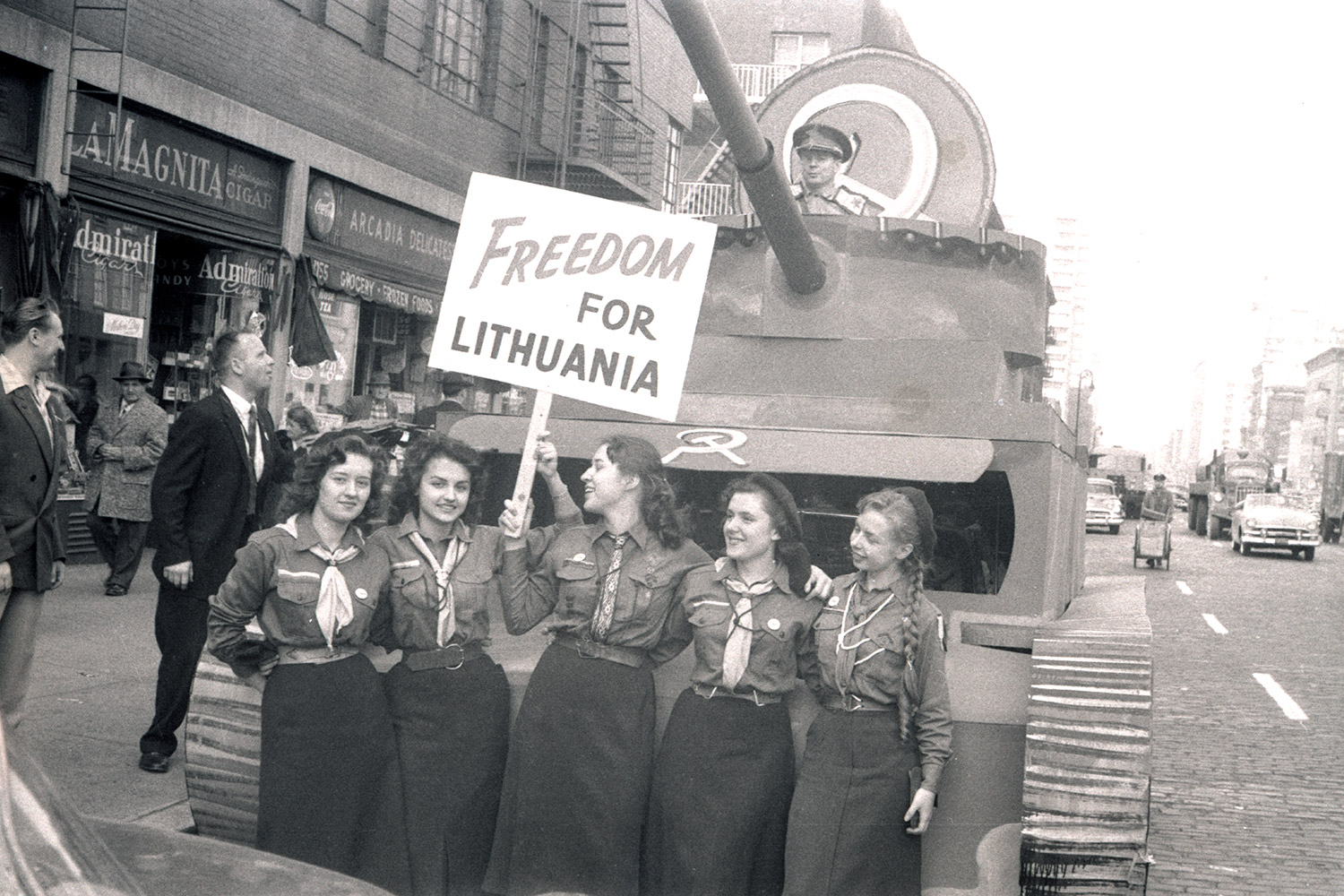 1957 – New York, USA. Members of the Lithuanian American community and Lithuanian youth organisations at the Loyalty Day parade protest against Lithuania’s occupation and annexation by the Soviets. Soviet tank built by Scouts and the LSS. LVCA, photographer: G. Penikas.
1957 – New York, USA. Members of the Lithuanian American community and Lithuanian youth organisations at the Loyalty Day parade protest against Lithuania’s occupation and annexation by the Soviets. Soviet tank built by Scouts and the LSS. LVCA, photographer: G. Penikas. -
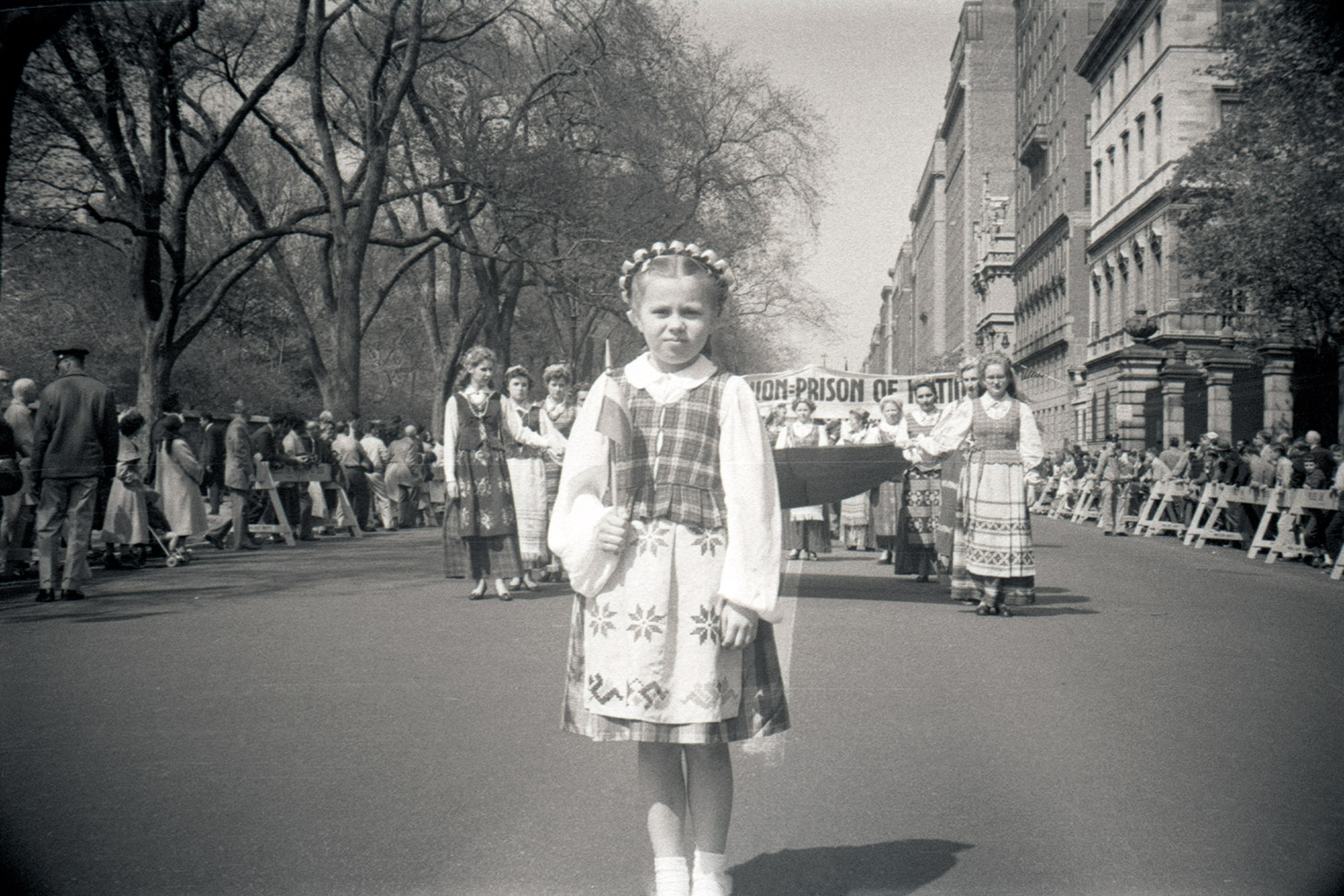 1957 – New York, USA. Members of the Lithuanian American community at the Loyalty Day parade. Lithuanian girl in national costume. LVCA, photographer: G. Penikas.
1957 – New York, USA. Members of the Lithuanian American community at the Loyalty Day parade. Lithuanian girl in national costume. LVCA, photographer: G. Penikas. -
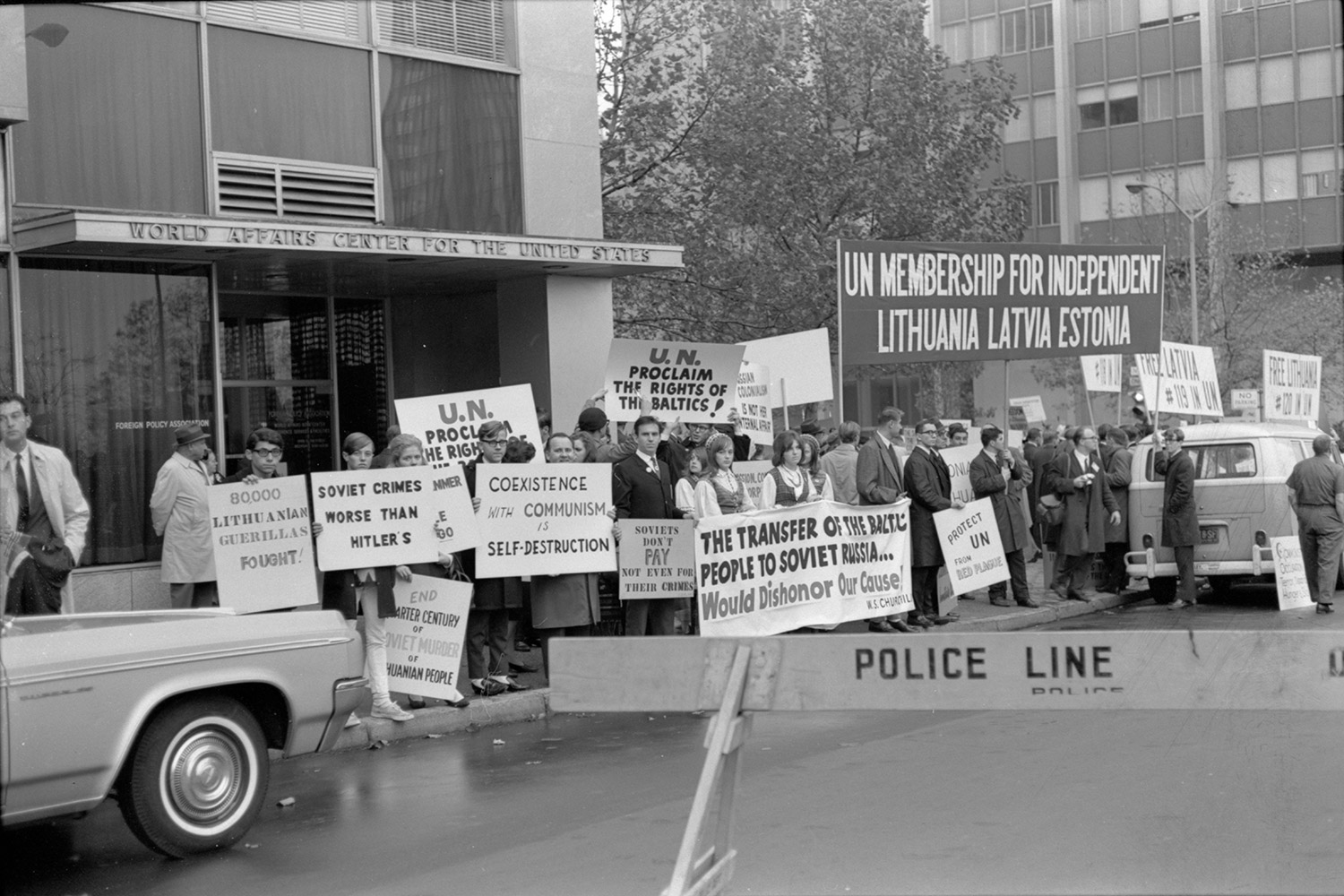 1965 – New York, USA. Manifesto of representatives of the Baltic States against the occupation/annexation by the Soviet Union: demanding the freedom and independence of Lithuania, Latvia, and Estonia. LVCA, photographer: J. Garla.
1965 – New York, USA. Manifesto of representatives of the Baltic States against the occupation/annexation by the Soviet Union: demanding the freedom and independence of Lithuania, Latvia, and Estonia. LVCA, photographer: J. Garla. -
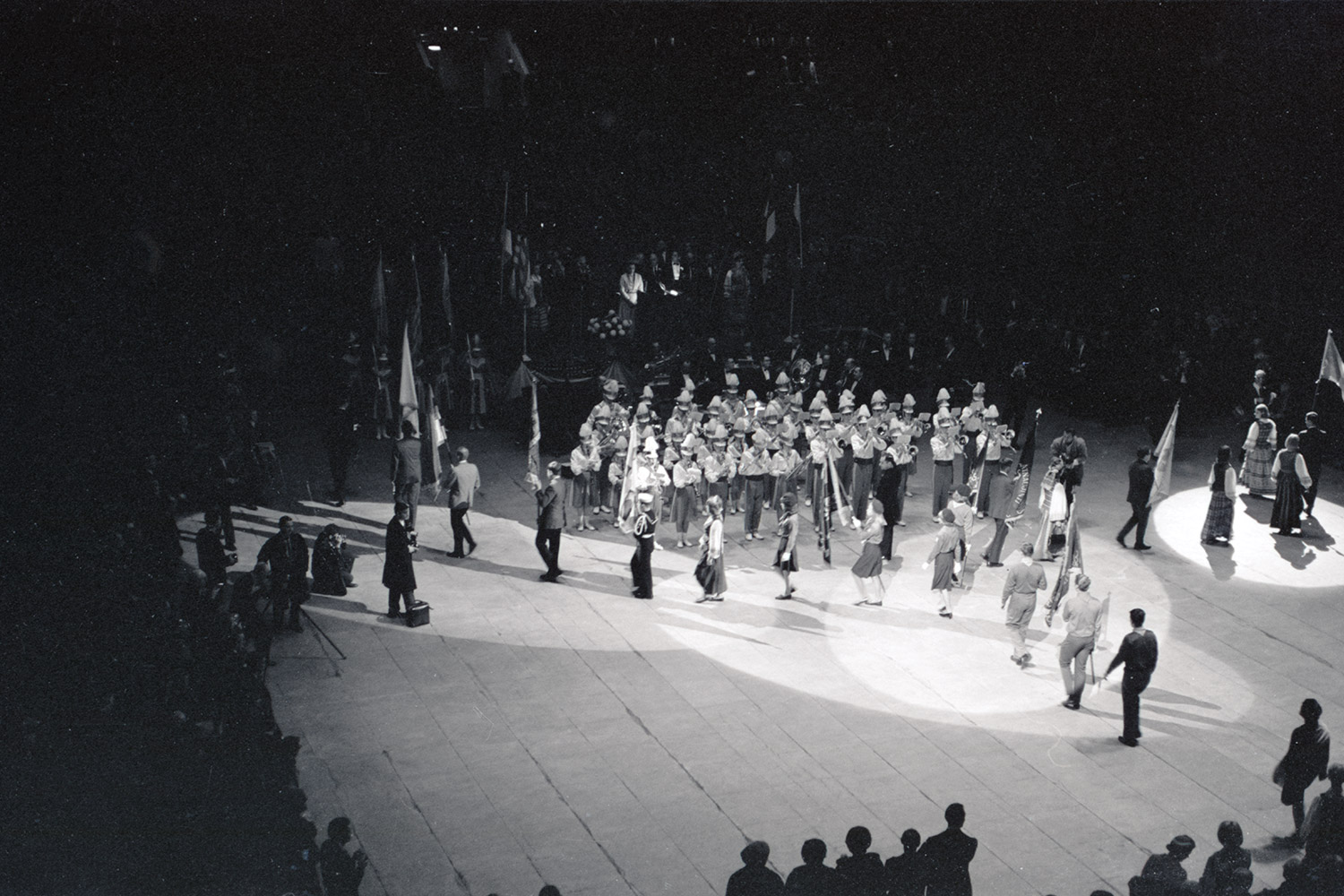 1965 – New York, USA. Manifesto of representatives of the Baltic States at the United Nations against USSR policy in the Baltic States, demanding freedom for Lithuania, Latvia, and Estonia. Ten young Scouts from the Baltic States protest in the United Nations Security Council meeting room. LVCA, photographer: J. Garla.
1965 – New York, USA. Manifesto of representatives of the Baltic States at the United Nations against USSR policy in the Baltic States, demanding freedom for Lithuania, Latvia, and Estonia. Ten young Scouts from the Baltic States protest in the United Nations Security Council meeting room. LVCA, photographer: J. Garla. -
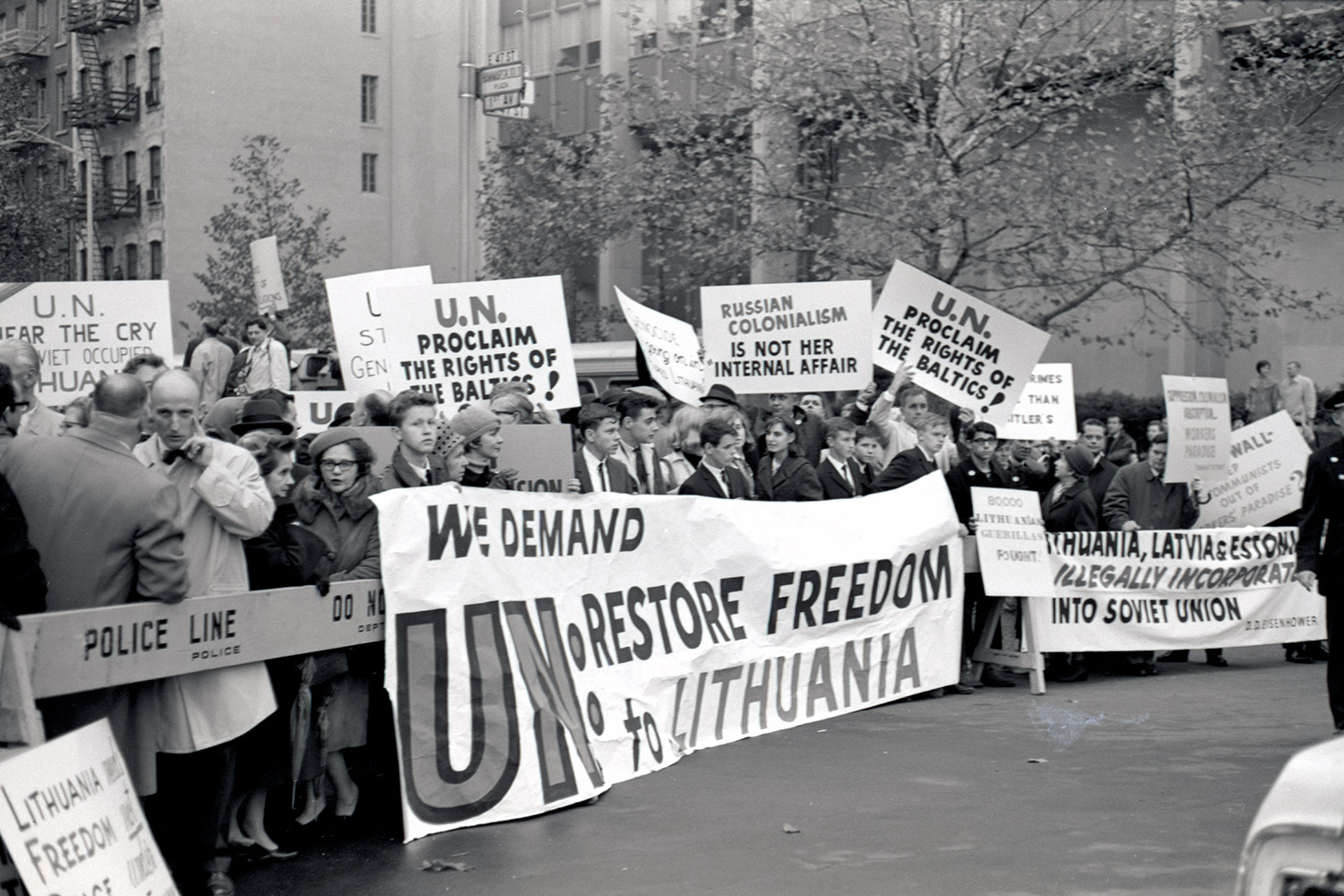 1965 – New York, USA. Manifesto of freedom by representatives of the Baltic States and protest against the actions of the Soviet Union in Lithuania, Latvia, and Estonia. LVCA, photographer: J. Garla.
1965 – New York, USA. Manifesto of freedom by representatives of the Baltic States and protest against the actions of the Soviet Union in Lithuania, Latvia, and Estonia. LVCA, photographer: J. Garla. -
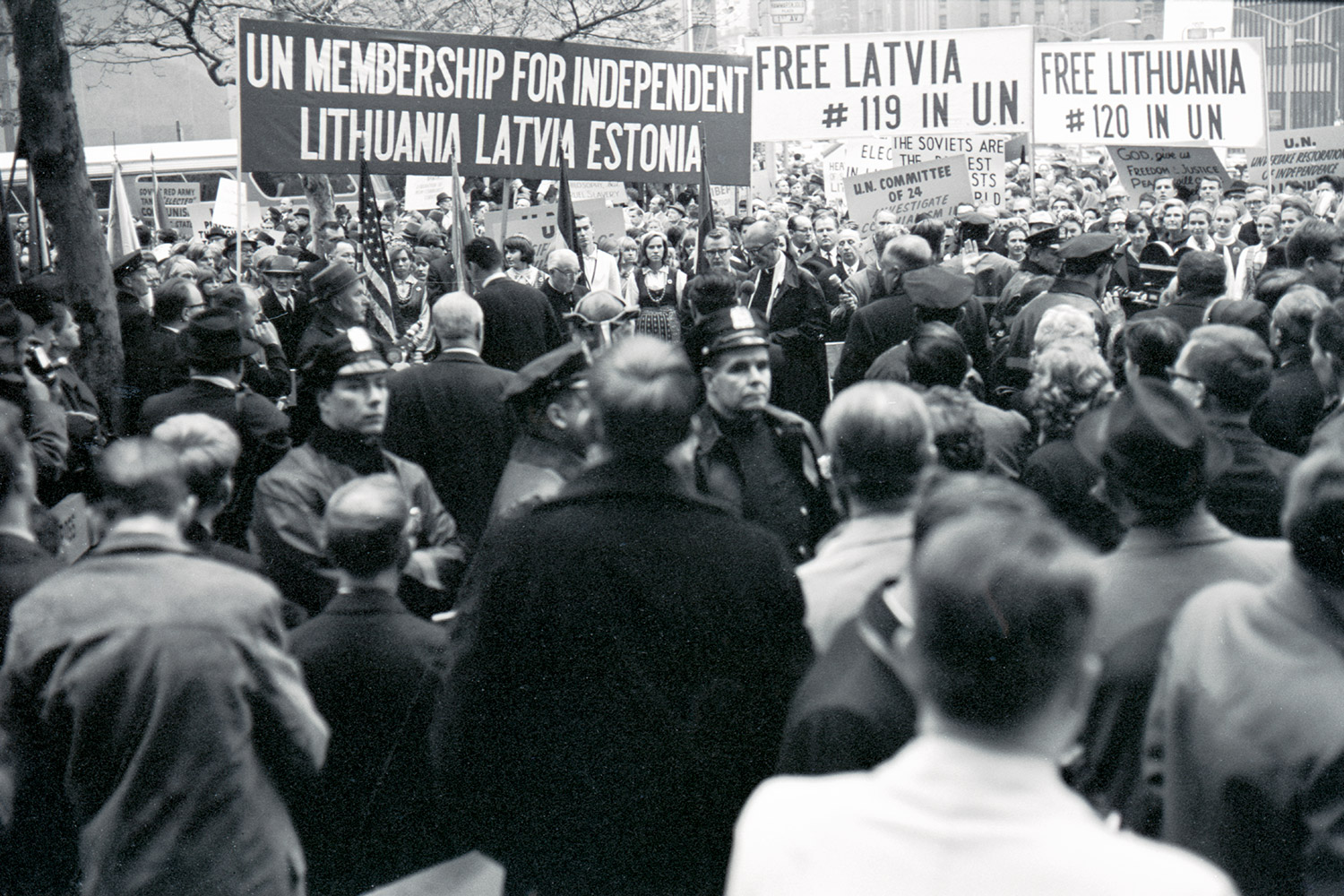 1965 – New York, USA. Manifesto of the representatives of the Baltic States, demanding freedom for Lithuania, Latvia and Estonia. LVCA, photographer: J. Garla.
1965 – New York, USA. Manifesto of the representatives of the Baltic States, demanding freedom for Lithuania, Latvia and Estonia. LVCA, photographer: J. Garla. -
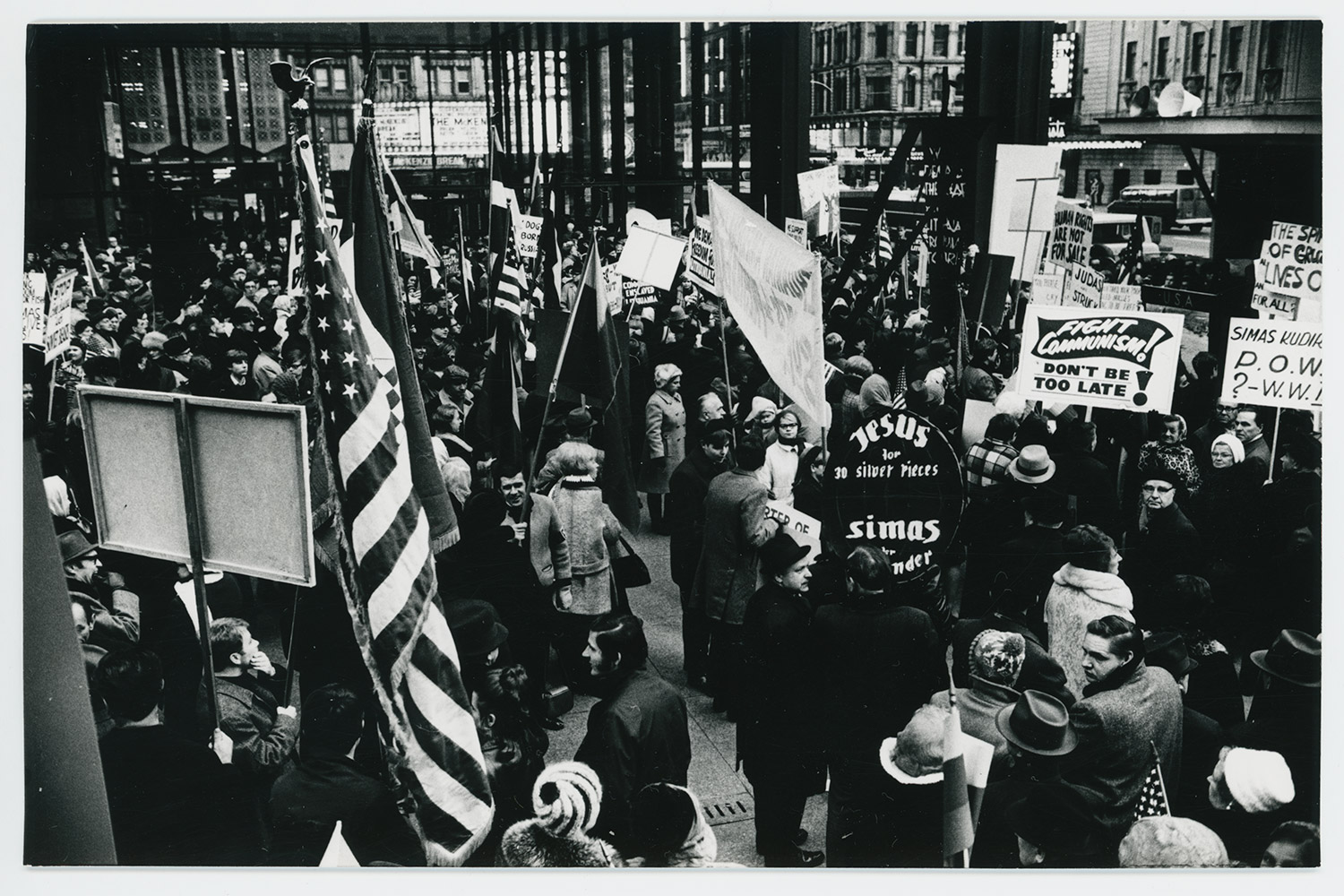 1972 – Protest rally against the US administration, which extradited political refugee Simas Kudirka back to the Soviet Union. LCVA.
1972 – Protest rally against the US administration, which extradited political refugee Simas Kudirka back to the Soviet Union. LCVA. -
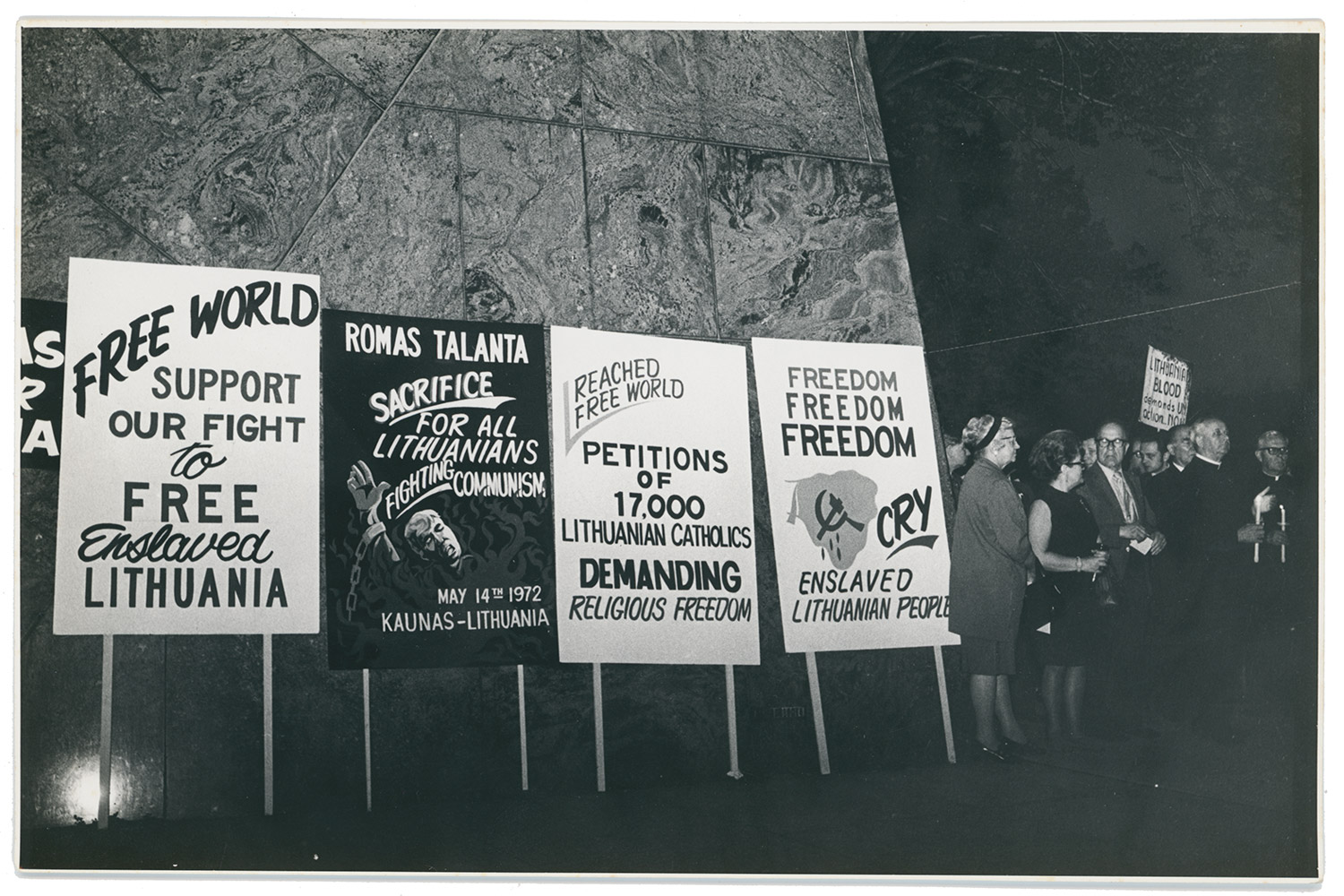 1972 – Chicago, USA. Protest rally in Marquette Park, dedicated to honouring Romas Kalanta and condemning the Soviet occupation regime in Lithuania. First from left – Lithuanian Honorary Consul General in Chicago, Juzefa Daužvardienė, on the right – Bishop Vincentas Brizgys and priest Adolfas Stašys. LVCA, photographer: V. Noreika.
1972 – Chicago, USA. Protest rally in Marquette Park, dedicated to honouring Romas Kalanta and condemning the Soviet occupation regime in Lithuania. First from left – Lithuanian Honorary Consul General in Chicago, Juzefa Daužvardienė, on the right – Bishop Vincentas Brizgys and priest Adolfas Stašys. LVCA, photographer: V. Noreika. -
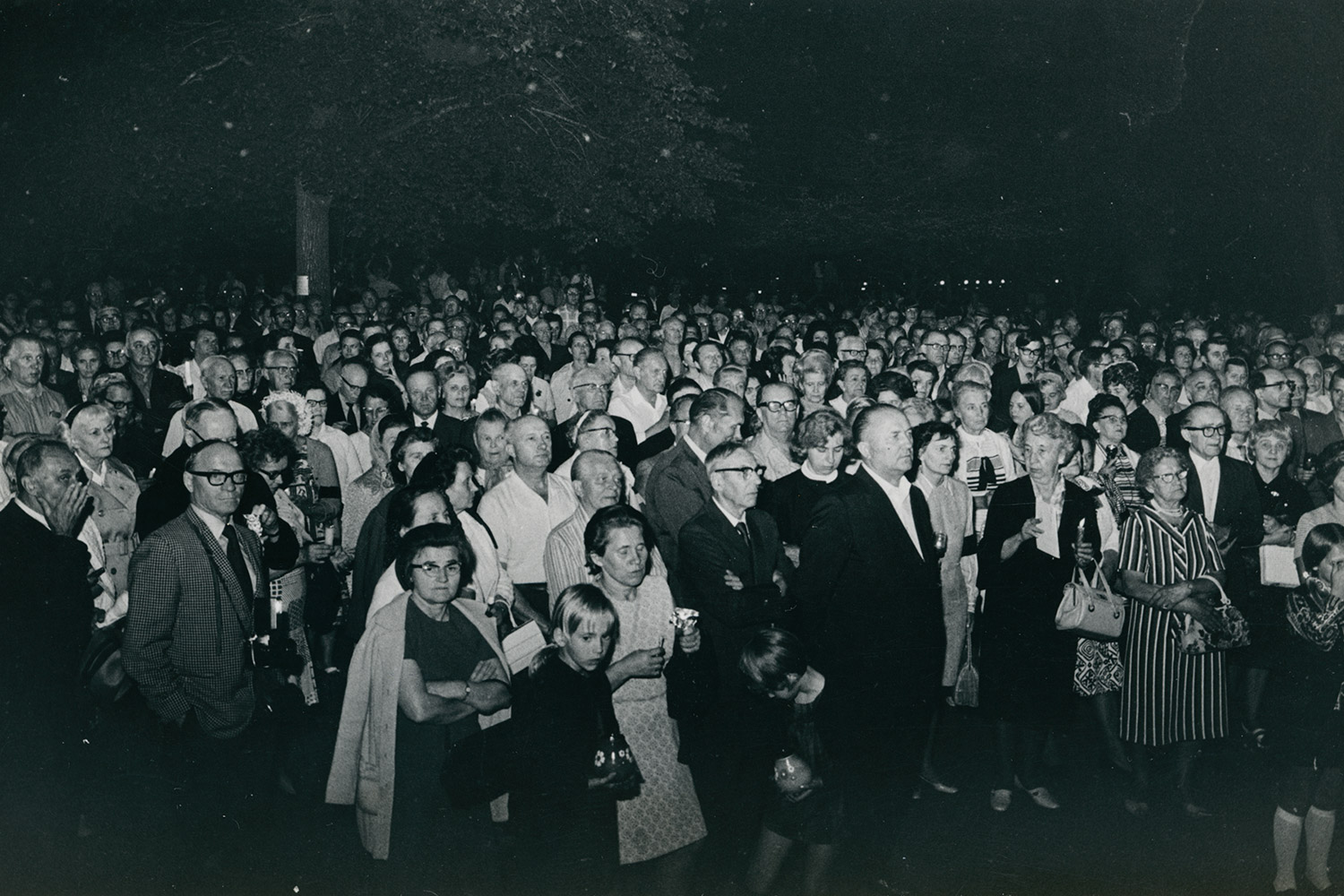 1972 – Chicago, USA. Mass protest rally at Marquette Park, honouring the sacrifice of Romas Kalanta and condemning the Soviet occupation regime. LVCA, photographer: V. Noreika.
1972 – Chicago, USA. Mass protest rally at Marquette Park, honouring the sacrifice of Romas Kalanta and condemning the Soviet occupation regime. LVCA, photographer: V. Noreika. -
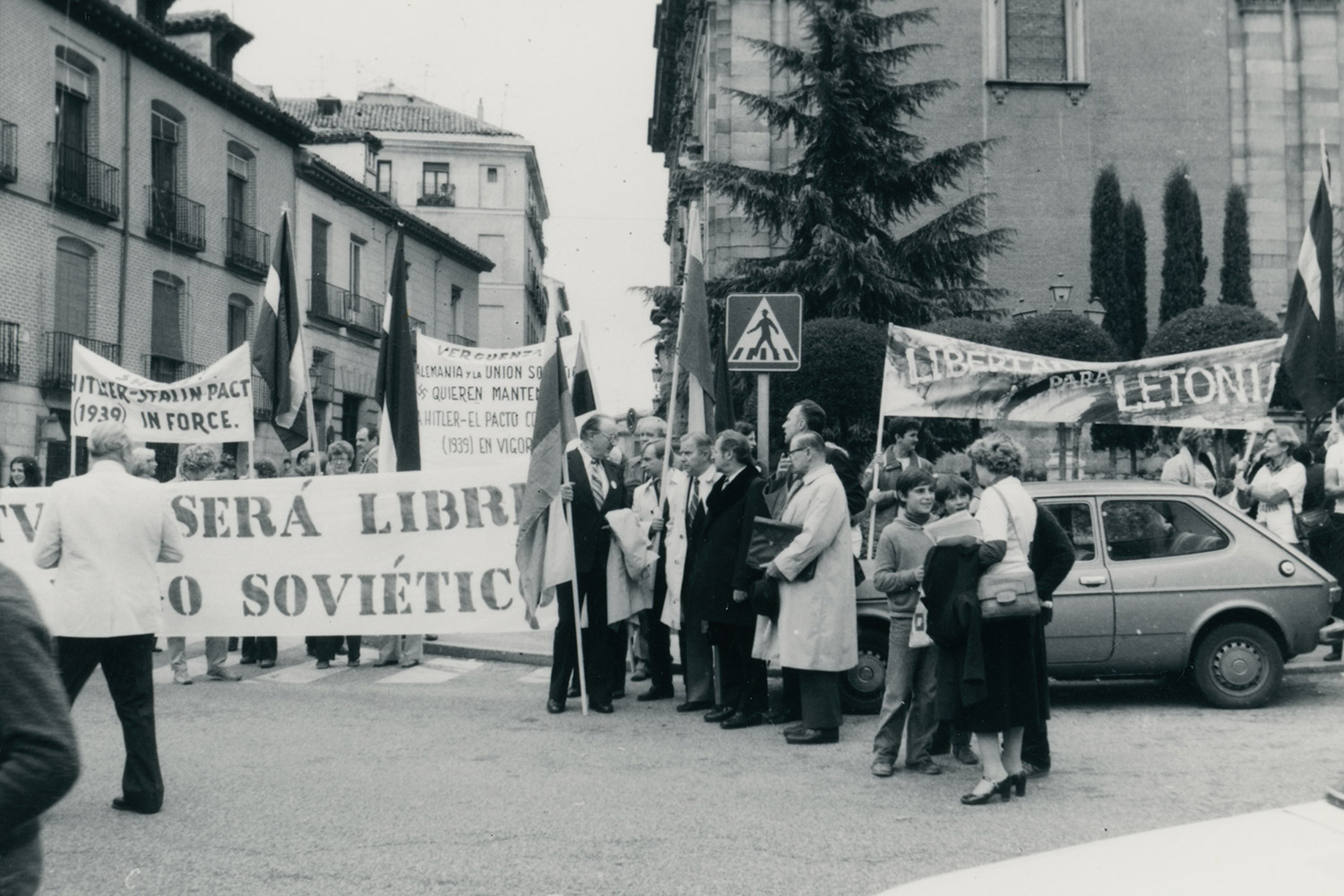 1980 – Madrid, Spain. A demonstration organised by political expatriates of the Baltic States during the Conference on Security and Cooperation in Europe in Madrid. In the middle: Mykolas Vaidyla (member of the American Lithuanian Council and editor of Santara), Vladas Šakalys (member of the resistance, who fled from the USSR), Dr Kazys Bobelis (Chairman of the Board of the Supreme Committee for the Liberation of Lithuania, hereinafter – VLIK), Dr Jonas Genys (correspondent of the National Republican Heritage Groups (Nationalities) Council, representative of the American Lithuanian Council, hereinafter – ALT), Dr Kostas Jurgėla (Director of the Lithuanian division of Voice of America), Aleksandras Mičiūdas (representative of VLIK in Argentina). LVCA.
1980 – Madrid, Spain. A demonstration organised by political expatriates of the Baltic States during the Conference on Security and Cooperation in Europe in Madrid. In the middle: Mykolas Vaidyla (member of the American Lithuanian Council and editor of Santara), Vladas Šakalys (member of the resistance, who fled from the USSR), Dr Kazys Bobelis (Chairman of the Board of the Supreme Committee for the Liberation of Lithuania, hereinafter – VLIK), Dr Jonas Genys (correspondent of the National Republican Heritage Groups (Nationalities) Council, representative of the American Lithuanian Council, hereinafter – ALT), Dr Kostas Jurgėla (Director of the Lithuanian division of Voice of America), Aleksandras Mičiūdas (representative of VLIK in Argentina). LVCA. -
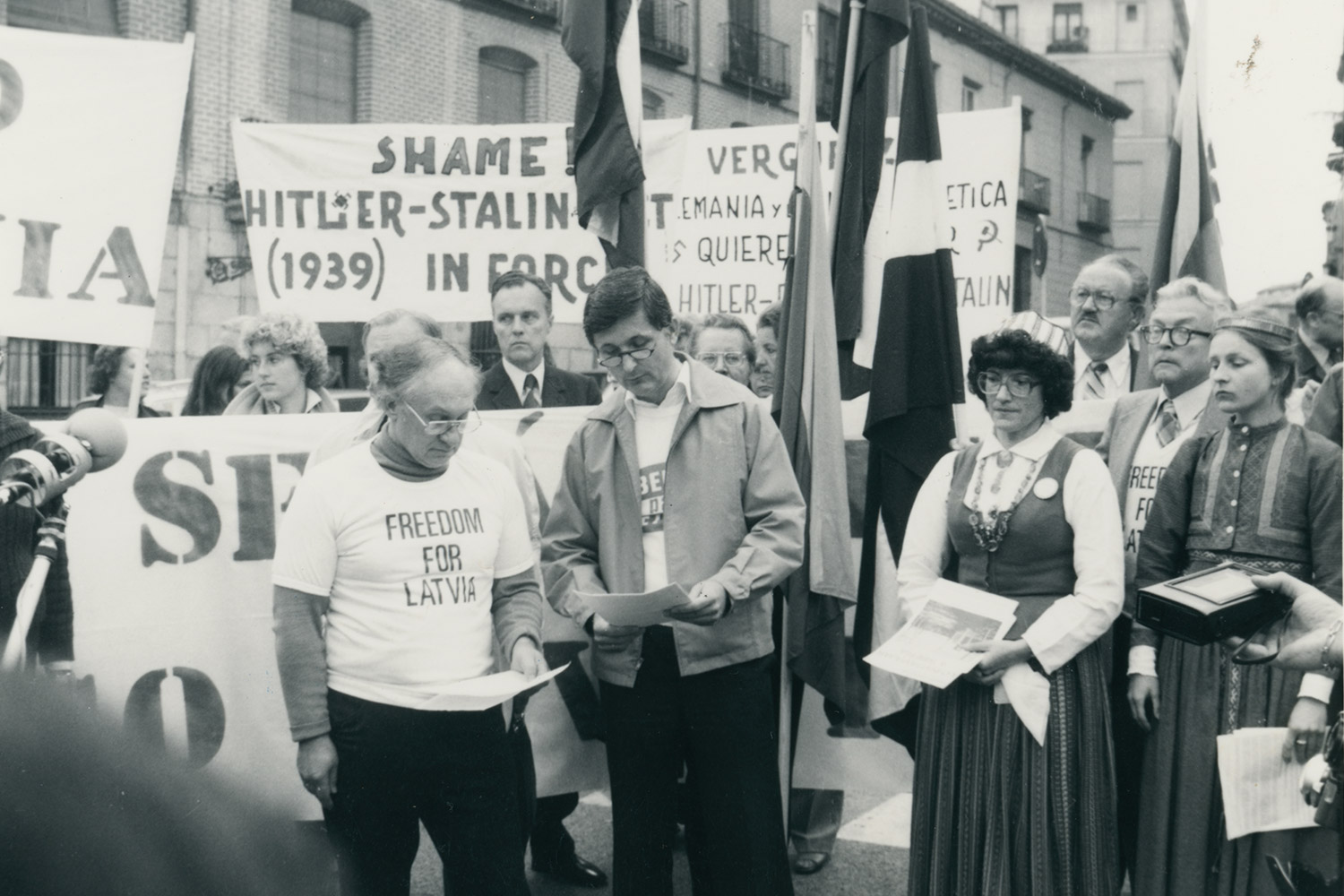 1980 – Madrid, Spain. Political demonstration organised by political expatriates of the Baltic States in Madrid during the Conference on Security and Cooperation in Europe. LVCA.
1980 – Madrid, Spain. Political demonstration organised by political expatriates of the Baltic States in Madrid during the Conference on Security and Cooperation in Europe. LVCA. -
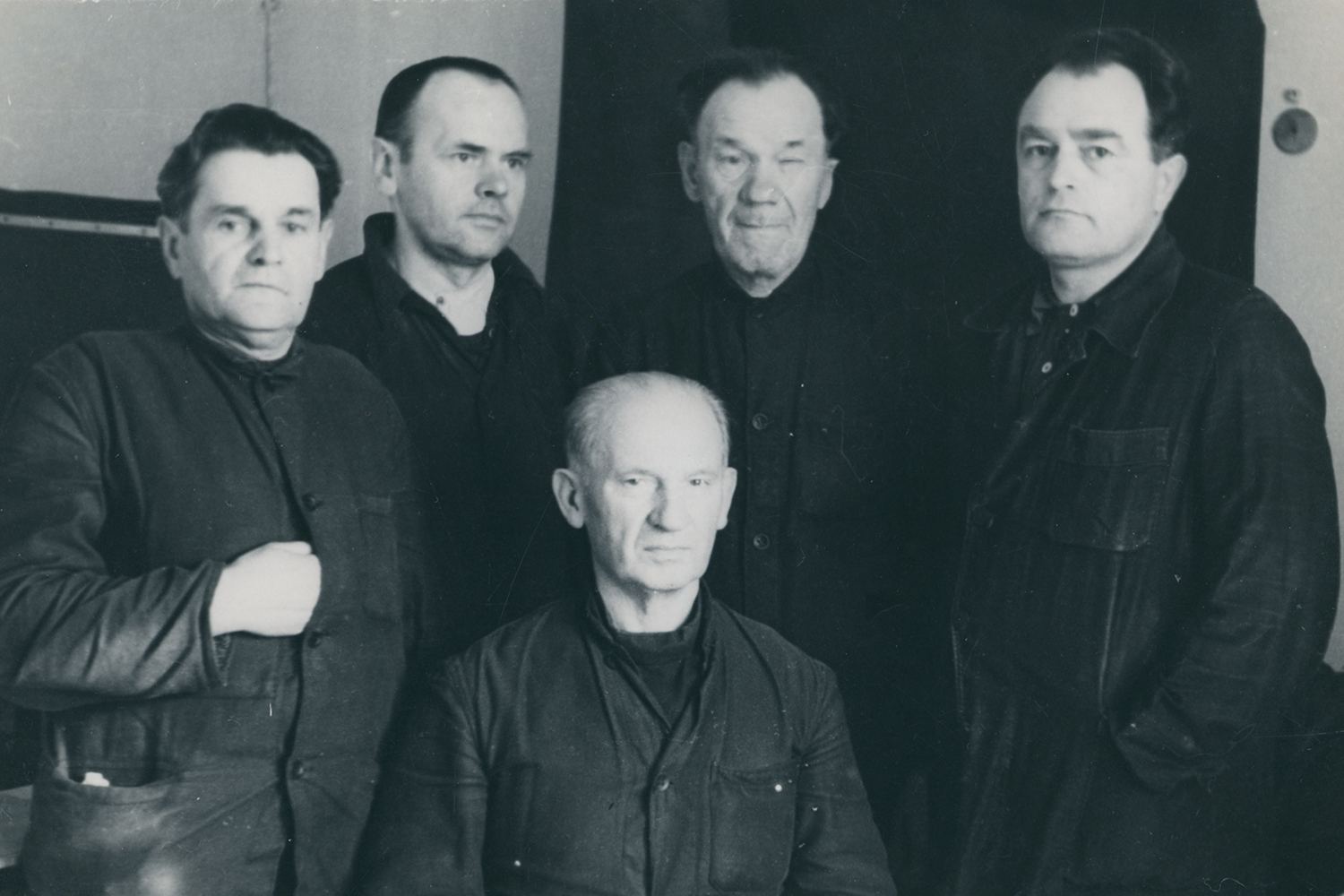 1980 – Abez, Komi Republic. Lithuanian priests, fighting for Lithuanian identity and against Bolshevism, at the Pechora labour camp. Standing: Tadas Budraitis, Vaitelis, Jonušas, Jokubauskas; sitting: Telšiai Bishop, Doctor of Theology, Professor Pranciškus Ramanauskas. LVCA.
1980 – Abez, Komi Republic. Lithuanian priests, fighting for Lithuanian identity and against Bolshevism, at the Pechora labour camp. Standing: Tadas Budraitis, Vaitelis, Jonušas, Jokubauskas; sitting: Telšiai Bishop, Doctor of Theology, Professor Pranciškus Ramanauskas. LVCA. -
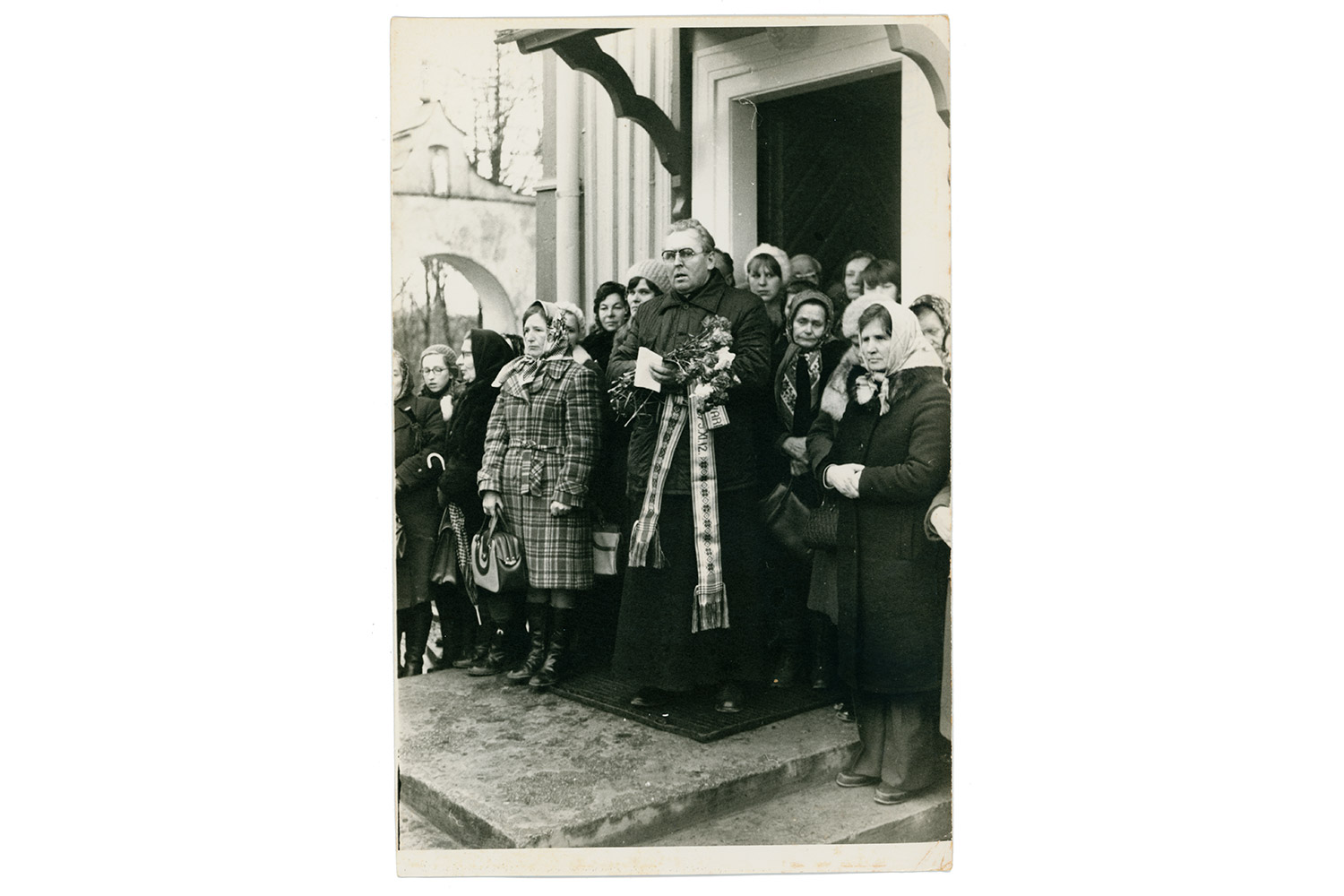 Viduklė, Raseiniai d. Priest, fighter against Soviet occupation, dissident Alfonsas Svarinskas (centre) with believers at the side entrance to Viduklė Church of the Holy Cross. LVCA.
Viduklė, Raseiniai d. Priest, fighter against Soviet occupation, dissident Alfonsas Svarinskas (centre) with believers at the side entrance to Viduklė Church of the Holy Cross. LVCA. -
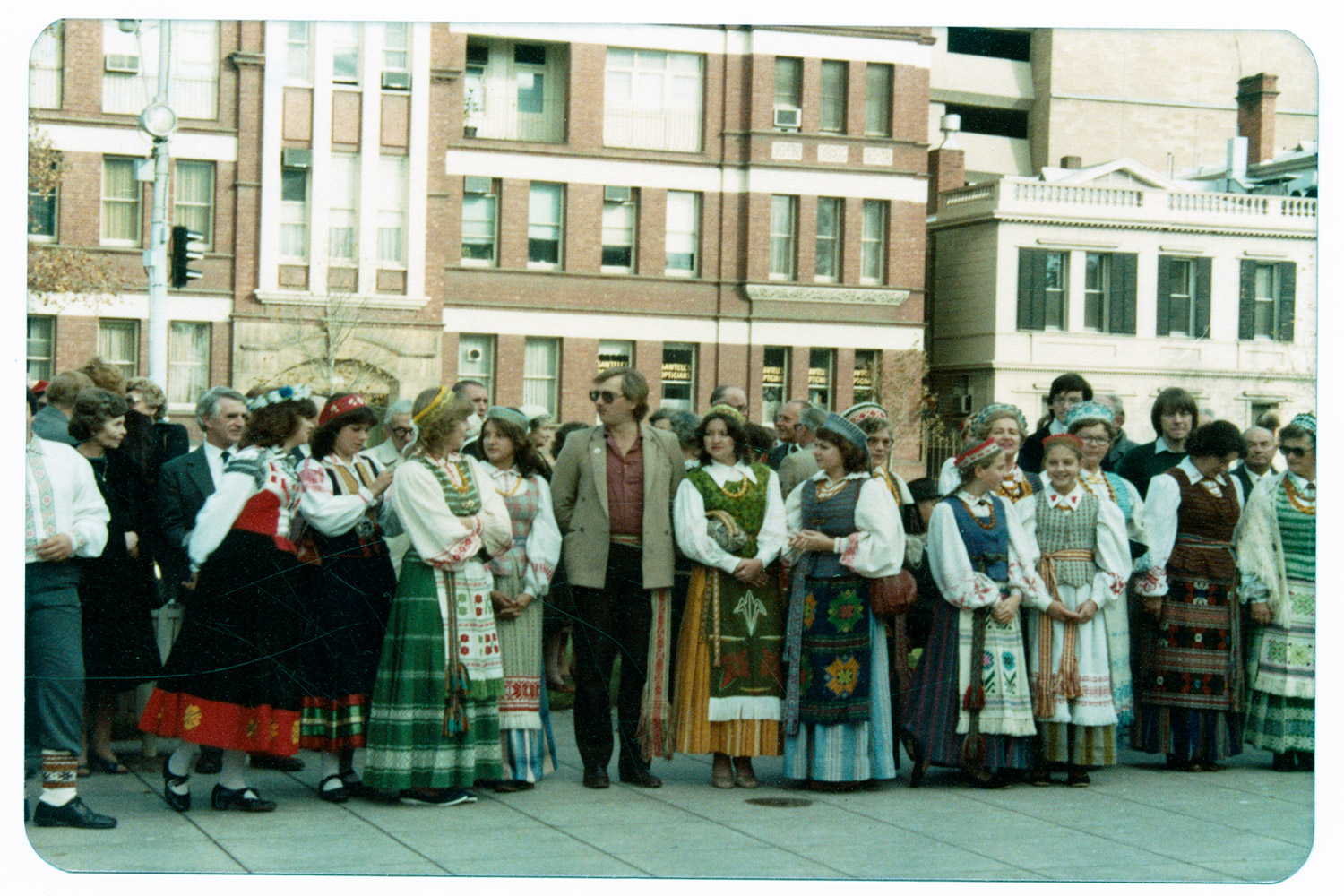 1982 – Adelaide, Australia. Australian-Lithuanian, Latvian and Estonian protests against the Soviet occupation. LVCA
1982 – Adelaide, Australia. Australian-Lithuanian, Latvian and Estonian protests against the Soviet occupation. LVCA -
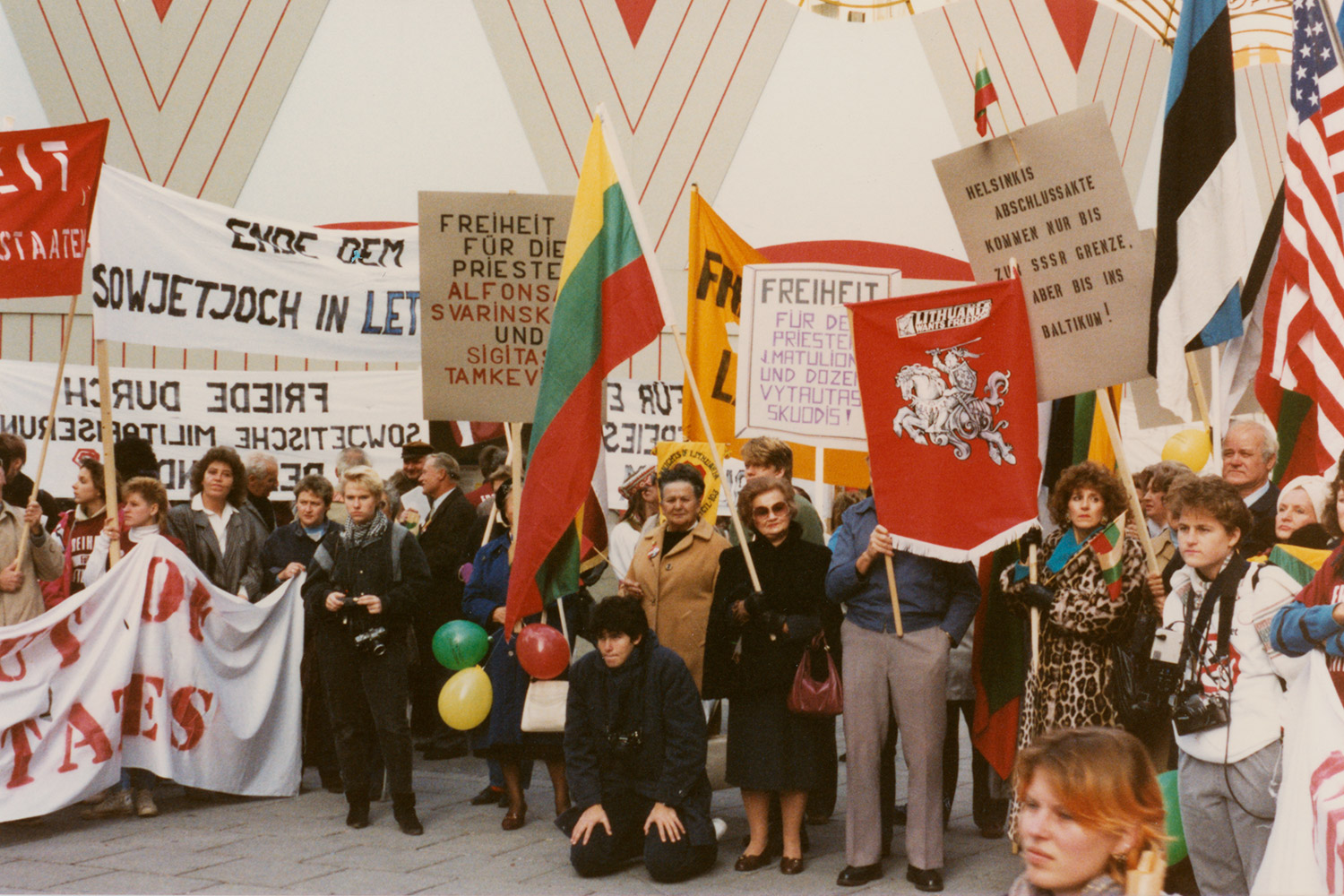 1986 – Vienna, Austria. Freedom action by representatives of the Baltic States at the start of the Conference of the Organization for Security and Cooperationin Europe (hereinafter – OSCE) in Vienna. LVCA.
1986 – Vienna, Austria. Freedom action by representatives of the Baltic States at the start of the Conference of the Organization for Security and Cooperationin Europe (hereinafter – OSCE) in Vienna. LVCA. -
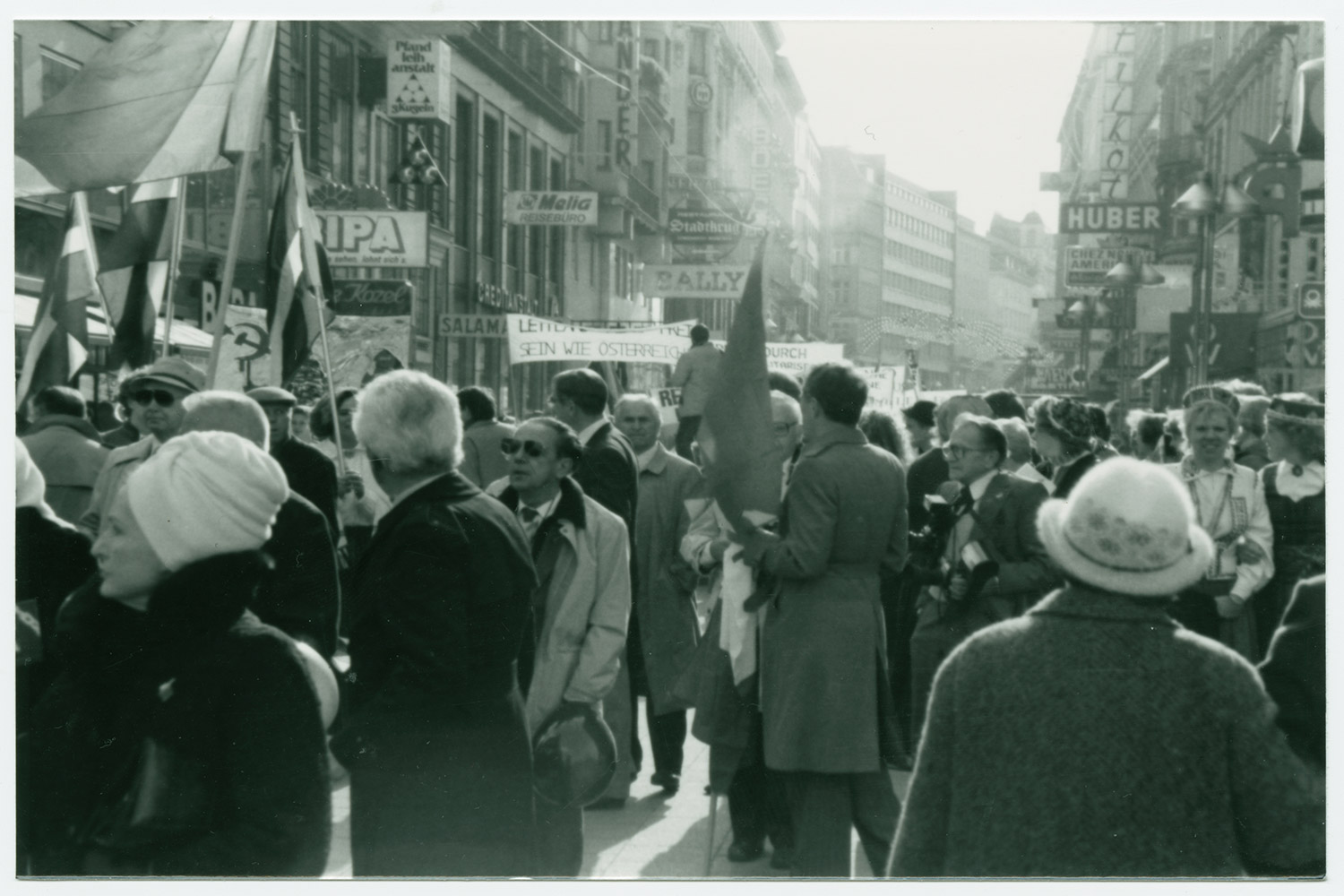 1986 – Vienna, Austria. Lithuanian, Latvian and Estonian demonstration for the freedom of the Baltic States during the OSCE Conference in Vienna. LVCA
1986 – Vienna, Austria. Lithuanian, Latvian and Estonian demonstration for the freedom of the Baltic States during the OSCE Conference in Vienna. LVCA -
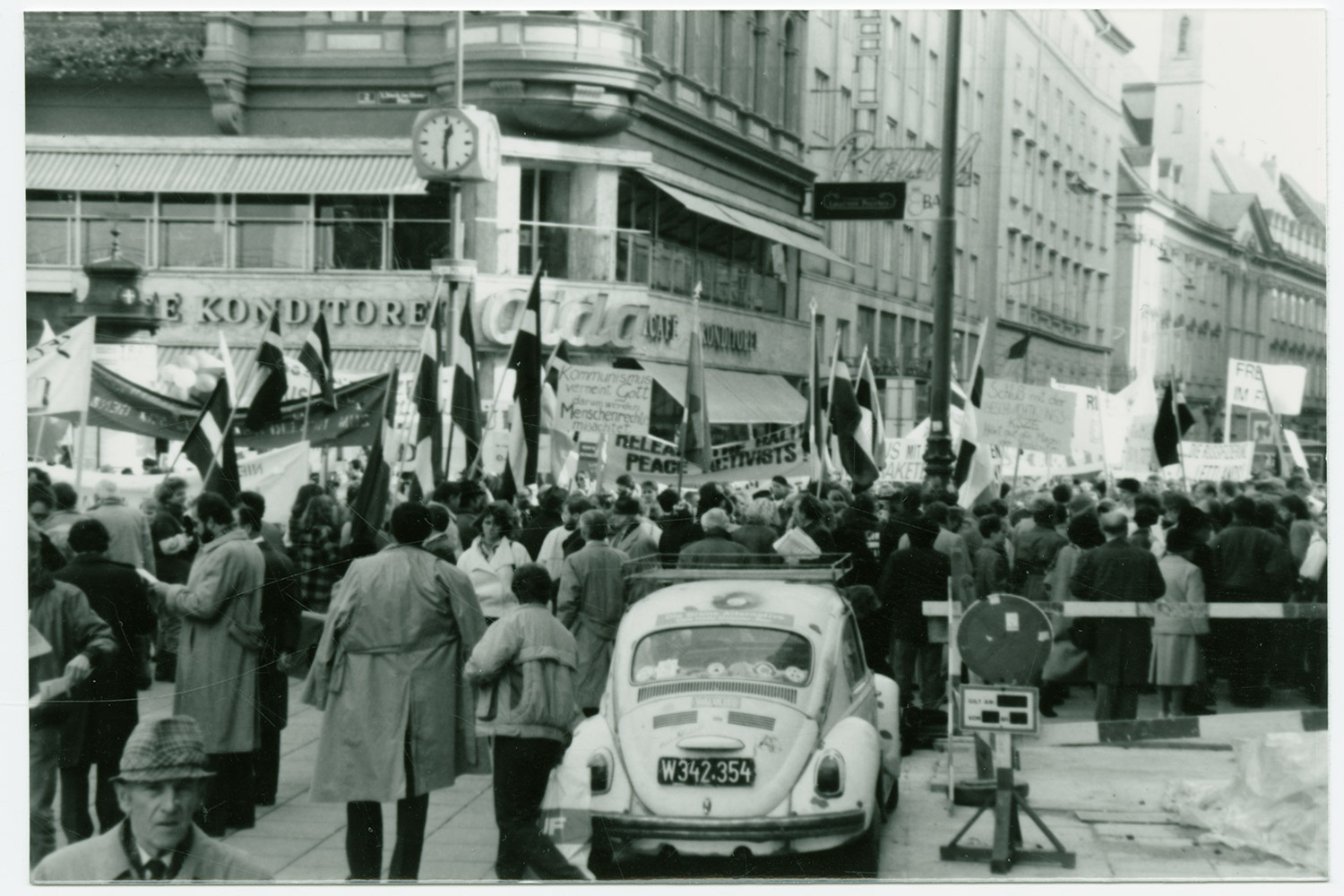 1986 – Vienna, Austria. Demonstration of the Baltic diaspora for the independence of Lithuania, Latvia and Estonia at the OSCE Conference in Vienna. LVCA.
1986 – Vienna, Austria. Demonstration of the Baltic diaspora for the independence of Lithuania, Latvia and Estonia at the OSCE Conference in Vienna. LVCA. -
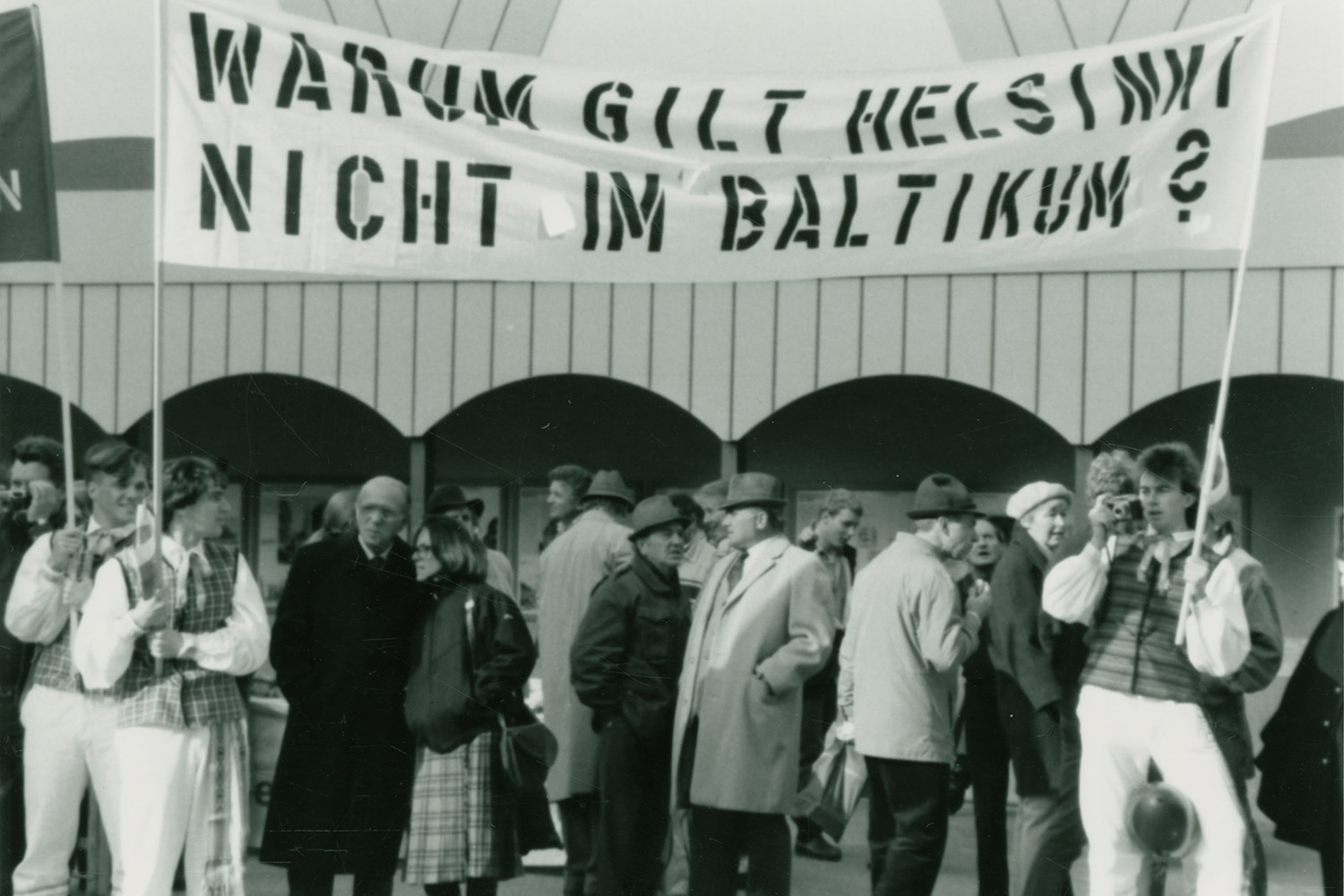 1986 – Vienna, Austria. Demonstration by political emigrants of the Baltic nations against the Soviet occupation and annexation of the Baltic States during the OSCE Conference in Vienna. LVCA.
1986 – Vienna, Austria. Demonstration by political emigrants of the Baltic nations against the Soviet occupation and annexation of the Baltic States during the OSCE Conference in Vienna. LVCA. -
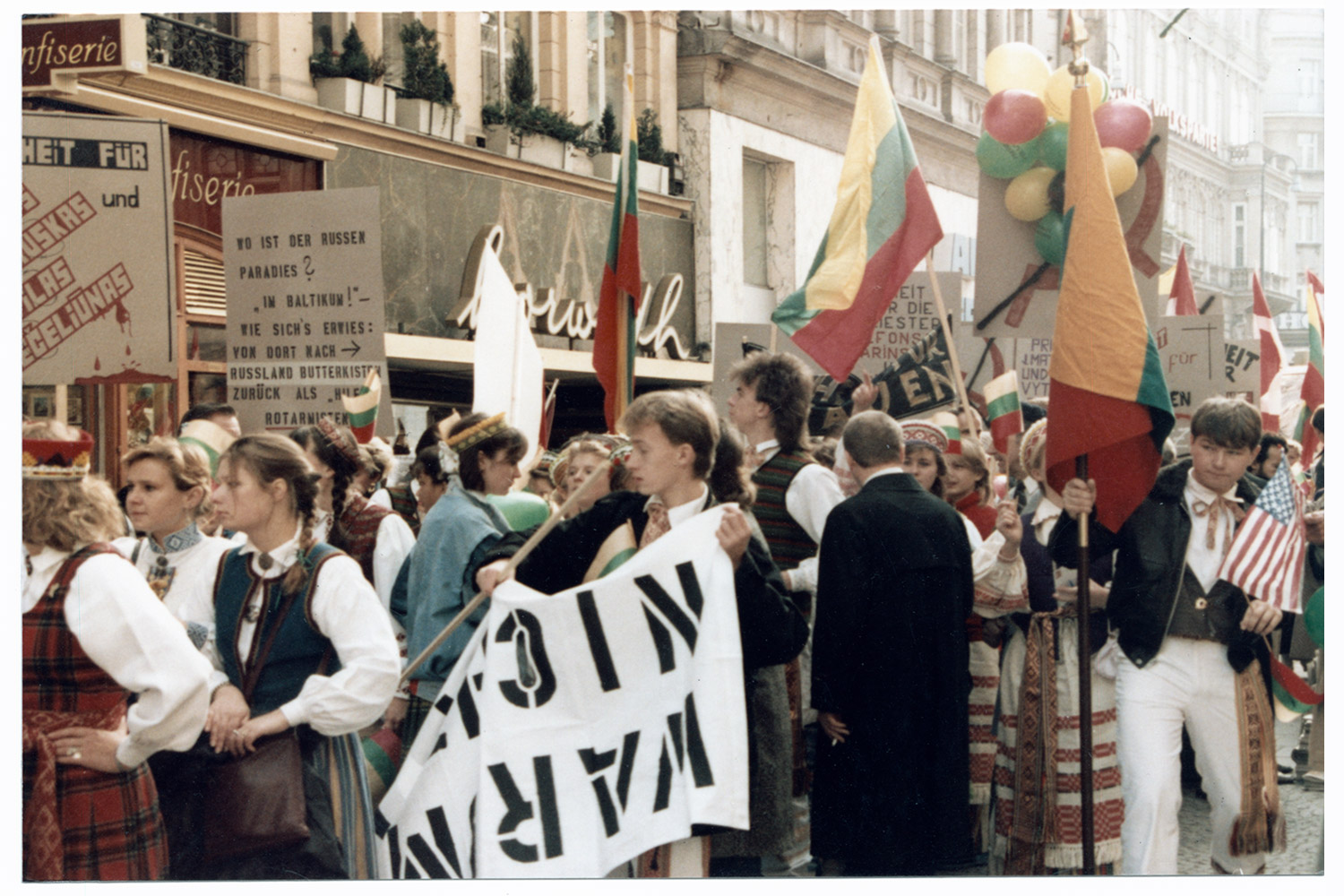 1986 – Vienna, Austria. Protest demonstration by Lithuanian, Latvian and Estonian political emigrants for the freedom of the Baltic States during the OSCE Conference in Vienna. LVCA.
1986 – Vienna, Austria. Protest demonstration by Lithuanian, Latvian and Estonian political emigrants for the freedom of the Baltic States during the OSCE Conference in Vienna. LVCA. -
 1986 – Vienna, Austria. Protest demonstration by Baltic political emigrants against the Soviet occupation and annexation of the Baltic States during the OSCE Conference in Vienna. Fourth on the left: Vytautas Jokubaitis, an American and Lithuanian public figure. LVCA.
1986 – Vienna, Austria. Protest demonstration by Baltic political emigrants against the Soviet occupation and annexation of the Baltic States during the OSCE Conference in Vienna. Fourth on the left: Vytautas Jokubaitis, an American and Lithuanian public figure. LVCA. -
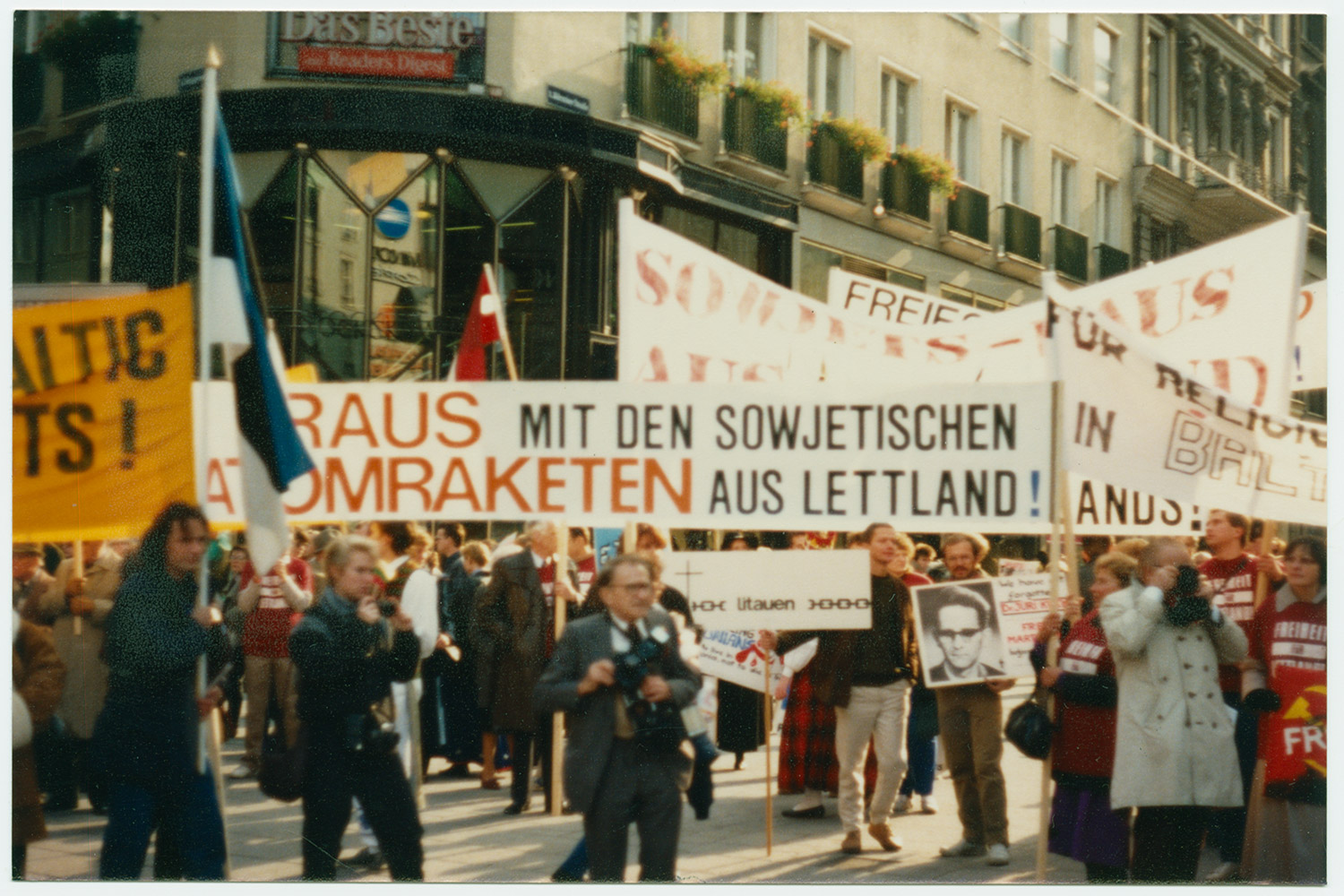 1986 – Vienna, Austria. Protest demonstration against the occupation of the Baltic States during the OSCE Conference in Vienna. Posters demanding the withdrawal of the Soviet army from the Baltic countries. LVCA.
1986 – Vienna, Austria. Protest demonstration against the occupation of the Baltic States during the OSCE Conference in Vienna. Posters demanding the withdrawal of the Soviet army from the Baltic countries. LVCA.
1987 – 1989
PROTEST RALLIES IN LITHUANIA AGAINST THE CONSEQUENCES OF THE SECRET PROTOCOLS OF THE MOLOTOV-RIBBENTROP PACT (MRP) – THE OCCUPATION AND ANNEXATION OF LITHUANIA BY THE USSR
The issue of the official recognition, condemnation, and legal evaluation of the secret protocols of the Molotov-Ribbentrop Pact in the Baltic States, annexed by the USSR, was first raised by Mikhail Gorbachev in the Soviet Union’s perestroika policy and when the screws of Soviet totalitarianism were slightly loosened. In Lithuania, the Lithuanian Liberty League, led by dissident, political prisoner Antanas Terleckas, first raised this issue.
On 23 August 1987, marking the 48th anniversary of the Pact, a public protest rally was held at the monument of the poet Adam Mickiewicz in Vilnius, protesting the consequences of the Molotov-Ribbentrop Pact – the occupation and annexation of Lithuania by the USSR.
With the formation of national liberation movements in Lithuania, Latvia and Estonia in 1988–1989, the issue of the recognition, legal evaluation, and condemnation of the existence of the secret protocols of Molotov-Ribbentrop Pact became one of the most prominent and effective leitmotivs of liberation in the three Baltic countries.
Mass protests were held in Vilnius, Riga and Tallinn on 23 August 1988. Around 200,000 people participated in the meeting organised by Sąjūdis in Vingis Park in Vilnius.
Under pressure from the Soviet government to condemn the RMP, on 23 August 1989, a more pronounced manifestation of political protest in the Baltic States took place. Vilnius, Riga and Tallinn were connected that day by the more than 600 km long Baltic Way – a living chain of people, more than a million freedom-seeking Lithuanians, Latvians and Estonians. This rocked Europe politically and was written about by the press around the world.
-
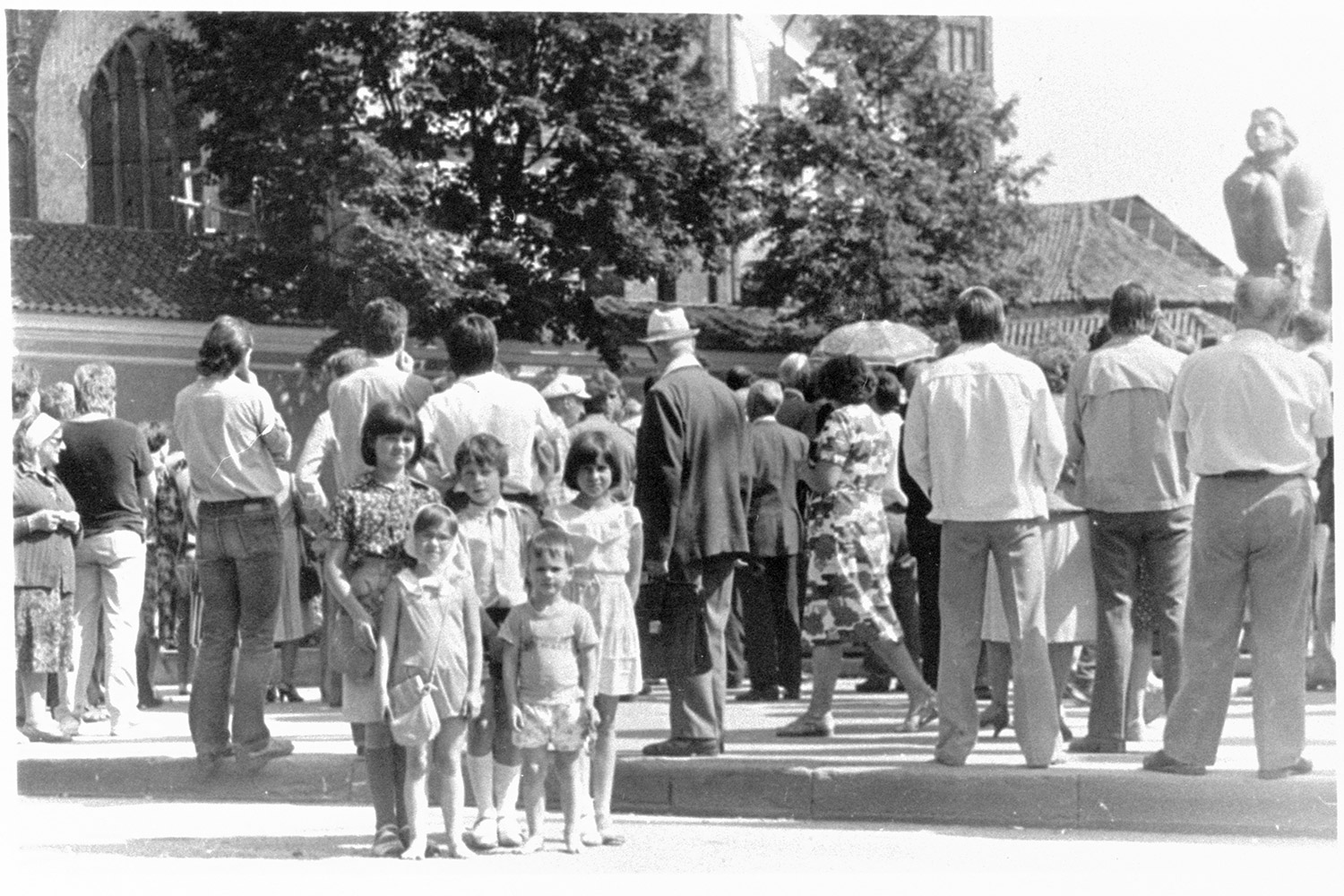 23/08/1987 – Lithuanian Liberty League (hereinafter – LLL) held an unsanctioned protest rally at the monument of Adam Mickiewicz to condemn the Molotov-Ribbentrop Pact. The children of the photographer – Romualda, Nijolė, Algimantas, Ramunė and Vytautas. LVCA, photographer: R. Lankas.
23/08/1987 – Lithuanian Liberty League (hereinafter – LLL) held an unsanctioned protest rally at the monument of Adam Mickiewicz to condemn the Molotov-Ribbentrop Pact. The children of the photographer – Romualda, Nijolė, Algimantas, Ramunė and Vytautas. LVCA, photographer: R. Lankas. -
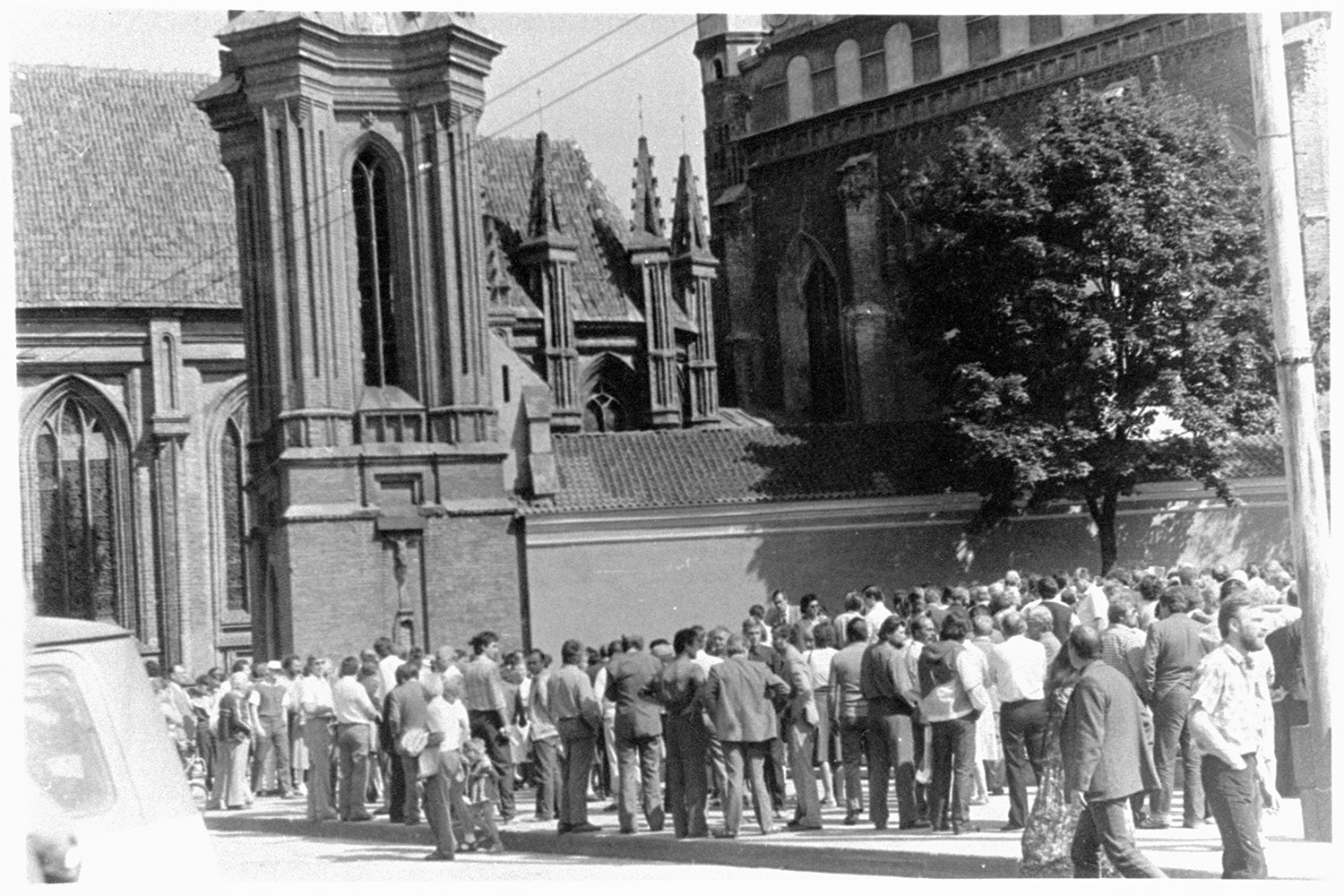 23/08/1987 – The unsanctioned LLL rally at the monument of Adam Mickiewicz to condemn the Molotov-Ribbentrop Pact. LVCA, photographer: R. Lankas.
23/08/1987 – The unsanctioned LLL rally at the monument of Adam Mickiewicz to condemn the Molotov-Ribbentrop Pact. LVCA, photographer: R. Lankas. -
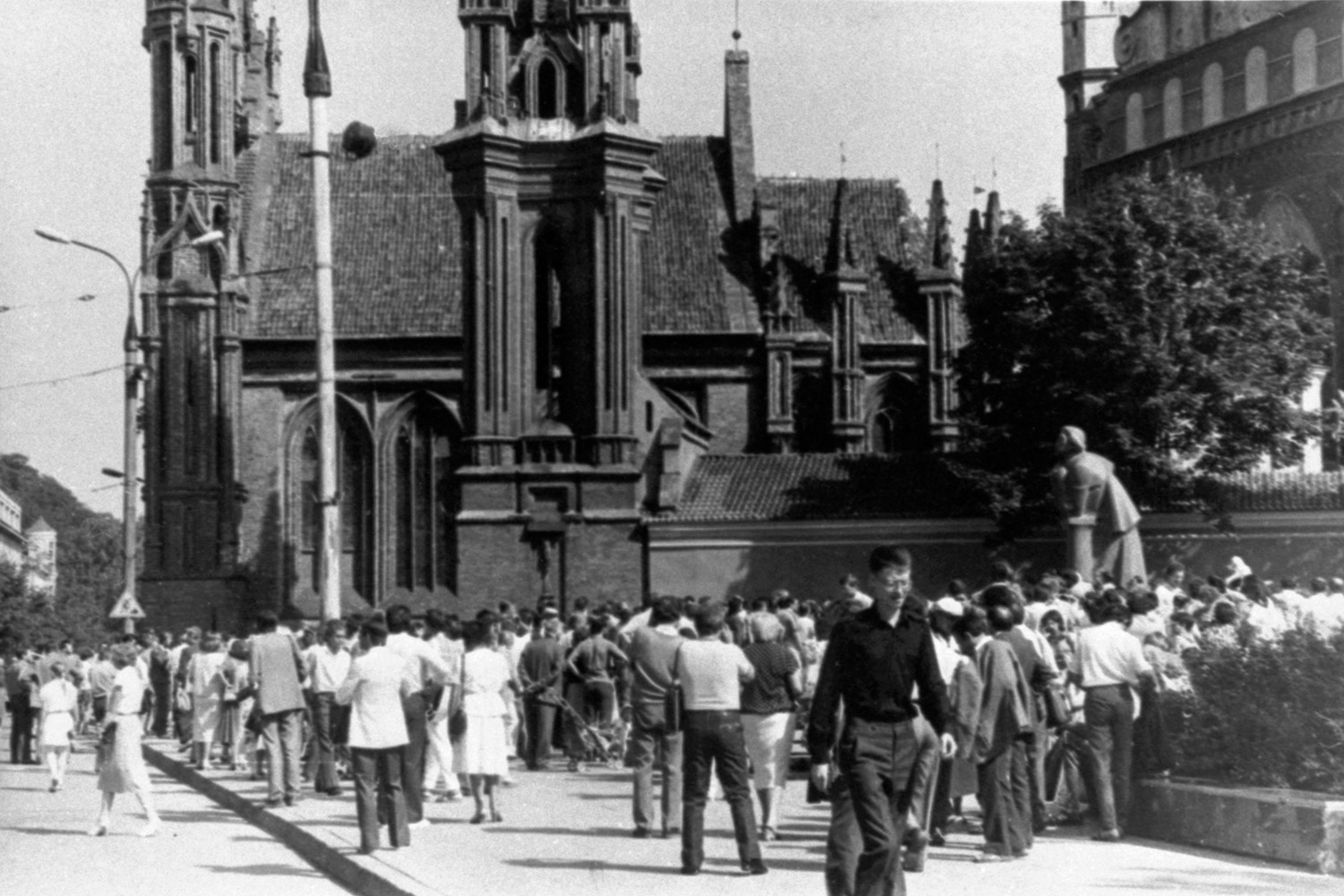 23/08/1987 – A fragment of the unsanctioned LLL rally at the monument of Adam Mickiewicz to condemn the Molotov-Ribbentrop Pact. LVCA, photographer: R. Lankas.
23/08/1987 – A fragment of the unsanctioned LLL rally at the monument of Adam Mickiewicz to condemn the Molotov-Ribbentrop Pact. LVCA, photographer: R. Lankas. -
 23/08/1987 – The unsanctioned LLL rally at the monument of Adam Mickiewicz to condemn the Molotov-Ribbentrop Pact. LVCA, photographer: R. Lankas.
23/08/1987 – The unsanctioned LLL rally at the monument of Adam Mickiewicz to condemn the Molotov-Ribbentrop Pact. LVCA, photographer: R. Lankas. -
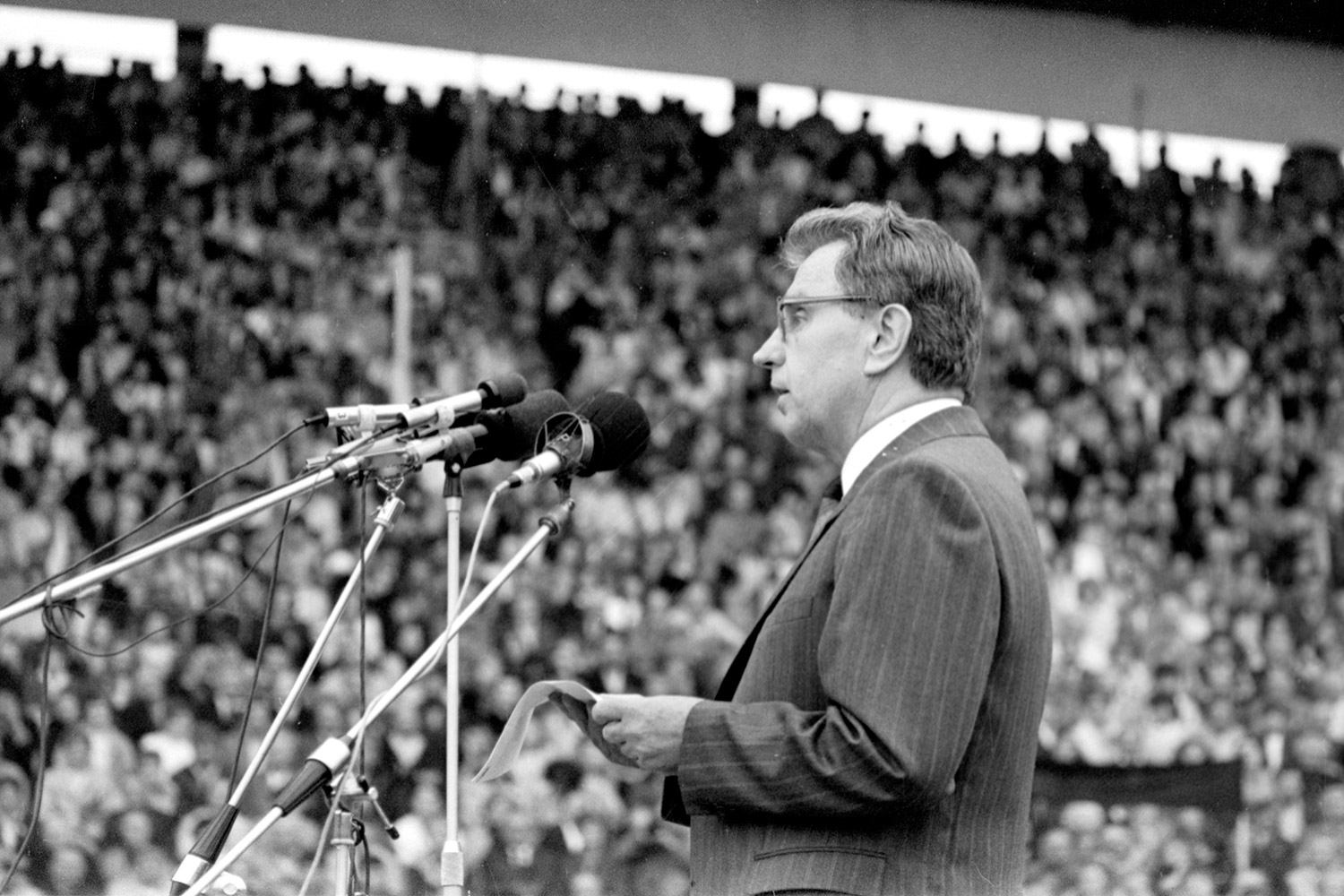 23/08/1988 – Rally by the Reform Movement of Lithuania (hereinafter – Sąjūdis) at Vingis Park to mark the 49th anniversary of the Molotov-Ribbentrop Pact and condemn Lithuania’s occupation/annexation. Speech by the poet Justinas Marcinkevičius. LVCA, photographer: J. Juknevičius.
23/08/1988 – Rally by the Reform Movement of Lithuania (hereinafter – Sąjūdis) at Vingis Park to mark the 49th anniversary of the Molotov-Ribbentrop Pact and condemn Lithuania’s occupation/annexation. Speech by the poet Justinas Marcinkevičius. LVCA, photographer: J. Juknevičius. -
 23/08/1988 – March to Sąjūdis-organised rally at Vingis Park against the Molotov-Ribbentrop Pact. LVCA, photographer: V. Kapočius.
23/08/1988 – March to Sąjūdis-organised rally at Vingis Park against the Molotov-Ribbentrop Pact. LVCA, photographer: V. Kapočius. -
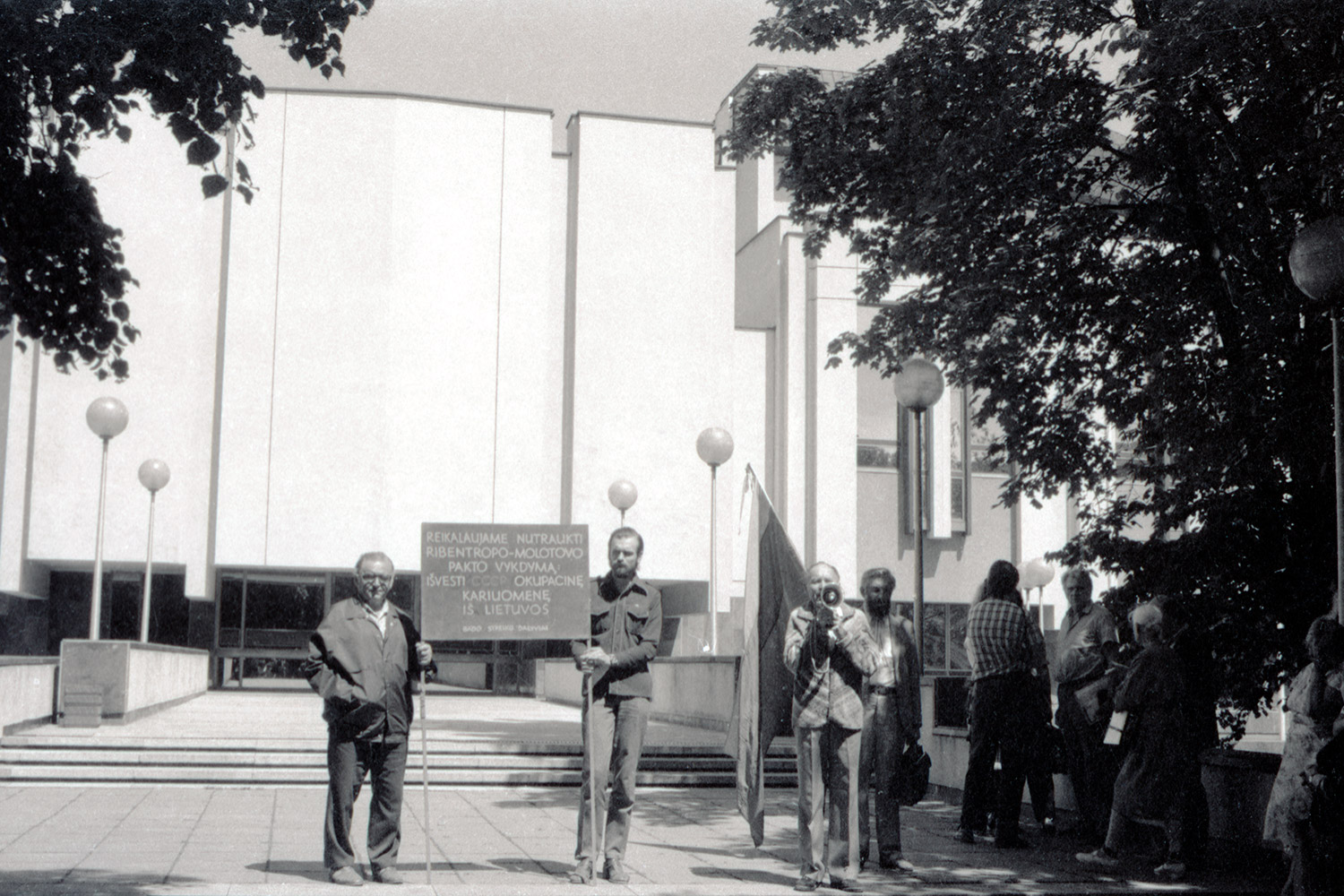 23/08/1988 – Picket by the Lithuanian Liberty League of the Reform Movement of Lithuania at the Government building due to the hunger strike of V. Milvydas, demanding the termination of the Molotov-Ribbentrop Pact and the withdrawal of the Soviet occupying army from Lithuania. The poster on the right is held by Leonardas Vilkas. LCVA, photographer: V. Kapočius.
23/08/1988 – Picket by the Lithuanian Liberty League of the Reform Movement of Lithuania at the Government building due to the hunger strike of V. Milvydas, demanding the termination of the Molotov-Ribbentrop Pact and the withdrawal of the Soviet occupying army from Lithuania. The poster on the right is held by Leonardas Vilkas. LCVA, photographer: V. Kapočius. -
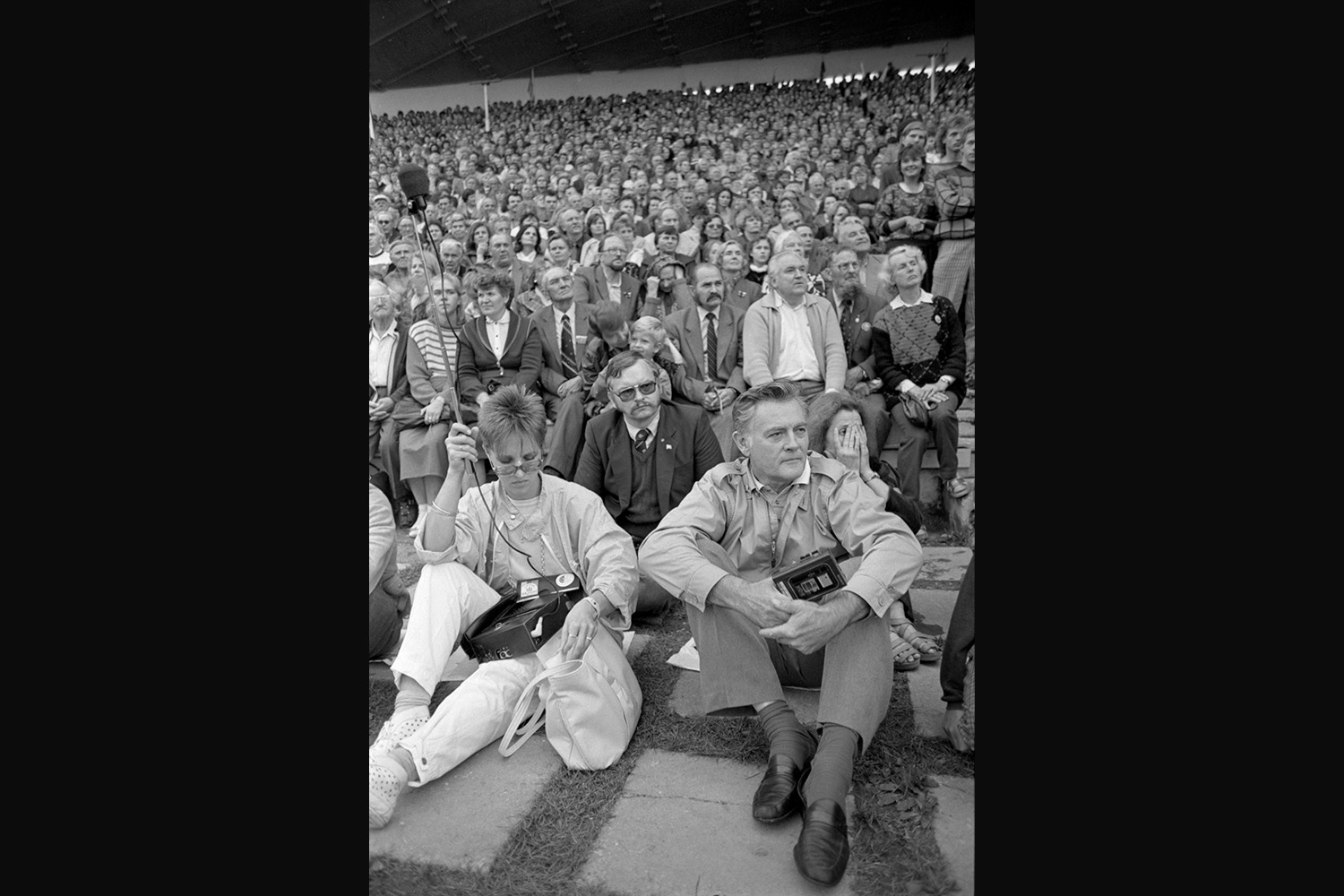 23/08/1988 – Sąjūdis-organised rally at Vingis Park to mark the 49th anniversary of the Molotov-Ribbentrop Pact and condemn the occupation of Lithuania. At the front, next to the news radio journalist: American-Lithuanian public figure and environmentalist Valdas Adamkus. LVCA, photographer: A. Žižiūnas.
23/08/1988 – Sąjūdis-organised rally at Vingis Park to mark the 49th anniversary of the Molotov-Ribbentrop Pact and condemn the occupation of Lithuania. At the front, next to the news radio journalist: American-Lithuanian public figure and environmentalist Valdas Adamkus. LVCA, photographer: A. Žižiūnas. -
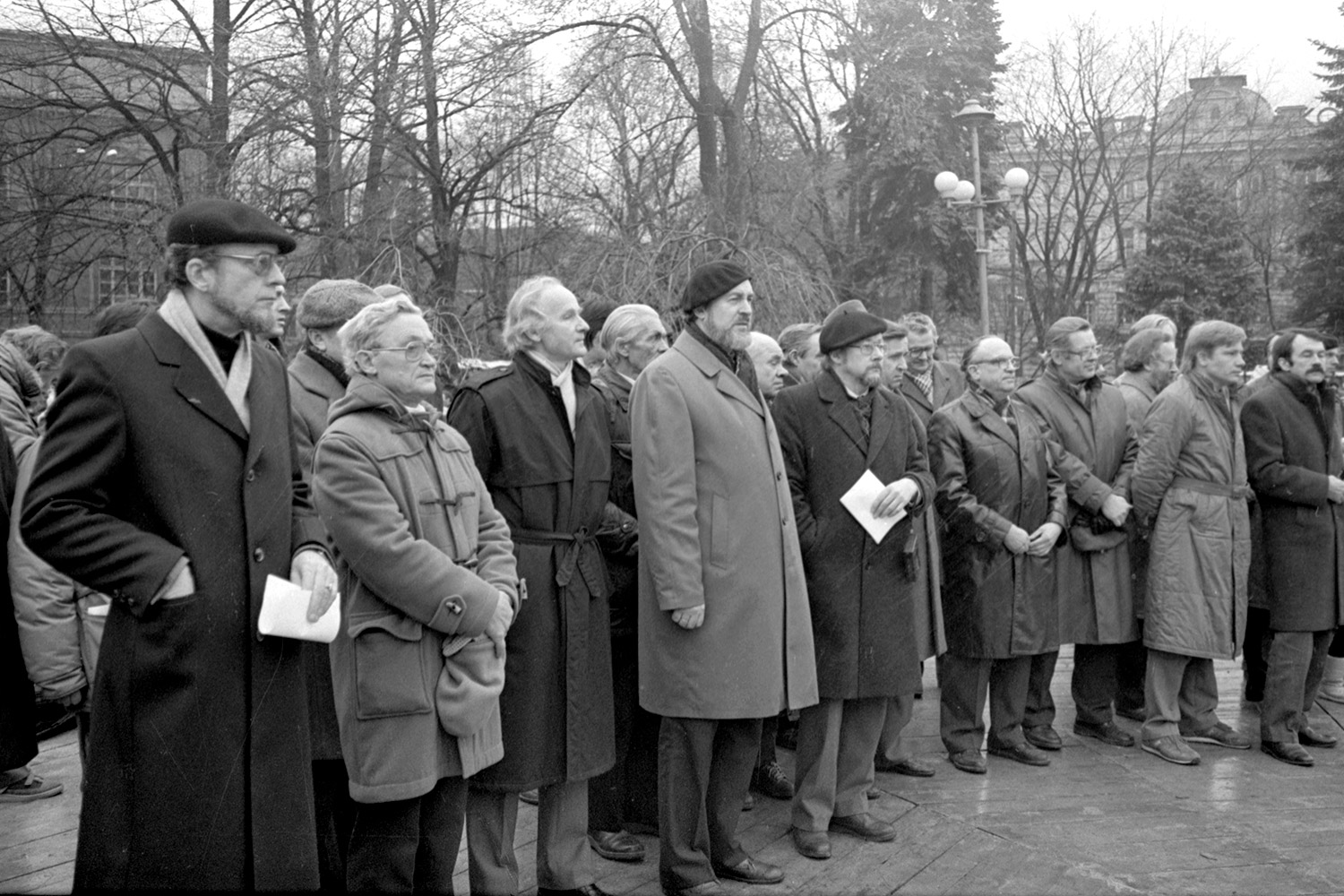 December 1988 – Escorts of USSR People’s Deputies to Moscow in Vilnius, Gediminas Square (now – Cathedral Square). First row, from left: Arūnas Žebriūnas, Algimantas Čekuolis, Algimantas Nasvytis, Antanas Buračas, Vytautas Landsbergis, Vytautas Bubnys, Vitas Tomkus, Romualdas Ozolas and others. Among the members of Sąjūdis are former Deputies of the USSR Supreme Soviet: Vaclovas Mikučiauskas and Algirdas Ferensas. LVCA, photographer: J. Juknevičius.
December 1988 – Escorts of USSR People’s Deputies to Moscow in Vilnius, Gediminas Square (now – Cathedral Square). First row, from left: Arūnas Žebriūnas, Algimantas Čekuolis, Algimantas Nasvytis, Antanas Buračas, Vytautas Landsbergis, Vytautas Bubnys, Vitas Tomkus, Romualdas Ozolas and others. Among the members of Sąjūdis are former Deputies of the USSR Supreme Soviet: Vaclovas Mikučiauskas and Algirdas Ferensas. LVCA, photographer: J. Juknevičius. -
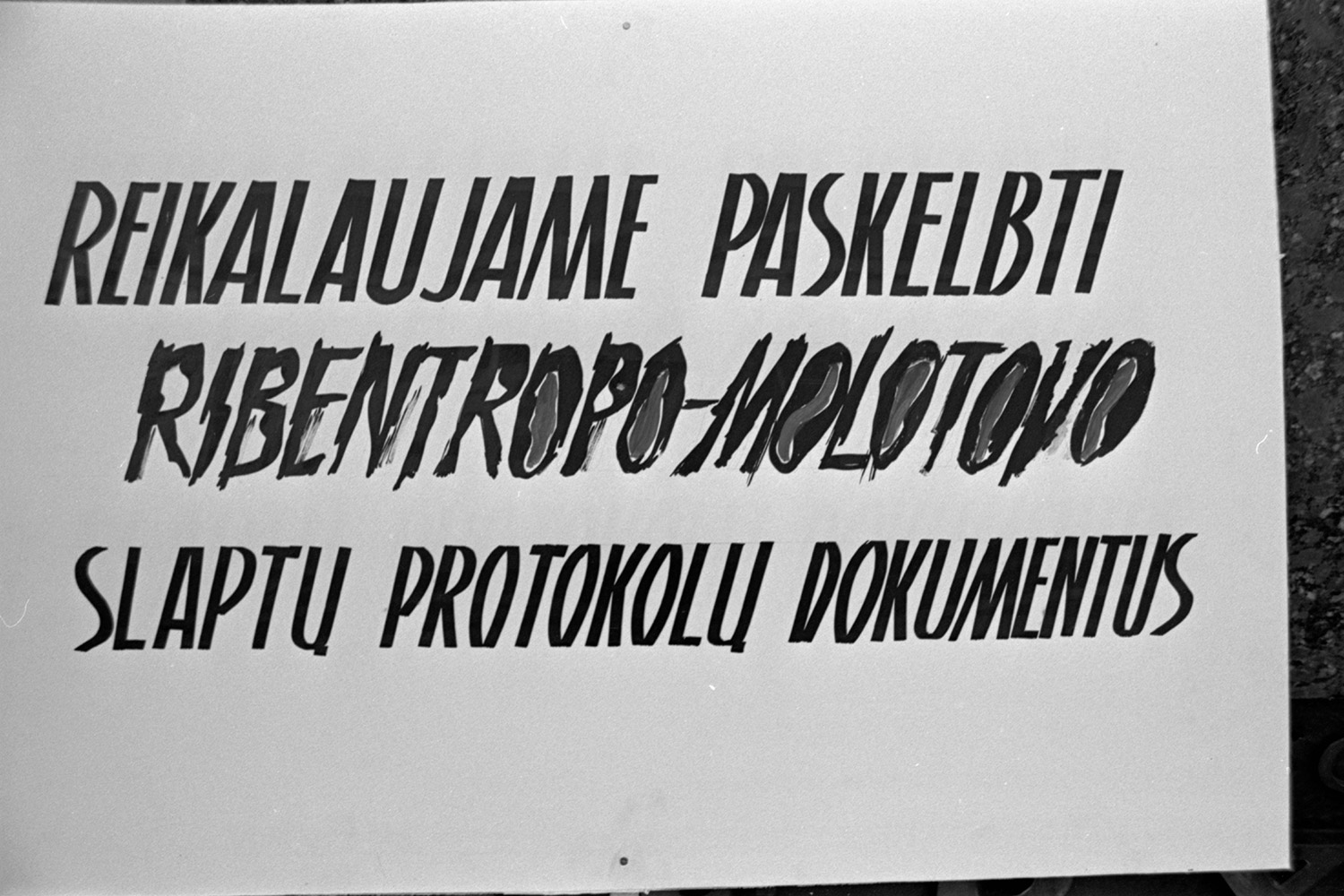 18/05/1989 – Poster at the picket organised next to the Supreme Soviet of the LSSR. LVCA, photographer: A. Žižiūnas.
18/05/1989 – Poster at the picket organised next to the Supreme Soviet of the LSSR. LVCA, photographer: A. Žižiūnas. -
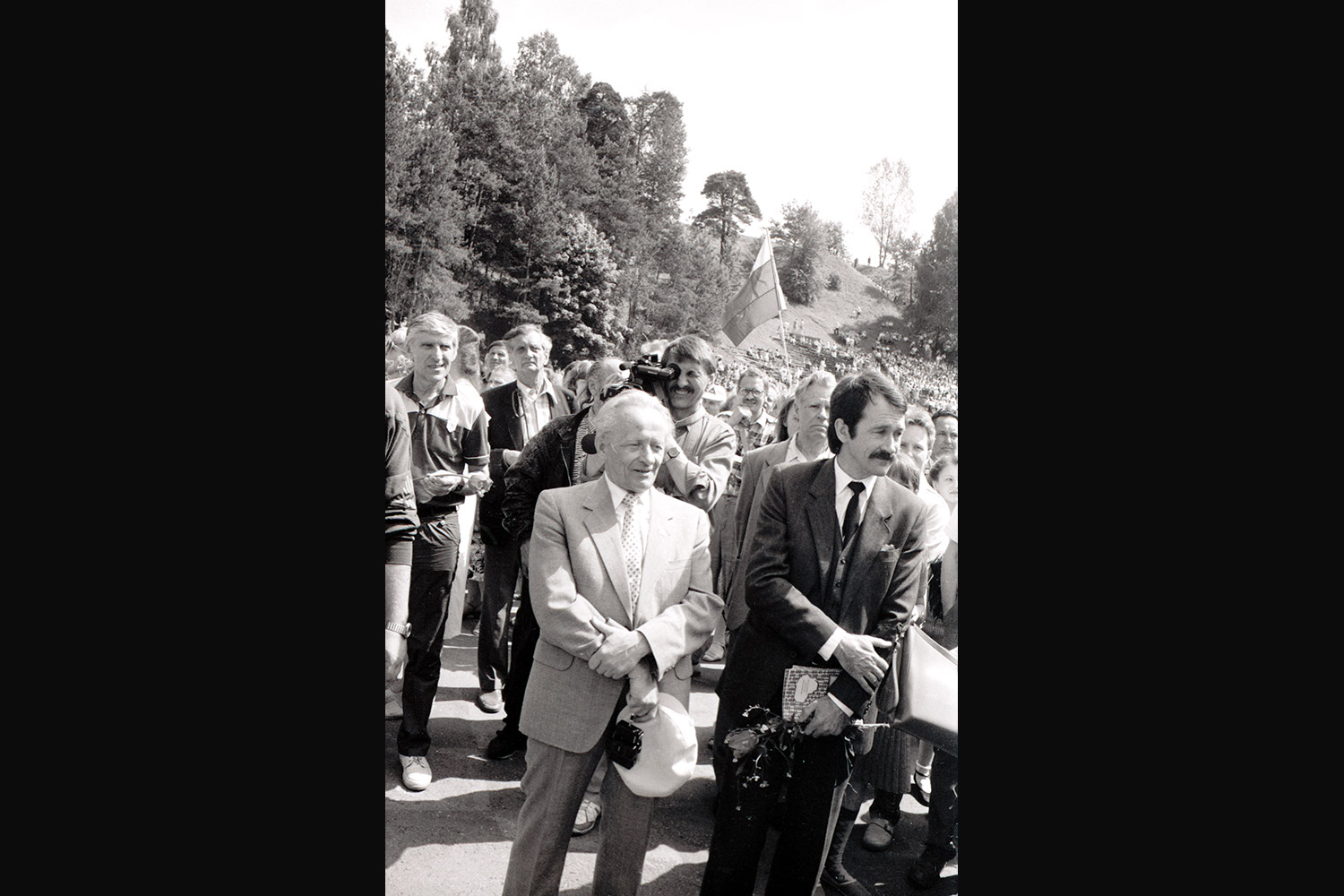 20/05/1989 – Rally in Kalnų Park – escort of newly elected USSR People’s Deputies to the first Congress in Moscow. LVCA, photographer: Jonas Juknevičius.
20/05/1989 – Rally in Kalnų Park – escort of newly elected USSR People’s Deputies to the first Congress in Moscow. LVCA, photographer: Jonas Juknevičius. -
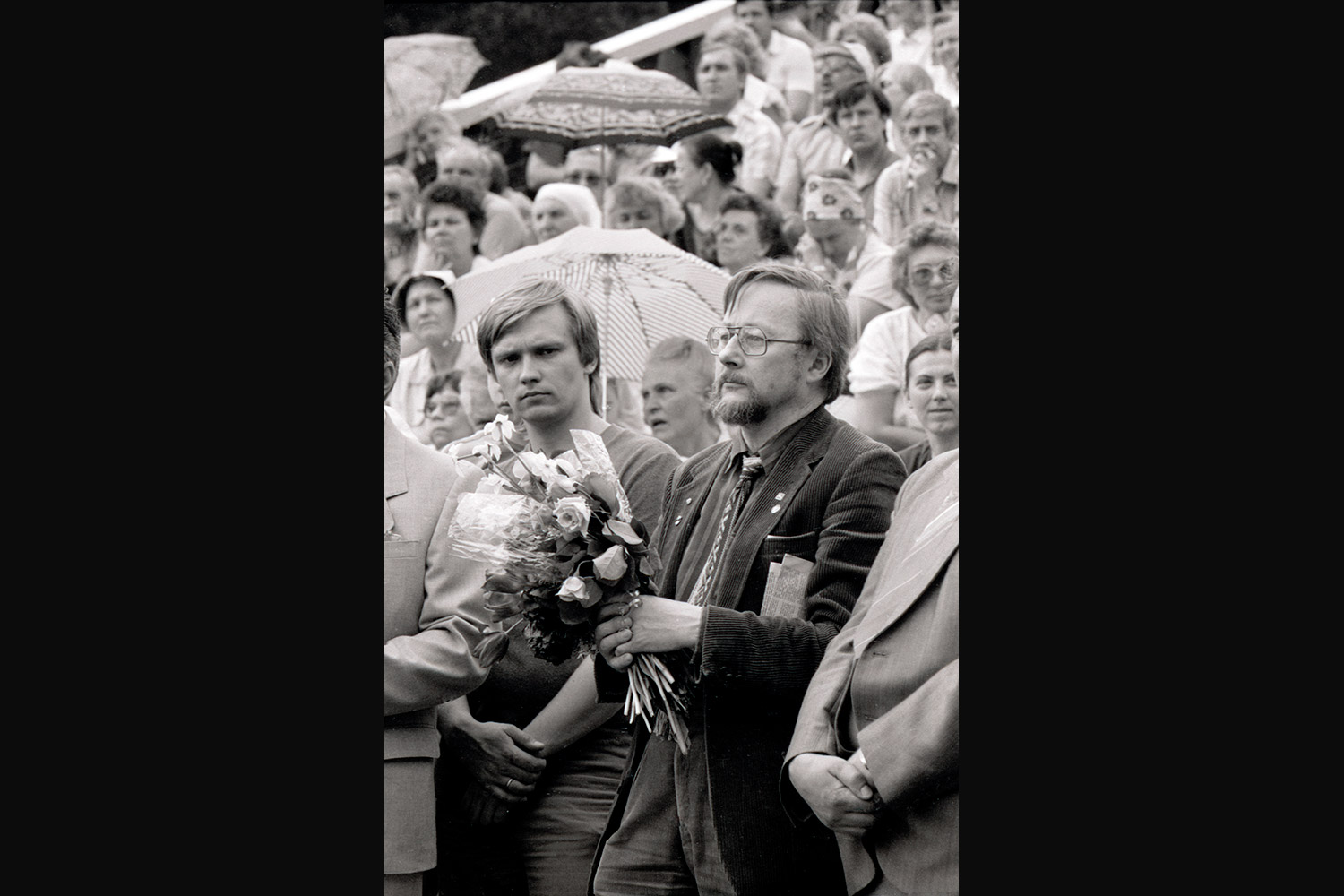 20/05/1989 – Rally in Kalnų Park – escort of newly elected USSR People’s Deputies to the first Congress in Moscow. LVCA, photographer J. Juknevičius.
20/05/1989 – Rally in Kalnų Park – escort of newly elected USSR People’s Deputies to the first Congress in Moscow. LVCA, photographer J. Juknevičius. -
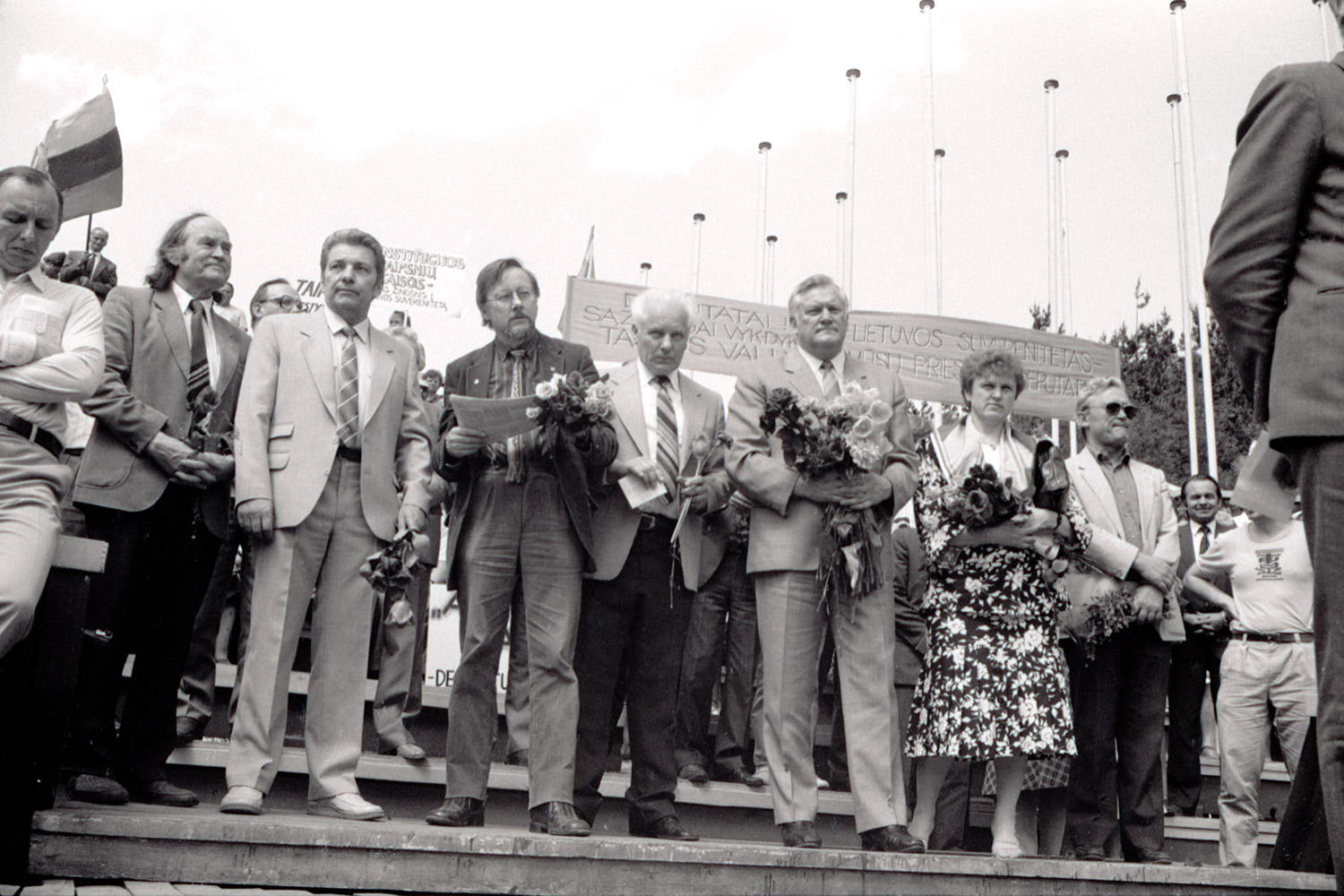 20/05/1989 – Rally in Kalnų Park – escort of newly elected USSR People’s Deputies to the first Congress in Moscow. LVCA, photographer J. Juknevičius.
20/05/1989 – Rally in Kalnų Park – escort of newly elected USSR People’s Deputies to the first Congress in Moscow. LVCA, photographer J. Juknevičius. -
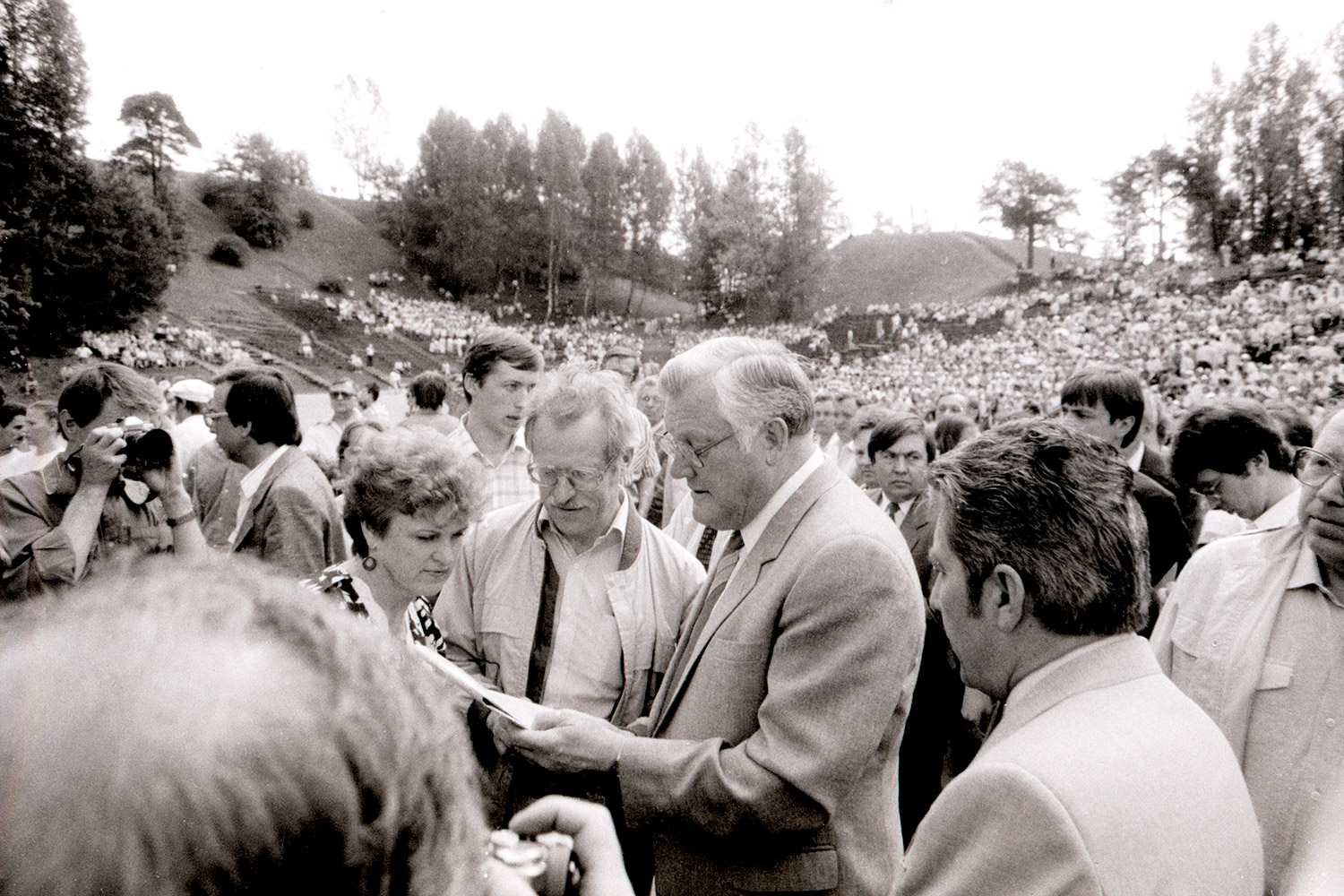 24/05/1989 – Lithuanian delegates escort in Kalnų Park to the Congress of People’s Deputies of the Soviet Union in Moscow. First Secretary of the LCP Central Committee: Algirdas Brazauskas. LVCA, photographer: V. Kapočius.
24/05/1989 – Lithuanian delegates escort in Kalnų Park to the Congress of People’s Deputies of the Soviet Union in Moscow. First Secretary of the LCP Central Committee: Algirdas Brazauskas. LVCA, photographer: V. Kapočius. -
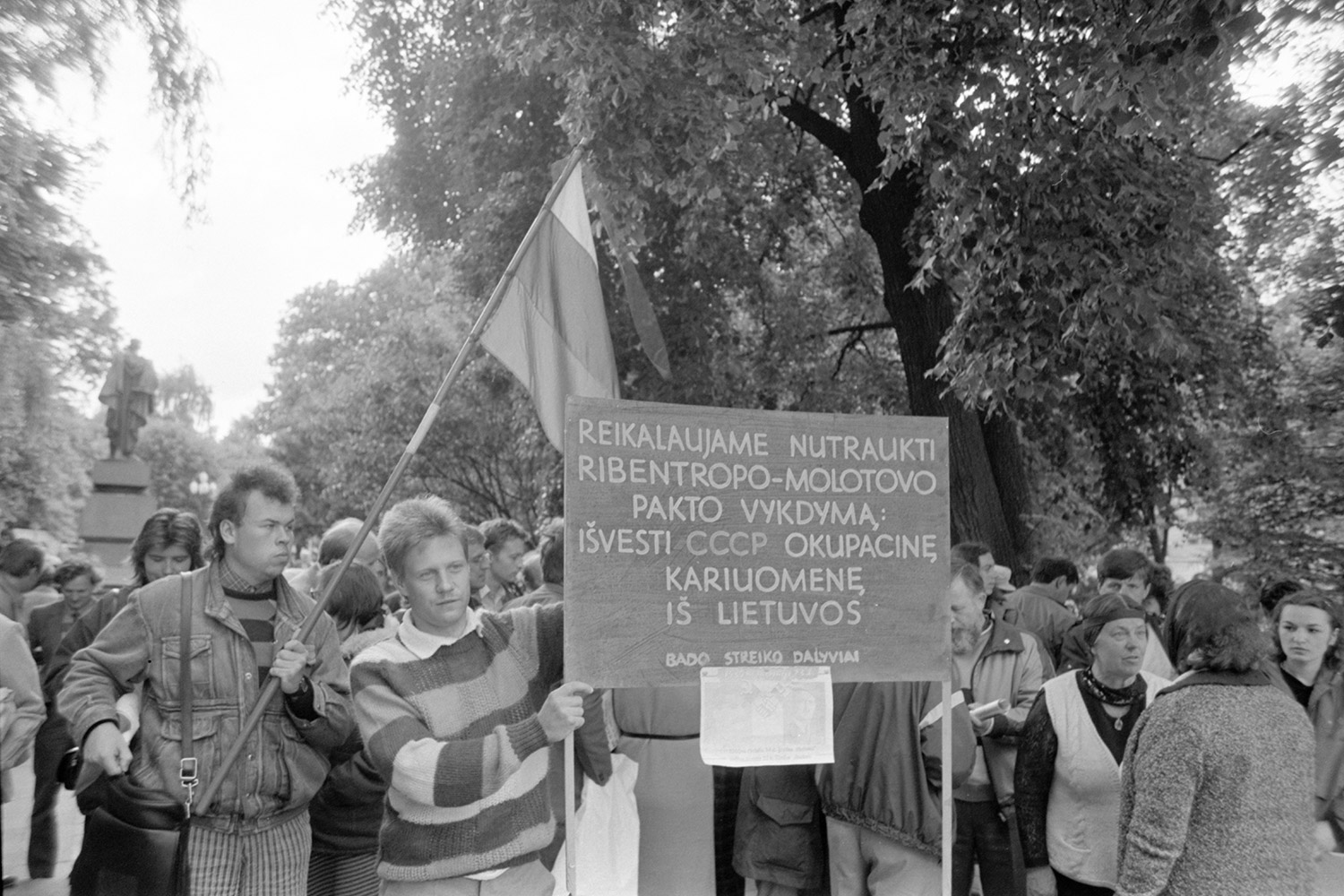 June 1989 – Picket in Chernyakhovsky Square (now – Vinco Kudirkos Square) for the withdrawal of Soviet troops from the territory of Lithuania. LVCA, photographer: A. Žižiūnas.
June 1989 – Picket in Chernyakhovsky Square (now – Vinco Kudirkos Square) for the withdrawal of Soviet troops from the territory of Lithuania. LVCA, photographer: A. Žižiūnas. -
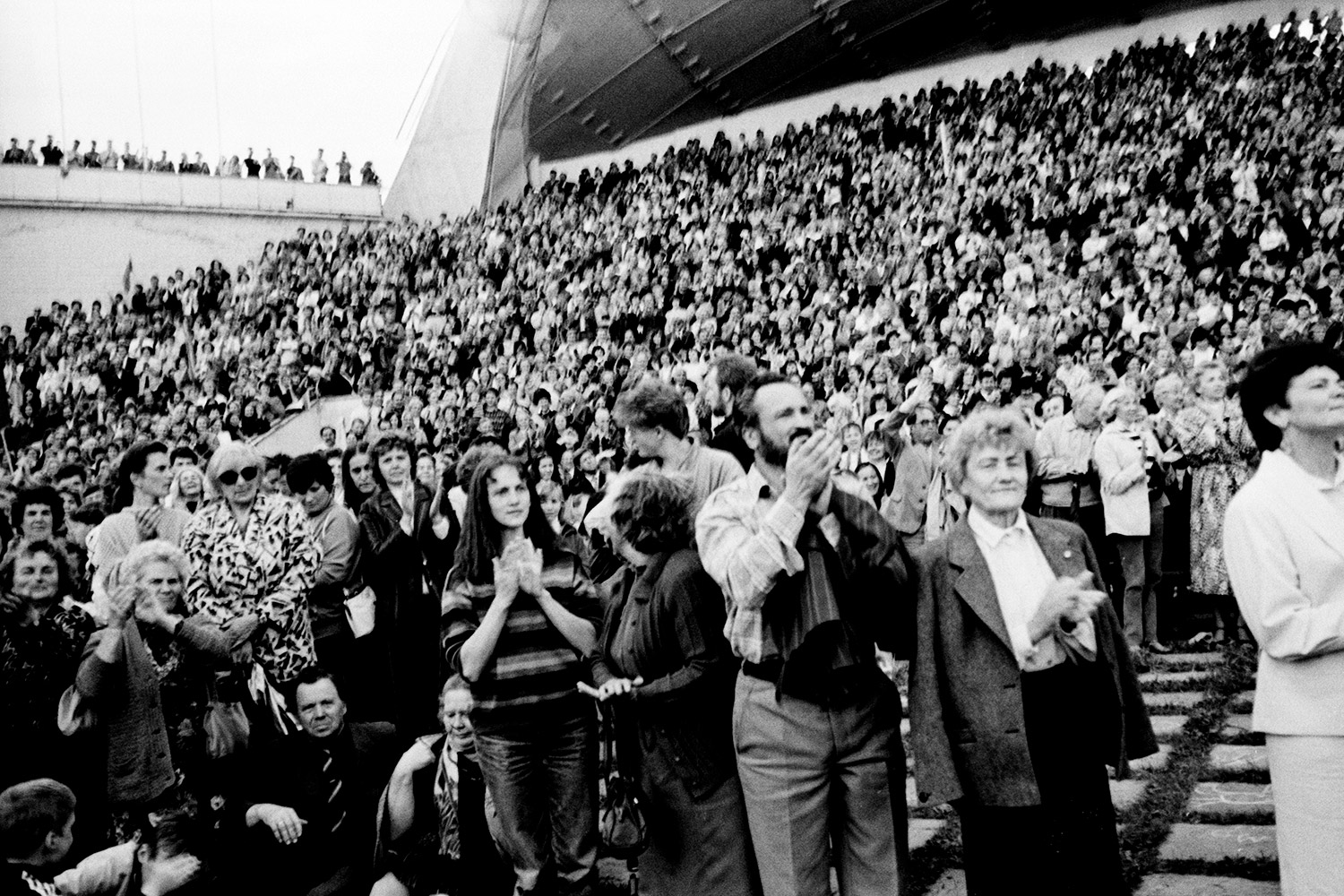 11/06/1989 – Meeting of the People’s Deputies of the USSR upon returning from Moscow. LVCA, photographer: J. Juknevičius.
11/06/1989 – Meeting of the People’s Deputies of the USSR upon returning from Moscow. LVCA, photographer: J. Juknevičius. -
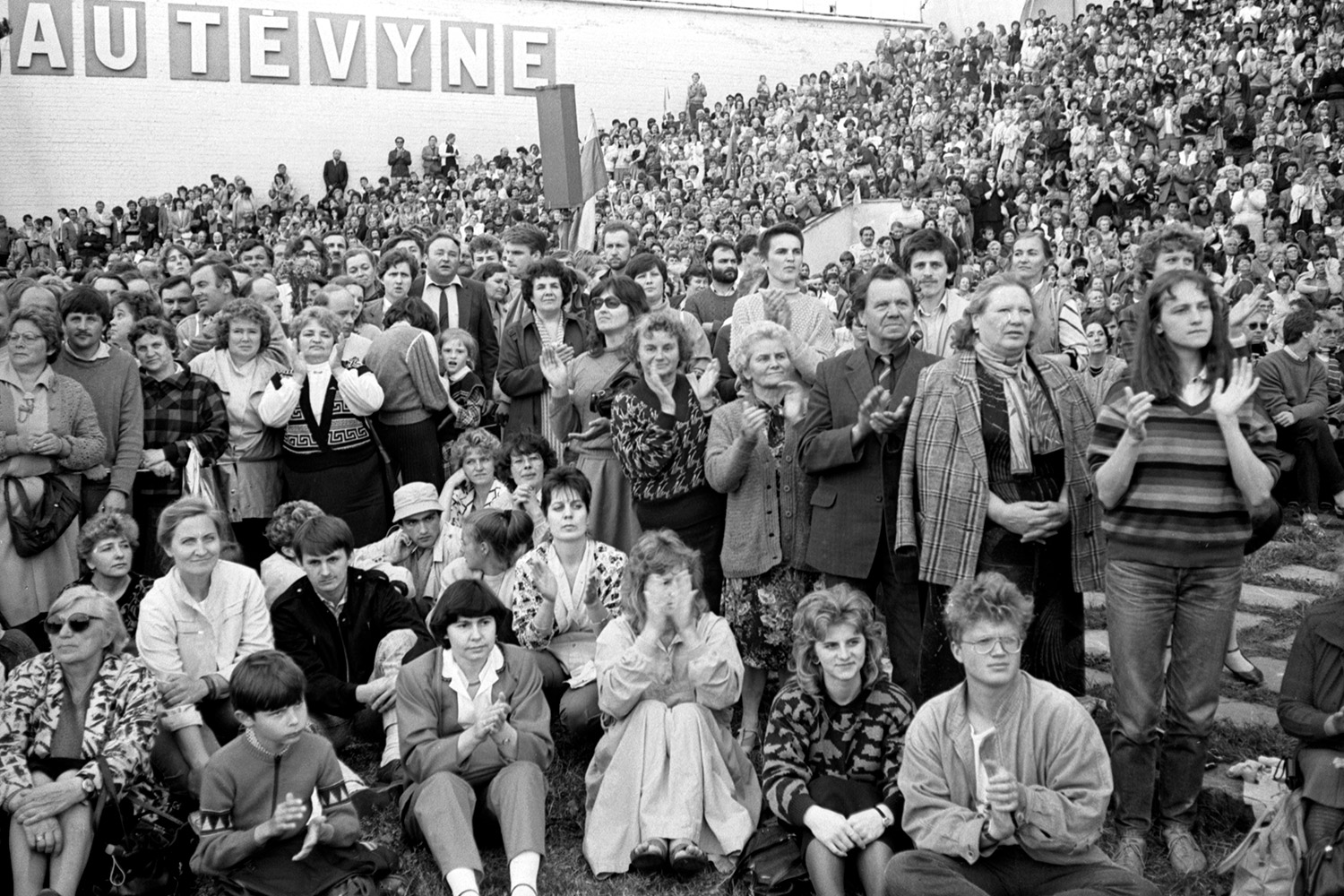 11/06/1989 – Sąjūdis rally in Vingis Park – meeting with Lithuanian delegates returning from the Congress of People's Deputies of the USSR in Moscow. LVCA, photographer: J. Juknevičius.
11/06/1989 – Sąjūdis rally in Vingis Park – meeting with Lithuanian delegates returning from the Congress of People's Deputies of the USSR in Moscow. LVCA, photographer: J. Juknevičius. -
 11/06/1989 – Sąjūdis rally-meeting with the People’s Deputies of the USSR returning from the meeting in Moscow. LVCA, photographer: V. Kapočius.
11/06/1989 – Sąjūdis rally-meeting with the People’s Deputies of the USSR returning from the meeting in Moscow. LVCA, photographer: V. Kapočius. -
 1989 – V. Milvydas’ hunger strike near the Palace of the LCP Central Committee in protest against the Molotov-Ribbentrop Pact and its consequences. People read a poster hanging at the tent of the protesters: “With this hunger strike, we demand that: 1. Without delay, the secret documents of the Molotov-Ribbentrop Pact would be discussed. 2. The secret documents must be declared unlawful and invalid from the date of their signing and their consequences must be liquidated. 3. The Peace Treaty signed by the governments of Lithuania and Soviet Russia on 12 July 1920 must be declared valid.” LVCA, photographer: V. Kapočius.
1989 – V. Milvydas’ hunger strike near the Palace of the LCP Central Committee in protest against the Molotov-Ribbentrop Pact and its consequences. People read a poster hanging at the tent of the protesters: “With this hunger strike, we demand that: 1. Without delay, the secret documents of the Molotov-Ribbentrop Pact would be discussed. 2. The secret documents must be declared unlawful and invalid from the date of their signing and their consequences must be liquidated. 3. The Peace Treaty signed by the governments of Lithuania and Soviet Russia on 12 July 1920 must be declared valid.” LVCA, photographer: V. Kapočius. -
 1989 – The LLL picket at the Palace of the LCP Central Committee, supporting V. Milvydas’ hunger strike, demanding an end to the effects of the Molotov-Ribbentrop Pact and the withdrawal of the Soviet occupying army from Lithuania. The poster is held by (on the right) Leonardas Vilkas. LVCA, photographer: V. Kapočius.
1989 – The LLL picket at the Palace of the LCP Central Committee, supporting V. Milvydas’ hunger strike, demanding an end to the effects of the Molotov-Ribbentrop Pact and the withdrawal of the Soviet occupying army from Lithuania. The poster is held by (on the right) Leonardas Vilkas. LVCA, photographer: V. Kapočius. -
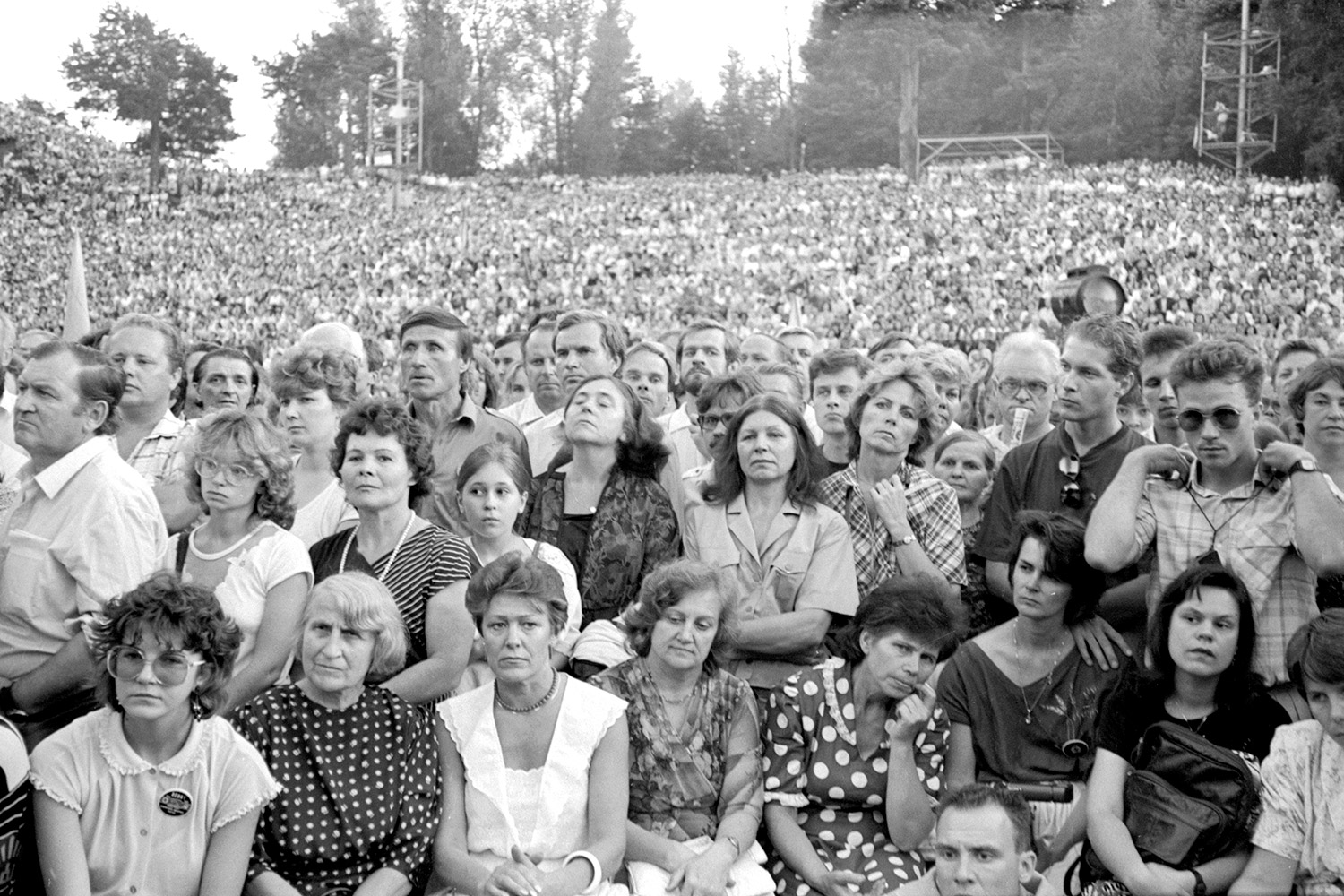 22/08/1989 – Meeting in Kalnų Park marking the 50th anniversary of the Molotov-Ribbentrop Pact. LVCA, photographer: J. Juknevičius.
22/08/1989 – Meeting in Kalnų Park marking the 50th anniversary of the Molotov-Ribbentrop Pact. LVCA, photographer: J. Juknevičius. -
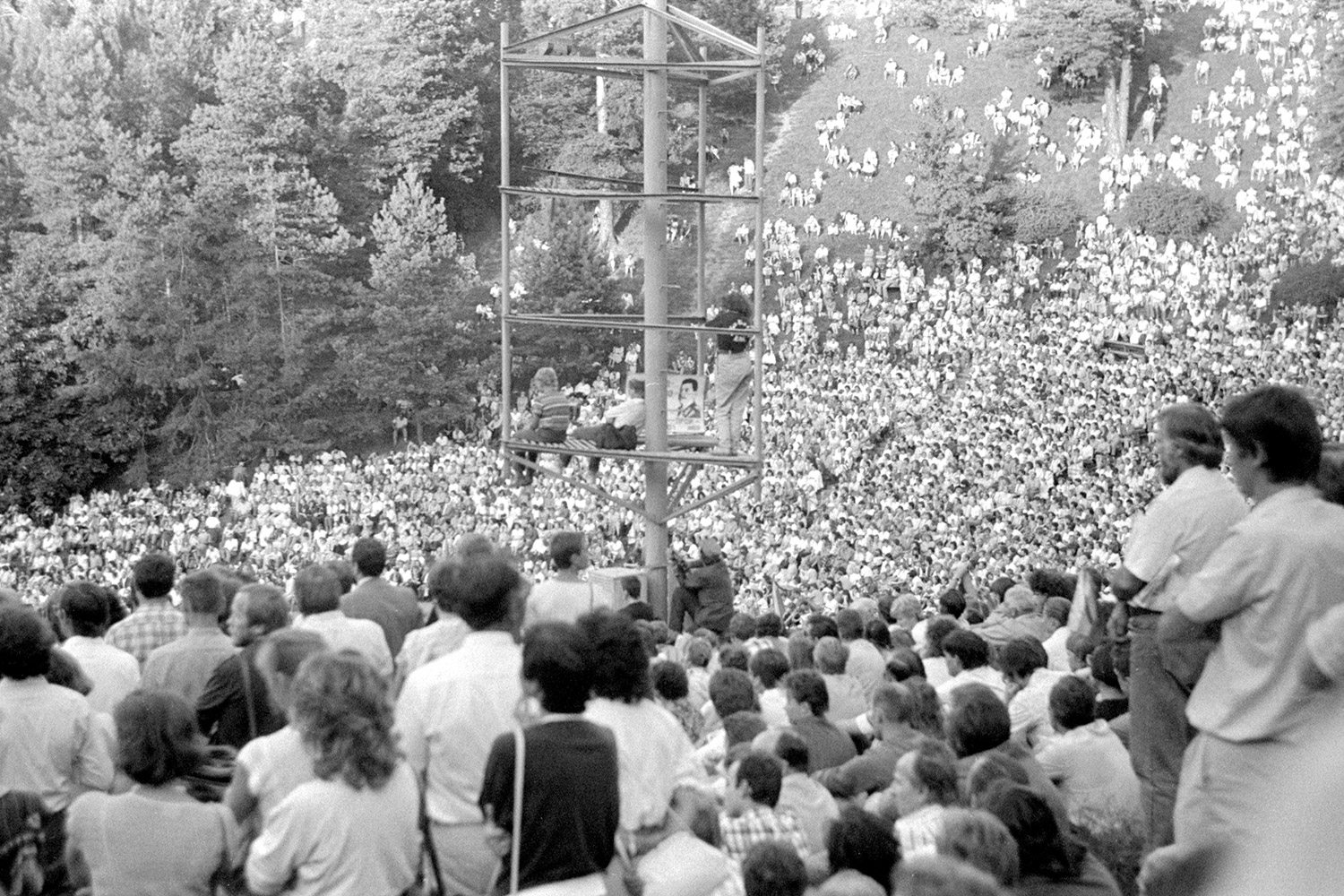 22/08/1989 – Rally in Kalnų Park against the consequences of the Molotov-Ribbentrop Pact. LVCA, photographer: R. Žičkus.
22/08/1989 – Rally in Kalnų Park against the consequences of the Molotov-Ribbentrop Pact. LVCA, photographer: R. Žičkus. -
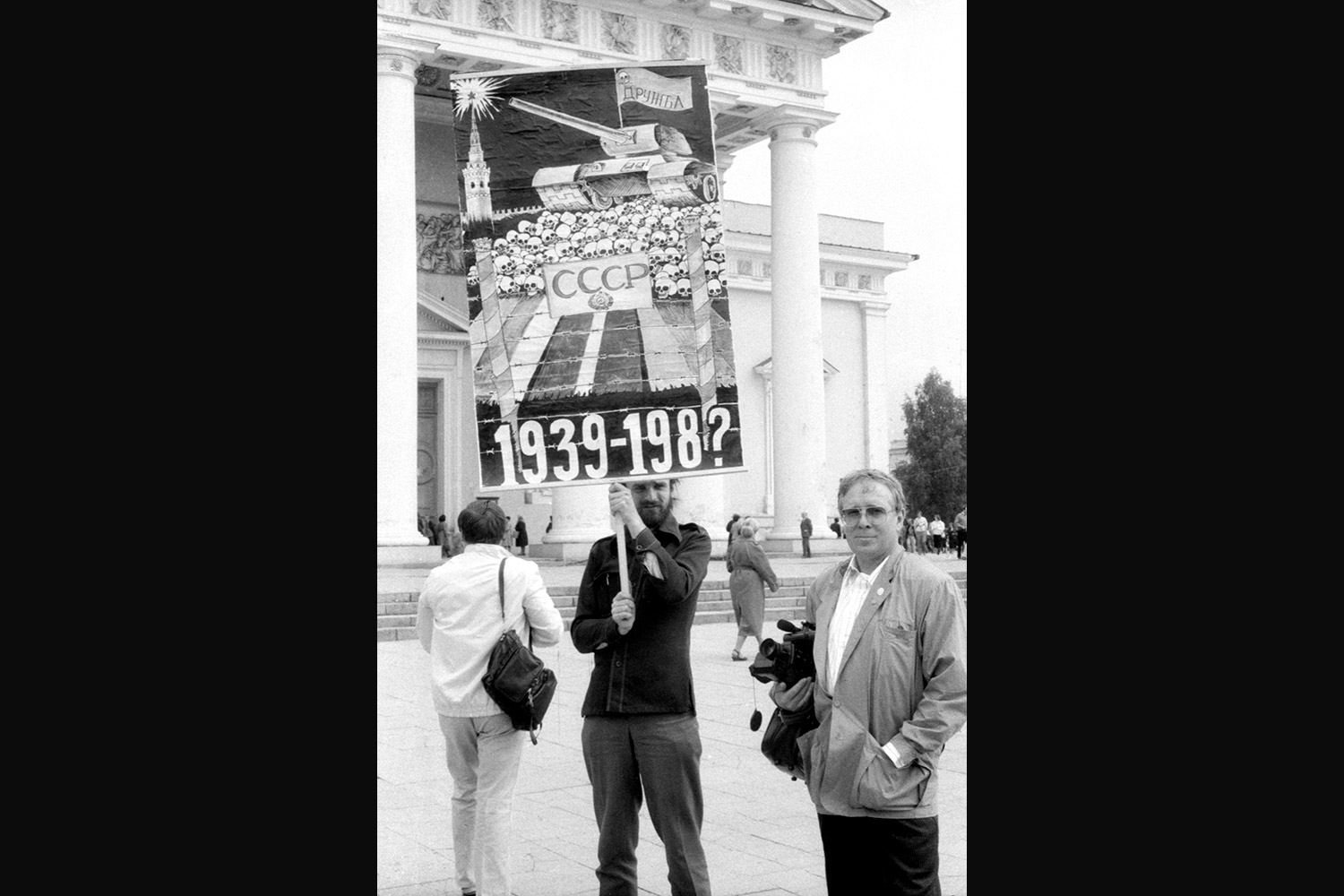 23/08/1989 – Meeting of the Union of Freedom Defenders in Vilnius Kalnų Park to condemn the 50th anniversary of the Molotov-Ribbentrop Pact and its consequences. Poster is held by Leonardas Vilkas. LVCA, photographer: V. Kapočius.
23/08/1989 – Meeting of the Union of Freedom Defenders in Vilnius Kalnų Park to condemn the 50th anniversary of the Molotov-Ribbentrop Pact and its consequences. Poster is held by Leonardas Vilkas. LVCA, photographer: V. Kapočius. -
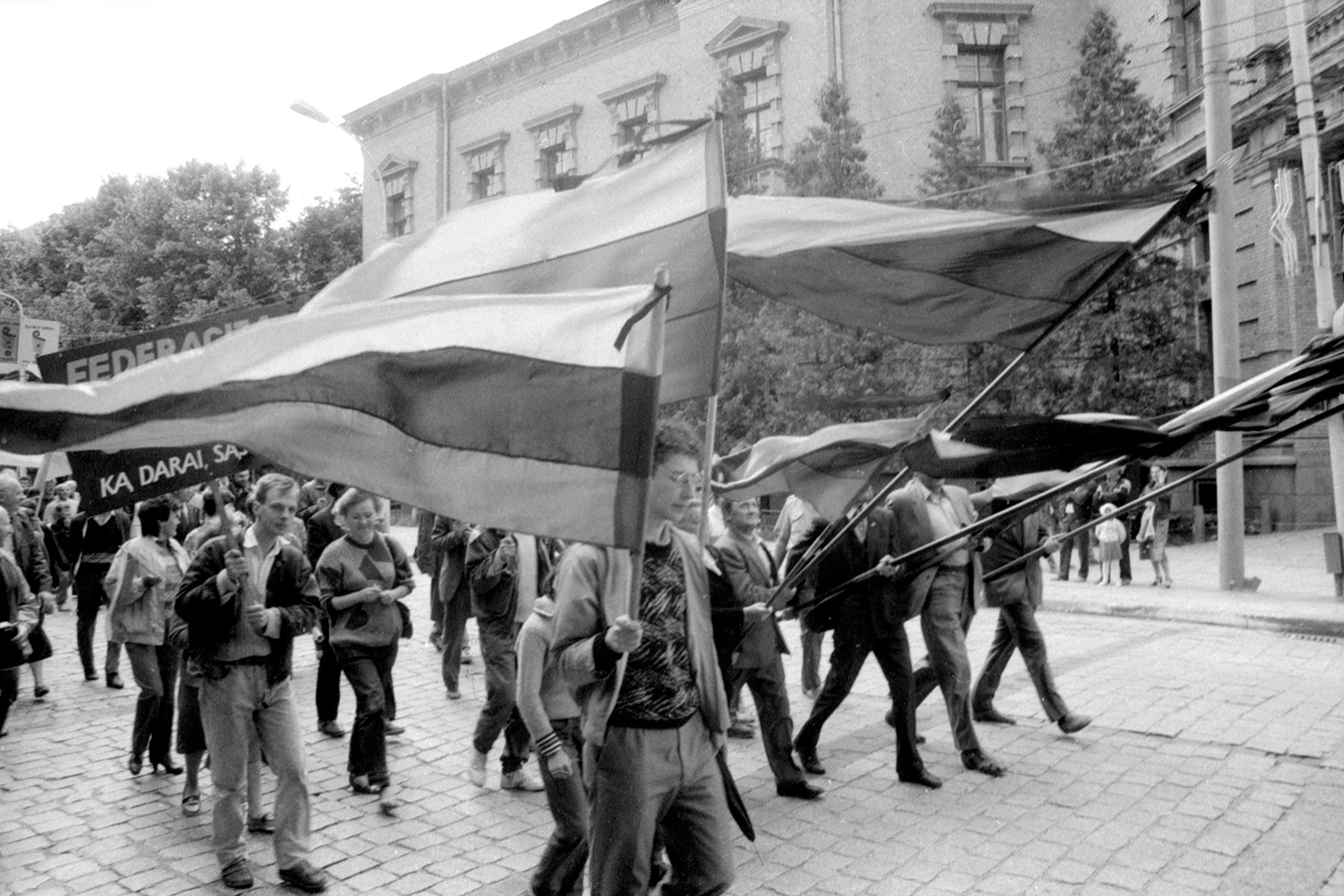 23/08/1989 – Meeting of the Union of Freedom Defenders in Vilnius Kalnų Park to condemn the 50th anniversary of the Molotov-Ribbentrop Pact and its consequences. LVCA, photographer V. Kapočius.
23/08/1989 – Meeting of the Union of Freedom Defenders in Vilnius Kalnų Park to condemn the 50th anniversary of the Molotov-Ribbentrop Pact and its consequences. LVCA, photographer V. Kapočius. -
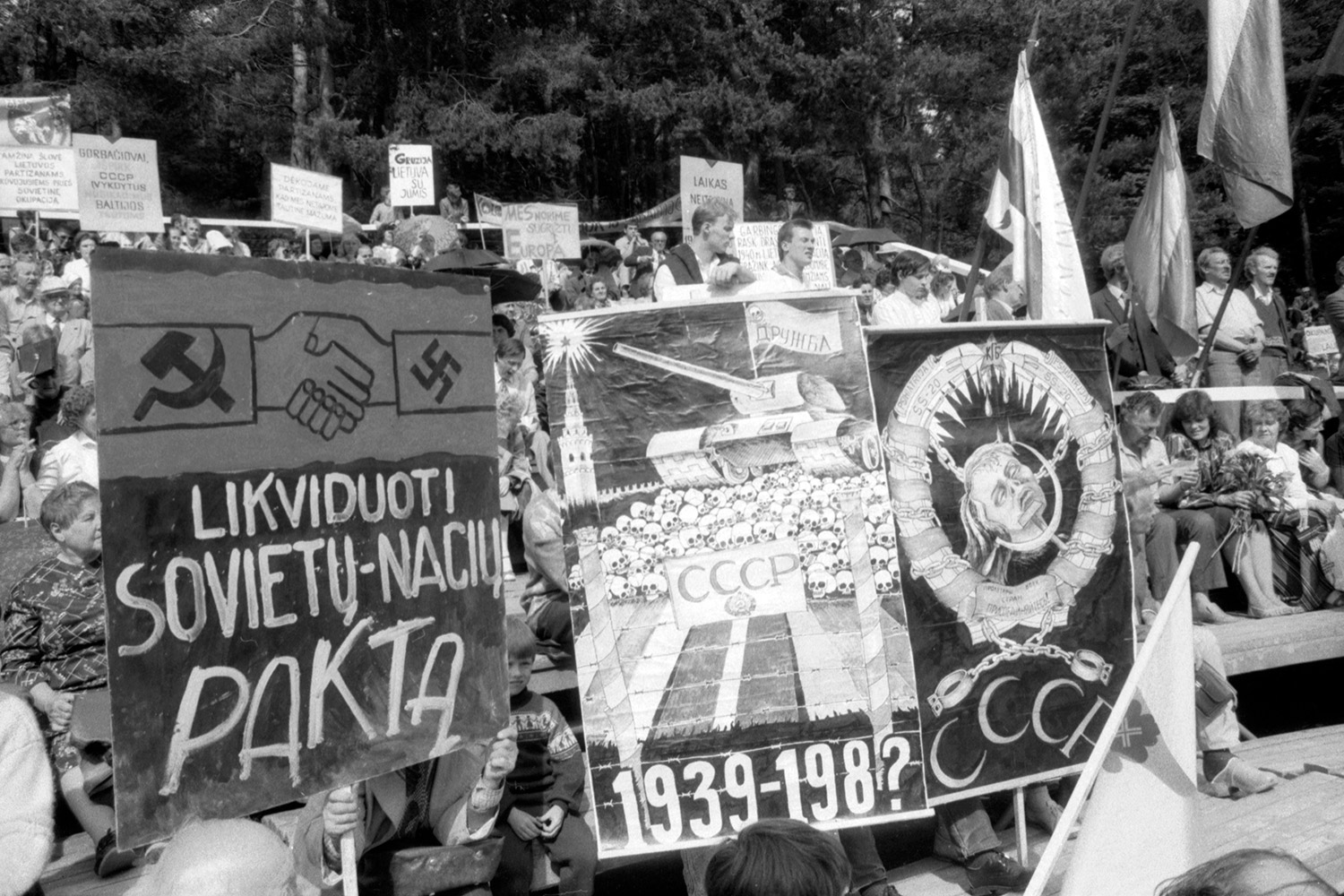 23/08/1989 – Meeting of the Union of Freedom Defenders in Vilnius Kalnų Park to condemn the 50th anniversary of the Molotov-Ribbentrop Pact and its consequences. LVCA, photographer: V. Kapočius.
23/08/1989 – Meeting of the Union of Freedom Defenders in Vilnius Kalnų Park to condemn the 50th anniversary of the Molotov-Ribbentrop Pact and its consequences. LVCA, photographer: V. Kapočius. -
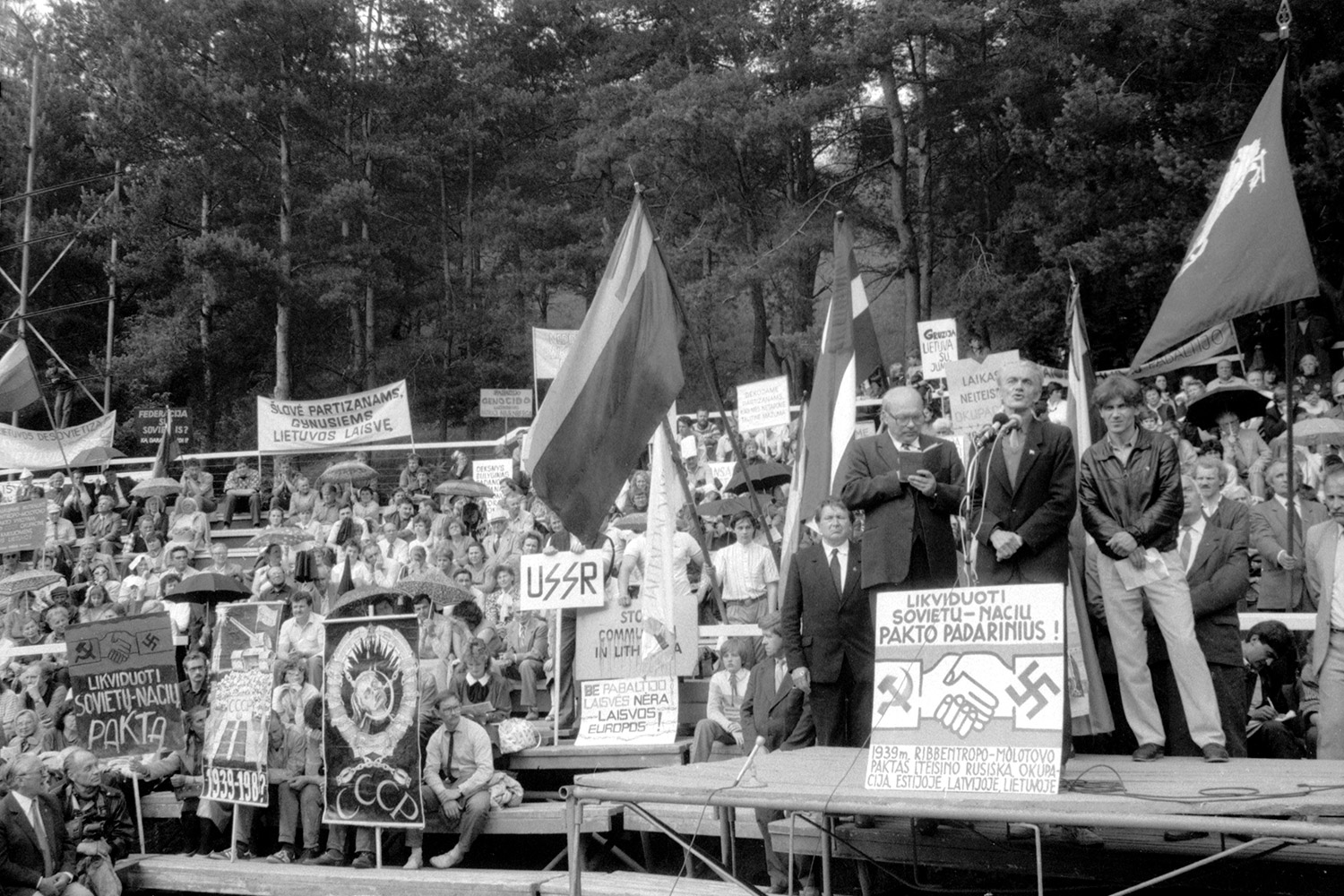 23/08/1989 – Meeting of the Union of Freedom Defenders in Vilnius Kalnų Park to condemn the 50th anniversary of the Molotov-Ribbentrop Pact and its consequences. At the microphone: dissident Povilas Pečeliūnas. LVCA, photographer: V. Kapočius.
23/08/1989 – Meeting of the Union of Freedom Defenders in Vilnius Kalnų Park to condemn the 50th anniversary of the Molotov-Ribbentrop Pact and its consequences. At the microphone: dissident Povilas Pečeliūnas. LVCA, photographer: V. Kapočius. -
 23/08/1989 – Theatricalised protest action in Gediminas Square (now – Cathedral Square) by the Lithuanian National Youth Union “Jaunoji Lietuva”, condemning the Molotov-Ribbentrop Pact. In the background: Algimantas Andreika, dressed in a prisoner’s uniform. LVCA, photographer: V. Kapočius.
23/08/1989 – Theatricalised protest action in Gediminas Square (now – Cathedral Square) by the Lithuanian National Youth Union “Jaunoji Lietuva”, condemning the Molotov-Ribbentrop Pact. In the background: Algimantas Andreika, dressed in a prisoner’s uniform. LVCA, photographer: V. Kapočius. -
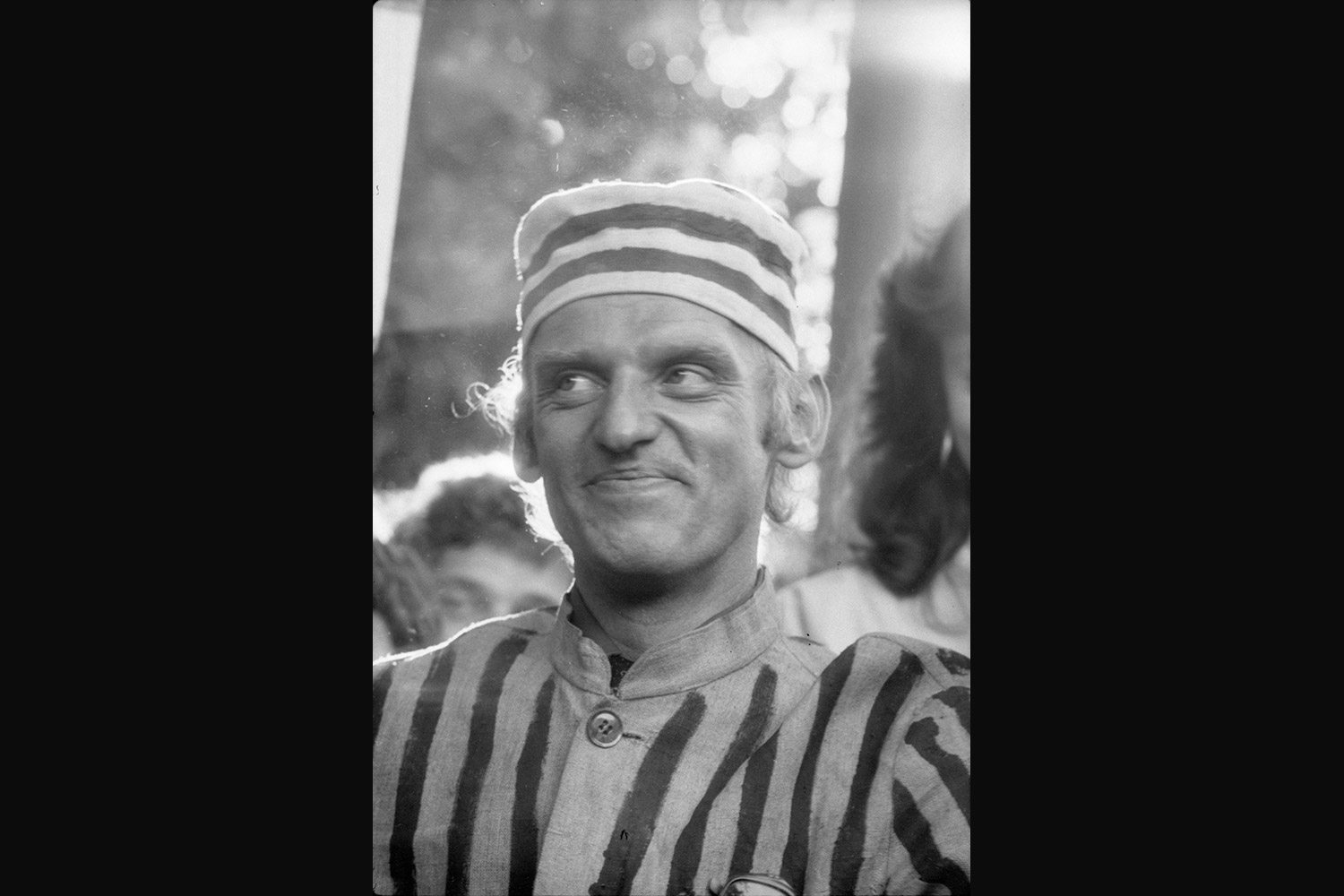 23/08/1989 – LLL protest action, demanding liquidation of the consequences of the Molotov-Ribbentrop Pact. Lithuanian National Youth Union “Jaunoji Lietuva” theatricalised protest action in Gediminas Square. Prisoner’s uniform worn by Algimantas Andreika. LVCA, photographer: P. Lileikis.
23/08/1989 – LLL protest action, demanding liquidation of the consequences of the Molotov-Ribbentrop Pact. Lithuanian National Youth Union “Jaunoji Lietuva” theatricalised protest action in Gediminas Square. Prisoner’s uniform worn by Algimantas Andreika. LVCA, photographer: P. Lileikis. -
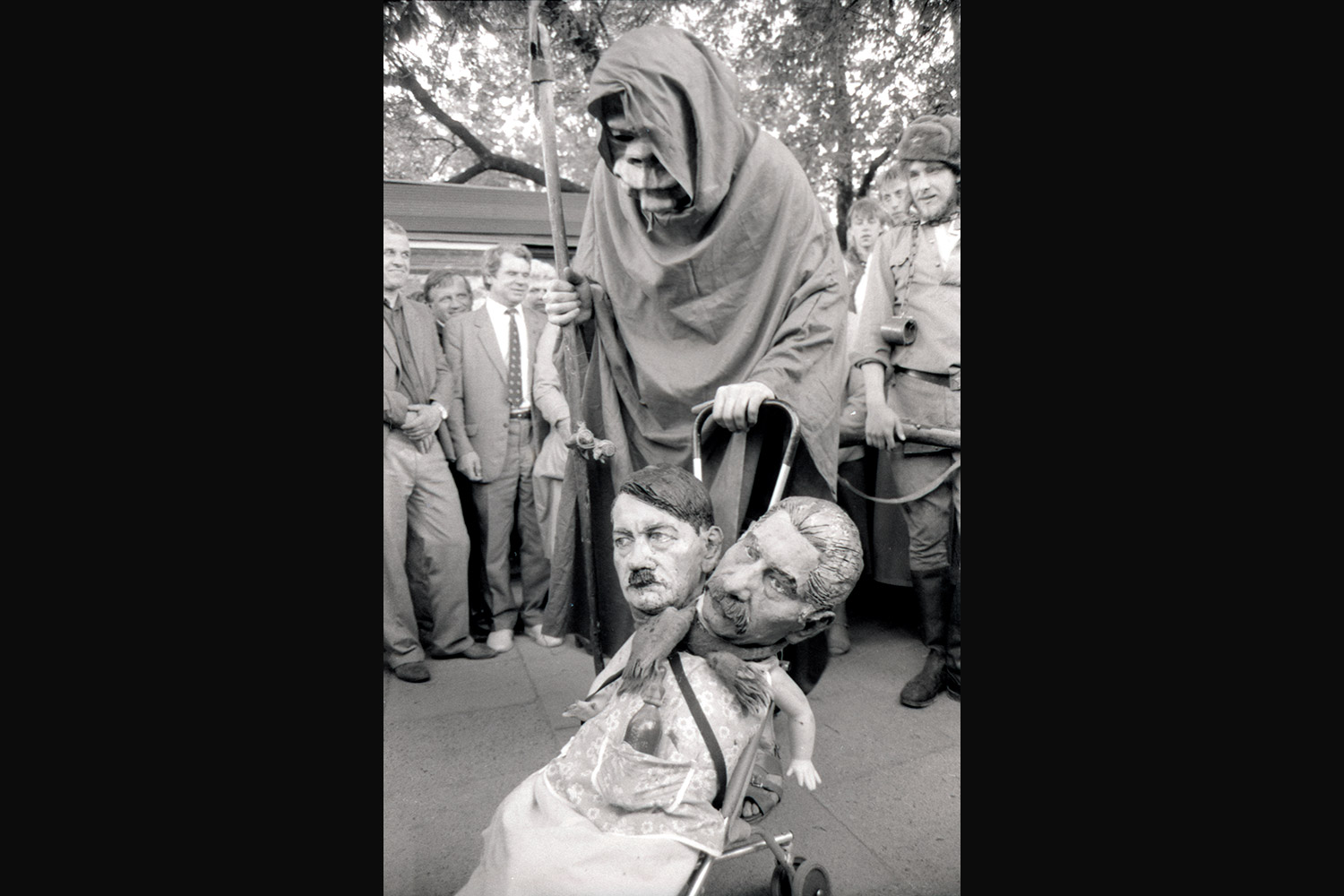 23/08/1989 – Lithuanian National Youth Union “Jaunoji Lietuva” theatricalised protest action in Cathedral Square, condemning the Molotov-Ribbentrop Pact LVCA, photographer: V. Kapočius
23/08/1989 – Lithuanian National Youth Union “Jaunoji Lietuva” theatricalised protest action in Cathedral Square, condemning the Molotov-Ribbentrop Pact LVCA, photographer: V. Kapočius -
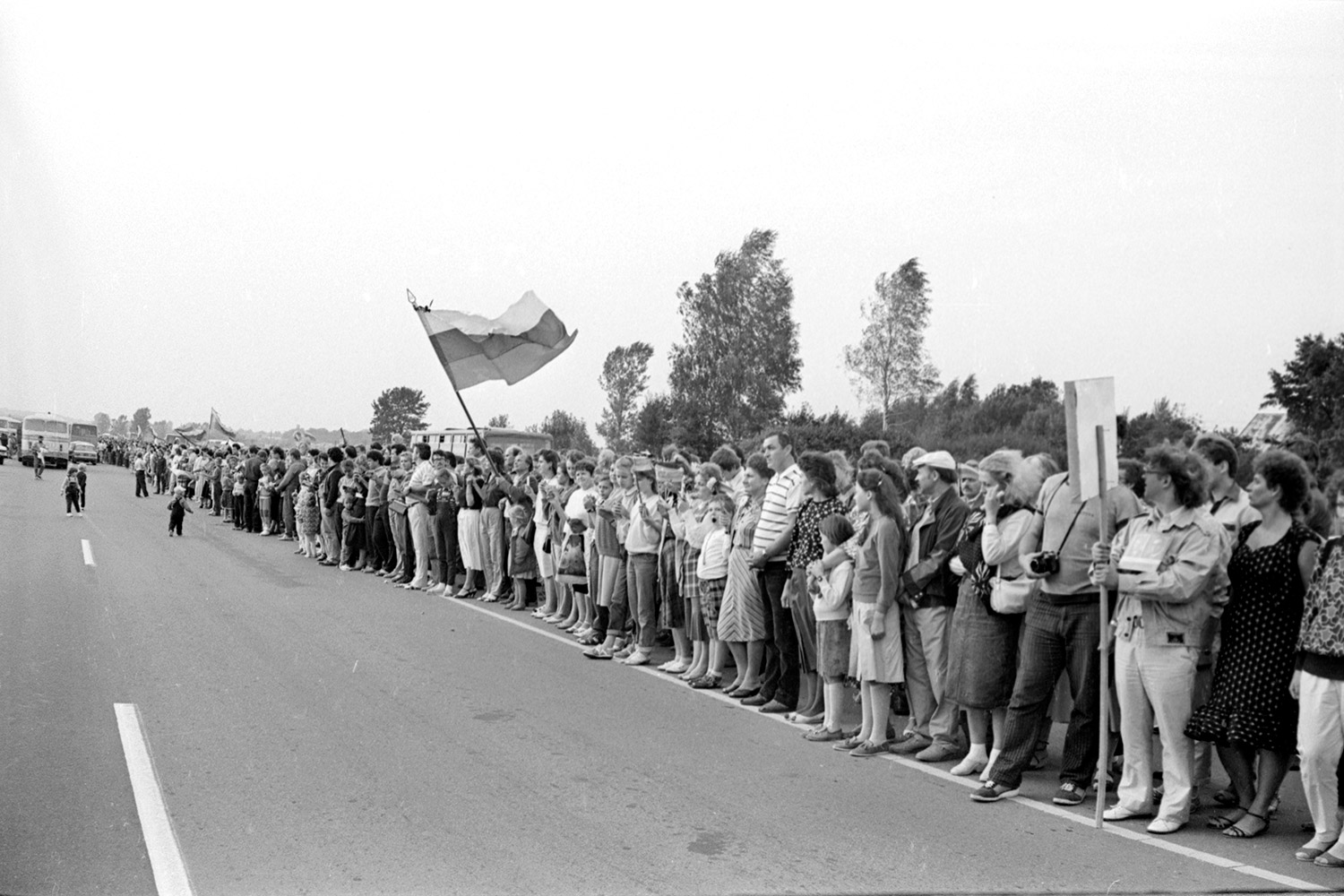 23/08/1989 – Baltic Way. LVCA, photographer: J. Juknevičius.
23/08/1989 – Baltic Way. LVCA, photographer: J. Juknevičius. -
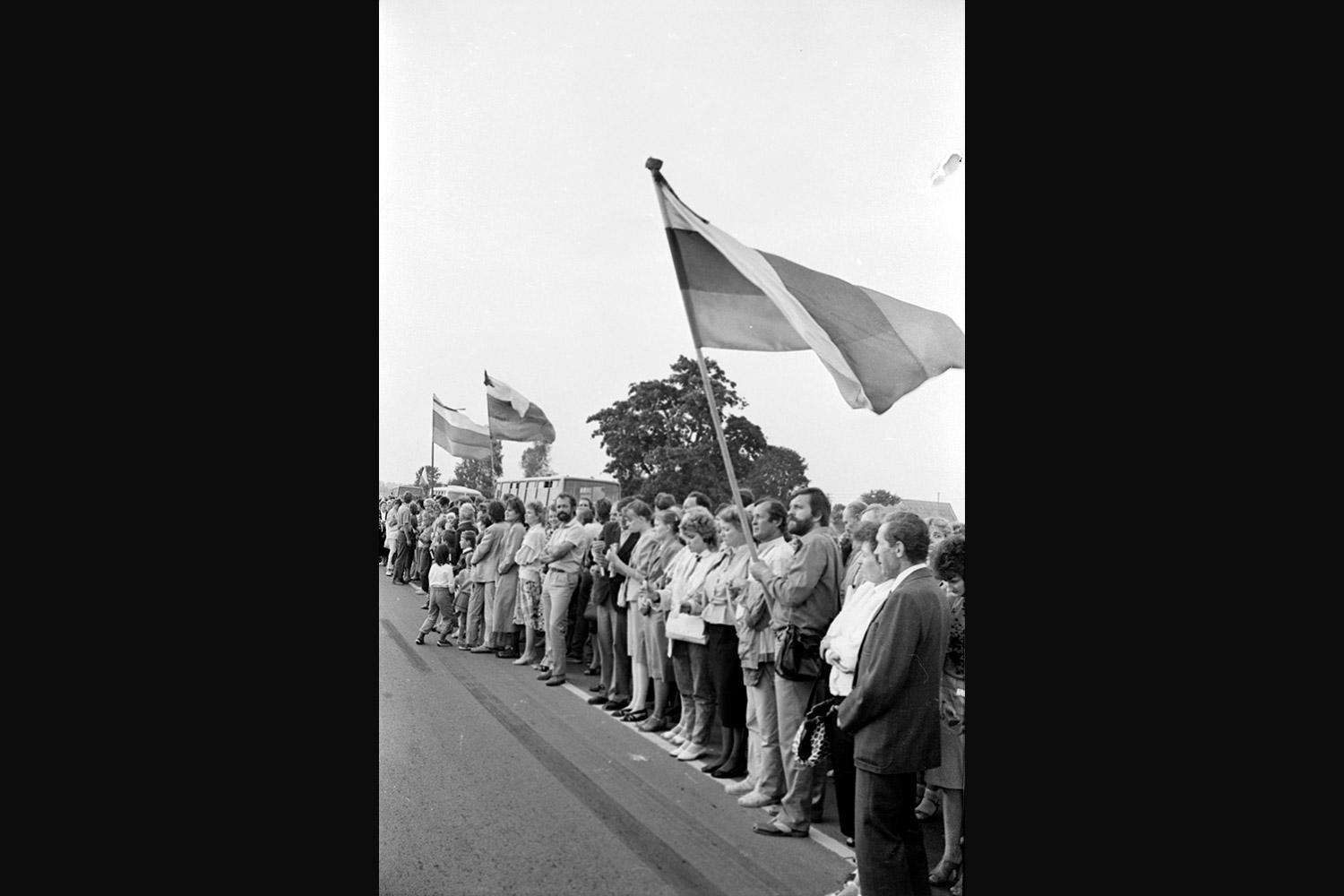 23/08/1989 – Baltic Way. LVCA, photographer: J. Juknevičius.
23/08/1989 – Baltic Way. LVCA, photographer: J. Juknevičius. -
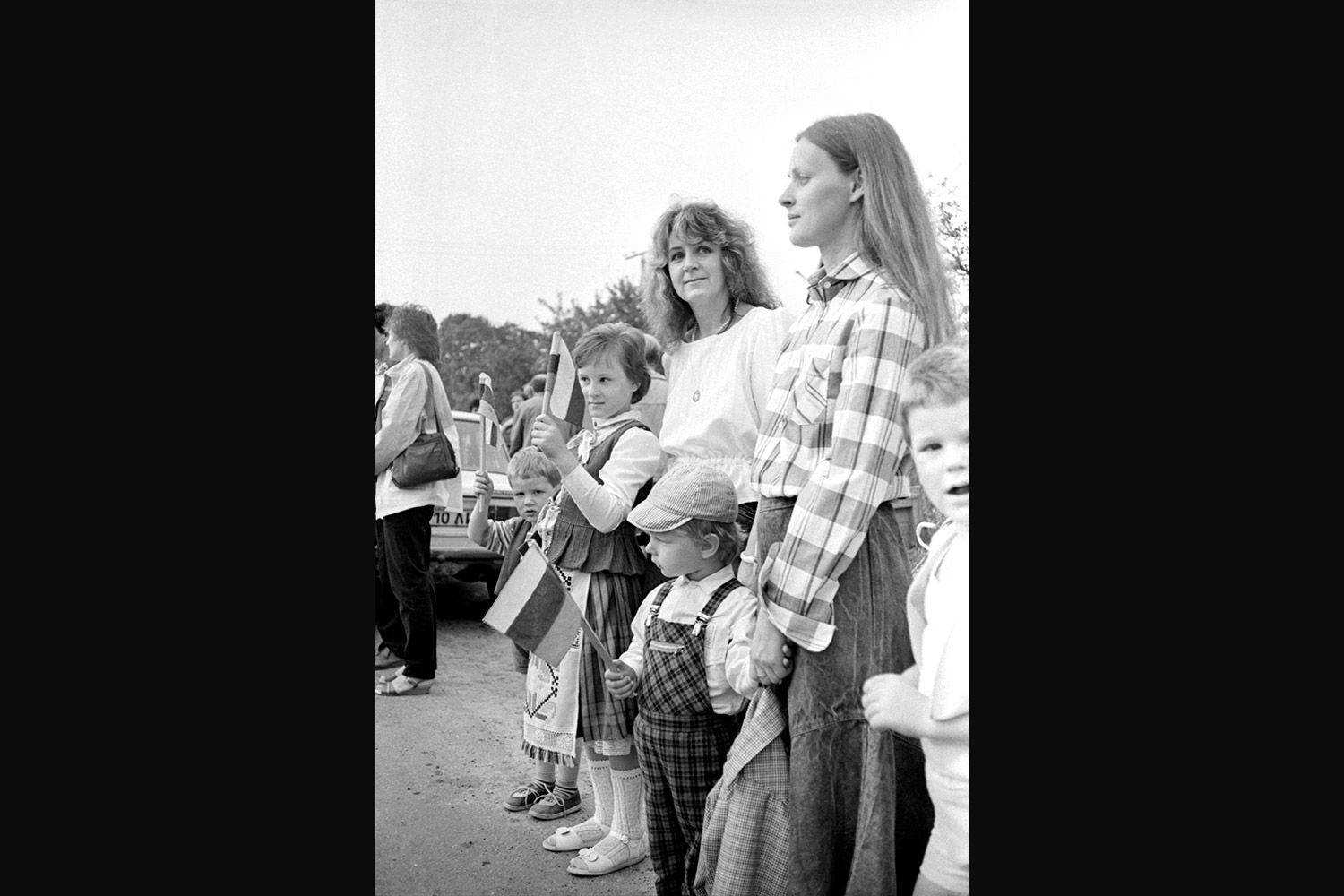 23/08/1989 – Baltic Way. LVCA, photographer: J. Juknevičius.
23/08/1989 – Baltic Way. LVCA, photographer: J. Juknevičius. -
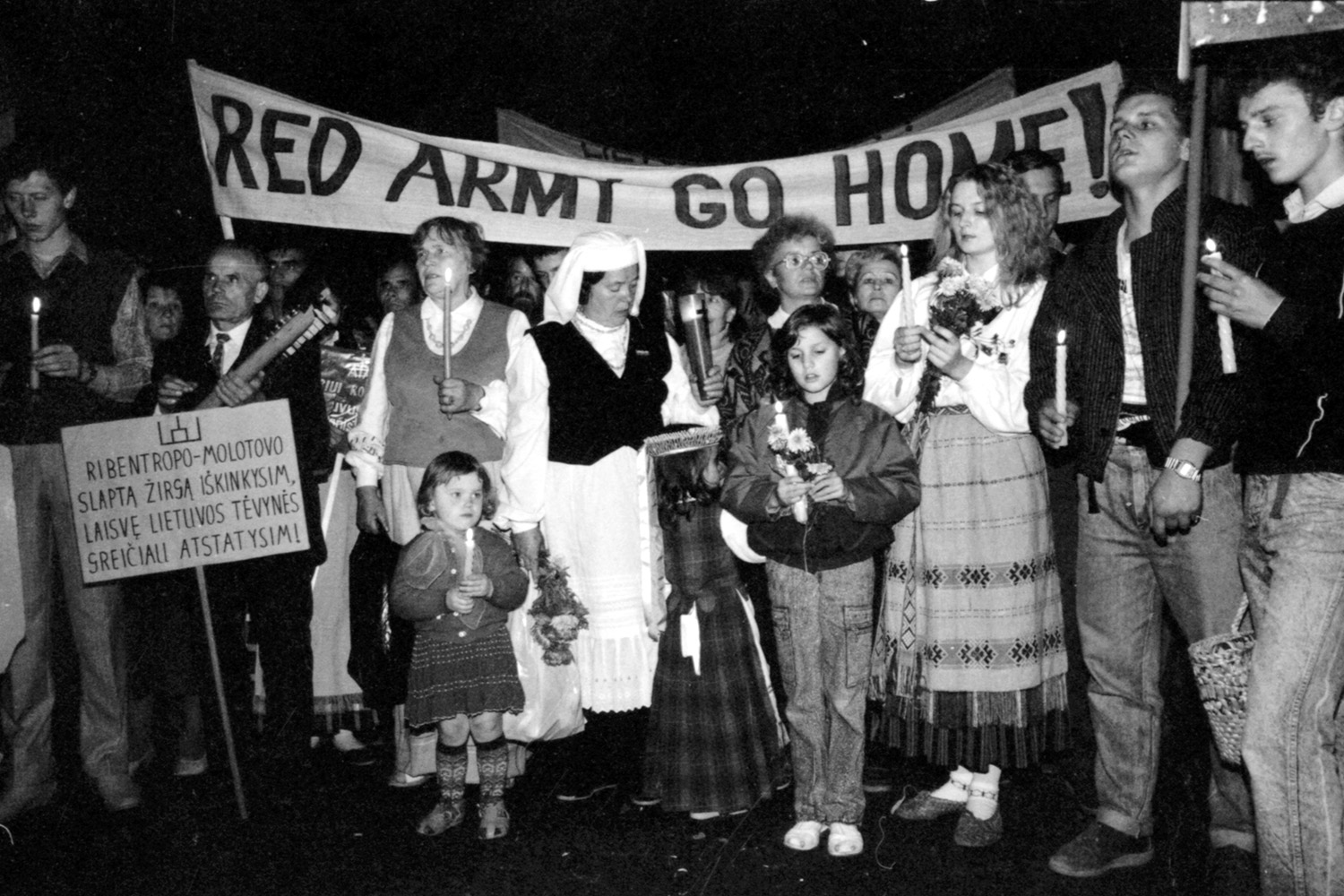 28/09/1989 – Rally in Vilnius to condemn the Molotov-Ribbentrop Pact. LVCA, photographer: E. Masevičius.
28/09/1989 – Rally in Vilnius to condemn the Molotov-Ribbentrop Pact. LVCA, photographer: E. Masevičius. -
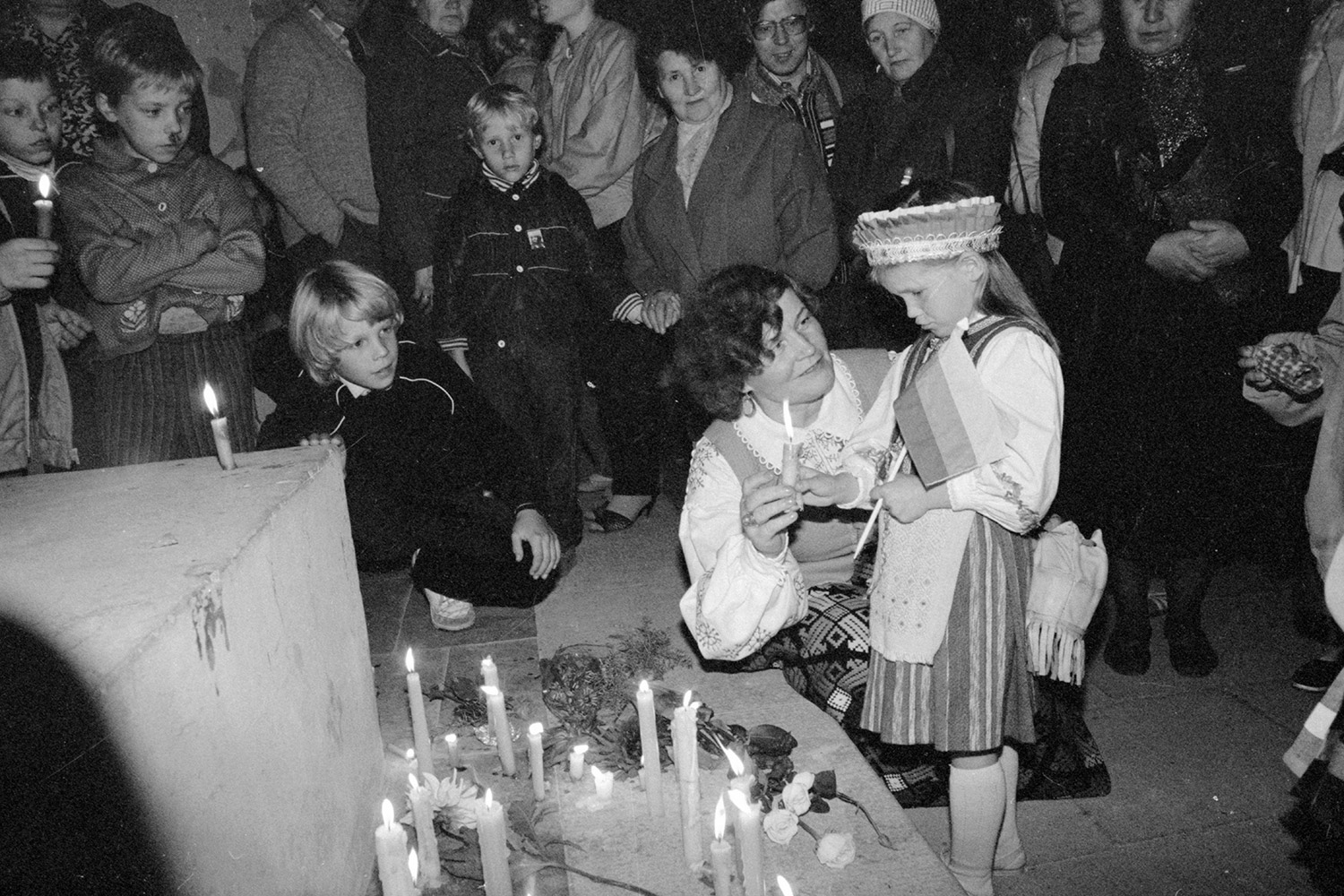 28/09/1989 – Fragment of the rally in Vilnius to condemn the Molotov-Ribbentrop Pact. LVCA, photographer: E. Masevičius.
28/09/1989 – Fragment of the rally in Vilnius to condemn the Molotov-Ribbentrop Pact. LVCA, photographer: E. Masevičius. -
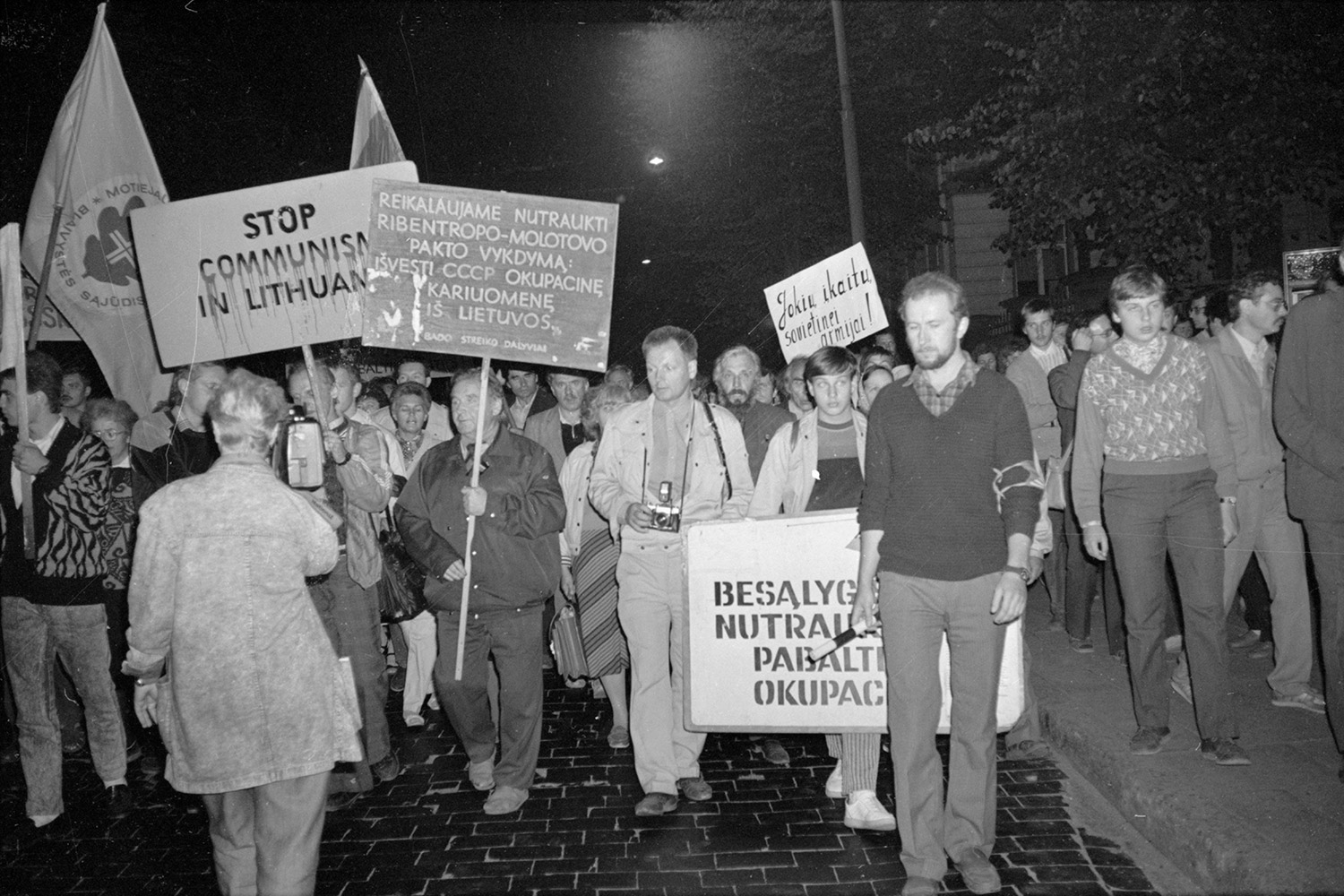 September 1989 – Mourning procession in Vilnius protesting the consequences of the Molotov-Ribbentrop Pact in Lithuania. LVCA, photographer: J. Juknevičius.
September 1989 – Mourning procession in Vilnius protesting the consequences of the Molotov-Ribbentrop Pact in Lithuania. LVCA, photographer: J. Juknevičius. -
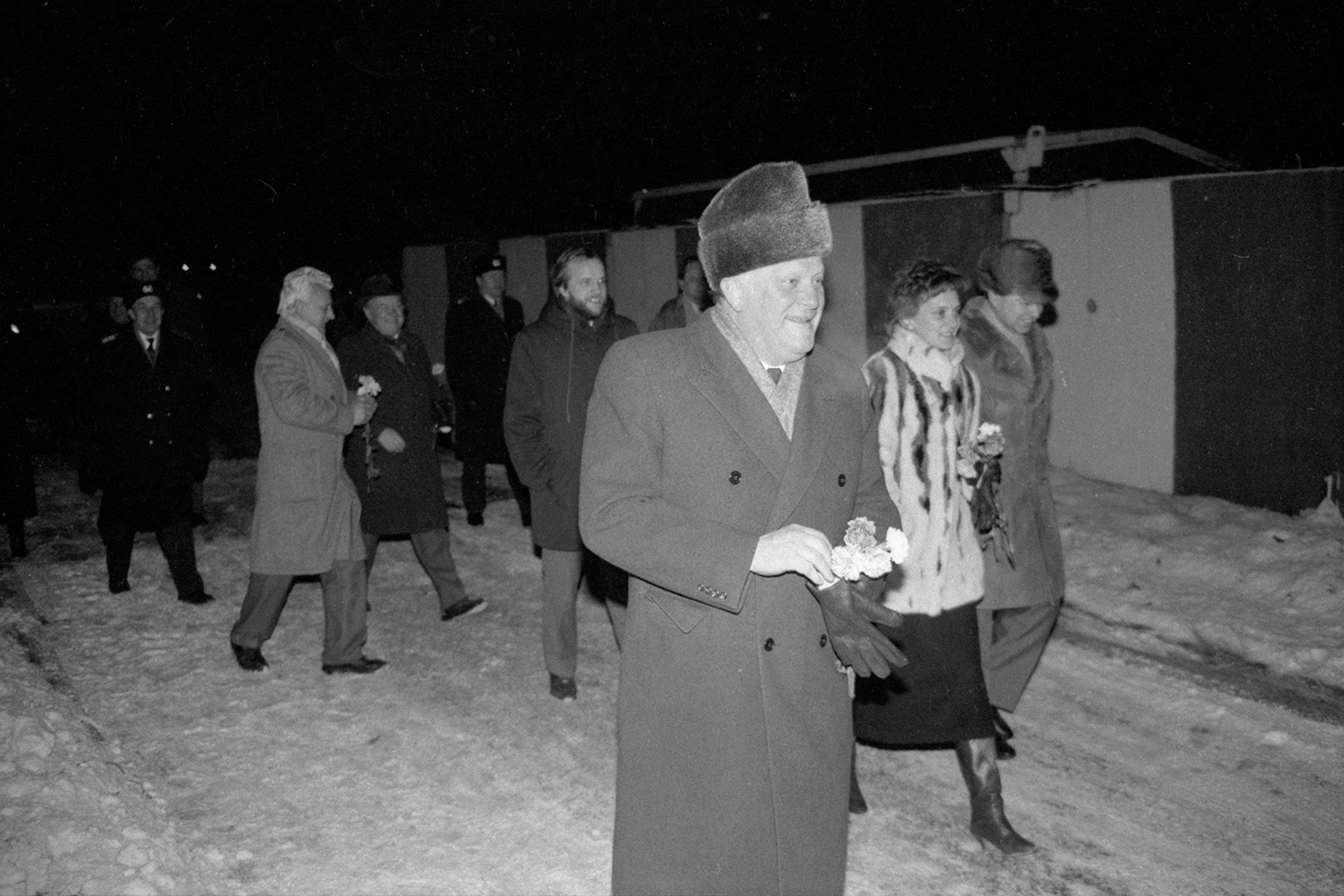 Meeting of Lithuanian deputies who returned from Moscow at Vilnius Airport. At the front: Algirdas Mykolas Brazauskas, First Secretary of the Central Committee of Communist Party of Lithuania; followed by: Juozas Olekas, Member of the Seimas of the Sąjūdis of Lithuania. LVCA, photographer: P. Lileikis.
Meeting of Lithuanian deputies who returned from Moscow at Vilnius Airport. At the front: Algirdas Mykolas Brazauskas, First Secretary of the Central Committee of Communist Party of Lithuania; followed by: Juozas Olekas, Member of the Seimas of the Sąjūdis of Lithuania. LVCA, photographer: P. Lileikis. -
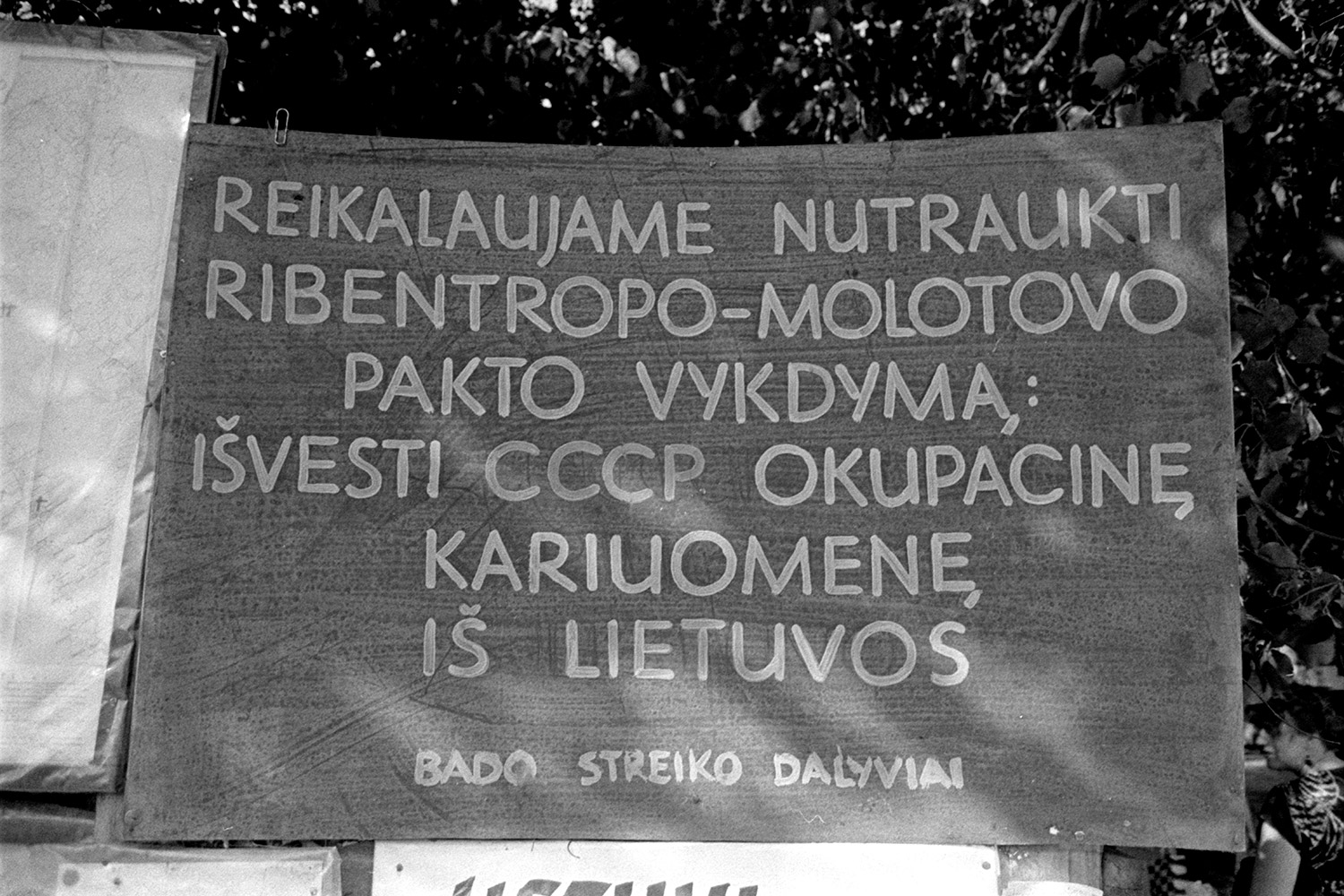 August 1989 – Picket in Gediminas (Cathedral) Square. Poster with the following words: “We demand the suspension of the Molotov-Ribbentrop Pact: to withdraw the Soviet occupying army from Lithuania / Participants of the hunger strike”. LCVA, photographer: A. Žižiūnas.
August 1989 – Picket in Gediminas (Cathedral) Square. Poster with the following words: “We demand the suspension of the Molotov-Ribbentrop Pact: to withdraw the Soviet occupying army from Lithuania / Participants of the hunger strike”. LCVA, photographer: A. Žižiūnas.
24/12/1989
ON THE POLITICAL AND LEGAL ASSESSMENT OF THE 1939 SOVIET-GERMAN NON-AGGRESSION TREATY (RESOLUTION OF THE CONGRESS OF PEOPLE’S DEPUTIES OF THE USSR)
On 24 December 1989, the Resolution of the Congress of People’s Deputies of the USSR was of historical significance to the Baltic nations. For the first time since 23 August 1939–10 January 1941, the highest Soviet government of Lithuania, Latvia, and Estonia finally recognised and condemned its own illegal actions towards the Baltic States by the signing of the documents of the Molotov-Ribbentrop Pact and the occupation/annexation of Lithuania, Latvia, and Estonia in June–August 1940.
“The Congress of People’s Deputies of the USSR condemns the fact of signing the secret protocol on August 23rd 1939 as well as other secret agreements made with Germany. The Congress declares the secret protocols legally unjustified and invalid from the moment of signing.”
-
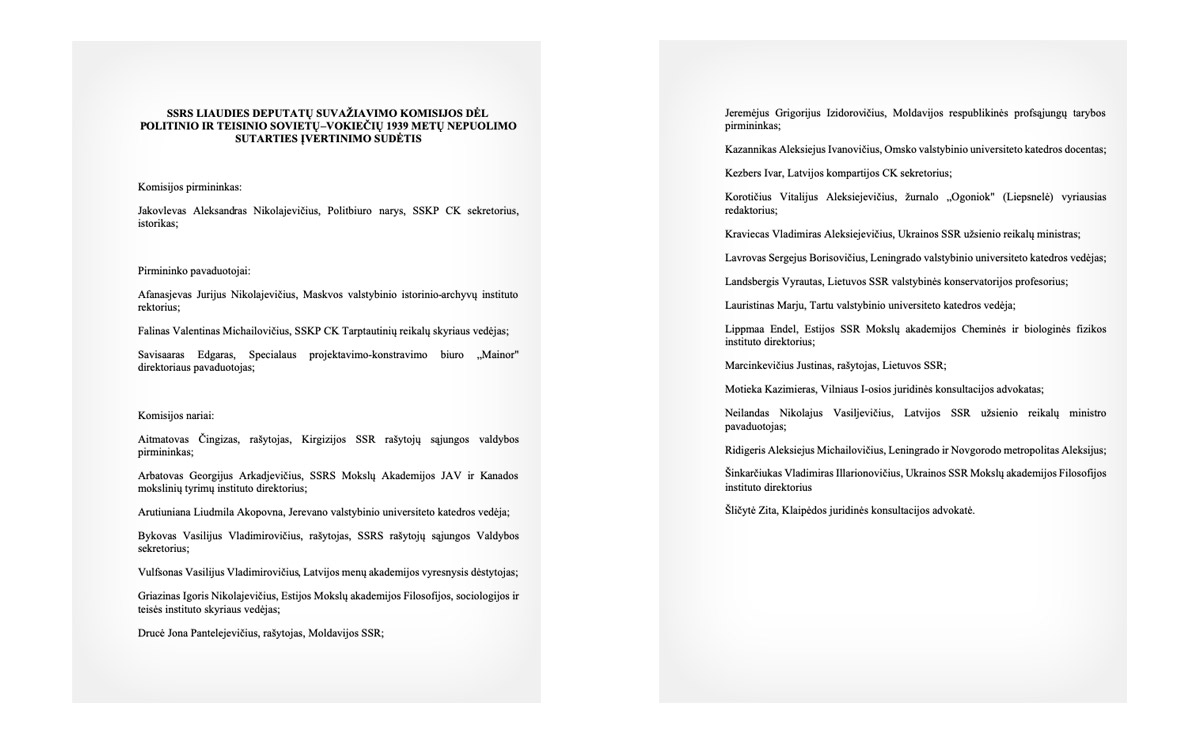 In June 1989, during the First Congress of the People’s Deputies of the USSR, a special list of members of the Commission, to investigate and legally evaluate the Molotov-Ribbentrop Pact, was made. Линдпере Хейки, ПАКТ МОЛОТОВА–РИББЕНТРОПА. Трудное признание, Eesti Välispoliitika Instituut, 2009, с. 151.
In June 1989, during the First Congress of the People’s Deputies of the USSR, a special list of members of the Commission, to investigate and legally evaluate the Molotov-Ribbentrop Pact, was made. Линдпере Хейки, ПАКТ МОЛОТОВА–РИББЕНТРОПА. Трудное признание, Eesti Välispoliitika Instituut, 2009, с. 151. -
 Preliminary Draft Resolution No 1 on the political and legal evaluation of the Molotov-Ribbentrop Pact, prepared by the Commission at the Congress of People’s Deputies of the USSR in summer-autumn 1989 and signed by 20 of the 26 Commissioners. Photocopy of the document. From the personal archives of Zita Šličytė, Commissioner for the Congress of People’s Deputies of the USSR and Deputy of the Supreme Council-Reconstituent Seimas of the Republic of Lithuania, 1990–1992.
Preliminary Draft Resolution No 1 on the political and legal evaluation of the Molotov-Ribbentrop Pact, prepared by the Commission at the Congress of People’s Deputies of the USSR in summer-autumn 1989 and signed by 20 of the 26 Commissioners. Photocopy of the document. From the personal archives of Zita Šličytė, Commissioner for the Congress of People’s Deputies of the USSR and Deputy of the Supreme Council-Reconstituent Seimas of the Republic of Lithuania, 1990–1992. -
 Preliminary Draft Resolution No 1 on the political and legal evaluation of the Molotov-Ribbentrop Pact, prepared by the Commission at the Congress of People’s Deputies of the USSR in summer-autumn 1989 and signed by 20 of the 26 Commissioners. Photocopy of the document. From the personal archives of Zita Šličytė, Commissioner for the Congress of People’s Deputies of the USSR and Deputy of the Supreme Council-Reconstituent Seimas of the Republic of Lithuania, 1990–1992.
Preliminary Draft Resolution No 1 on the political and legal evaluation of the Molotov-Ribbentrop Pact, prepared by the Commission at the Congress of People’s Deputies of the USSR in summer-autumn 1989 and signed by 20 of the 26 Commissioners. Photocopy of the document. From the personal archives of Zita Šličytė, Commissioner for the Congress of People’s Deputies of the USSR and Deputy of the Supreme Council-Reconstituent Seimas of the Republic of Lithuania, 1990–1992. -
 Preliminary Draft Resolution No 2 on the political and legal evaluation of the Molotov-Ribbentrop Pact, prepared by the Commission at the Congress of People’s Deputies of the USSR in summer-autumn 1989 and signed by 21 of the 26 Commissioners. Photocopy of the document. From the personal archives of Zita Šličytė, Commissioner for the Congress of People’s Deputies of the USSR and Deputy of the Supreme Council-Reconstituent Seimas of the Republic of Lithuania, 1990–1992.
Preliminary Draft Resolution No 2 on the political and legal evaluation of the Molotov-Ribbentrop Pact, prepared by the Commission at the Congress of People’s Deputies of the USSR in summer-autumn 1989 and signed by 21 of the 26 Commissioners. Photocopy of the document. From the personal archives of Zita Šličytė, Commissioner for the Congress of People’s Deputies of the USSR and Deputy of the Supreme Council-Reconstituent Seimas of the Republic of Lithuania, 1990–1992. -
 Preliminary Draft Resolution No 2 on the political and legal evaluation of the Molotov-Ribbentrop Pact, prepared by the Commission at the Congress of People’s Deputies of the USSR in summer-autumn 1989 and signed by 21 of the 26 Commissioners. Photocopy of the document. From the personal archives of Zita Šličytė, Commissioner for the Congress of People’s Deputies of the USSR and Deputy of the Supreme Council-Reconstituent Seimas of the Republic of Lithuania, 1990–1992.
Preliminary Draft Resolution No 2 on the political and legal evaluation of the Molotov-Ribbentrop Pact, prepared by the Commission at the Congress of People’s Deputies of the USSR in summer-autumn 1989 and signed by 21 of the 26 Commissioners. Photocopy of the document. From the personal archives of Zita Šličytė, Commissioner for the Congress of People’s Deputies of the USSR and Deputy of the Supreme Council-Reconstituent Seimas of the Republic of Lithuania, 1990–1992. -
 Preliminary Draft Resolution No 2 on the political and legal evaluation of the Molotov-Ribbentrop Pact, prepared by the Commission at the Congress of People’s Deputies of the USSR in summer-autumn 1989 and signed by 21 of the 26 Commissioners. Photocopy of the document. From the personal archives of Zita Šličytė, Commissioner for the Congress of People’s Deputies of the USSR and Deputy of the Supreme Council-Reconstituent Seimas of the Republic of Lithuania, 1990–1992.
Preliminary Draft Resolution No 2 on the political and legal evaluation of the Molotov-Ribbentrop Pact, prepared by the Commission at the Congress of People’s Deputies of the USSR in summer-autumn 1989 and signed by 21 of the 26 Commissioners. Photocopy of the document. From the personal archives of Zita Šličytė, Commissioner for the Congress of People’s Deputies of the USSR and Deputy of the Supreme Council-Reconstituent Seimas of the Republic of Lithuania, 1990–1992. -
 Preliminary Draft Resolution No 2 on the political and legal evaluation of the Molotov-Ribbentrop Pact, prepared by the Commission at the Congress of People’s Deputies of the USSR in summer-autumn 1989 and signed by 21 of the 26 Commissioners. Photocopy of the document. From the personal archives of Zita Šličytė, Commissioner for the Congress of People’s Deputies of the USSR and Deputy of the Supreme Council-Reconstituent Seimas of the Republic of Lithuania, 1990–1992.
Preliminary Draft Resolution No 2 on the political and legal evaluation of the Molotov-Ribbentrop Pact, prepared by the Commission at the Congress of People’s Deputies of the USSR in summer-autumn 1989 and signed by 21 of the 26 Commissioners. Photocopy of the document. From the personal archives of Zita Šličytė, Commissioner for the Congress of People’s Deputies of the USSR and Deputy of the Supreme Council-Reconstituent Seimas of the Republic of Lithuania, 1990–1992. -
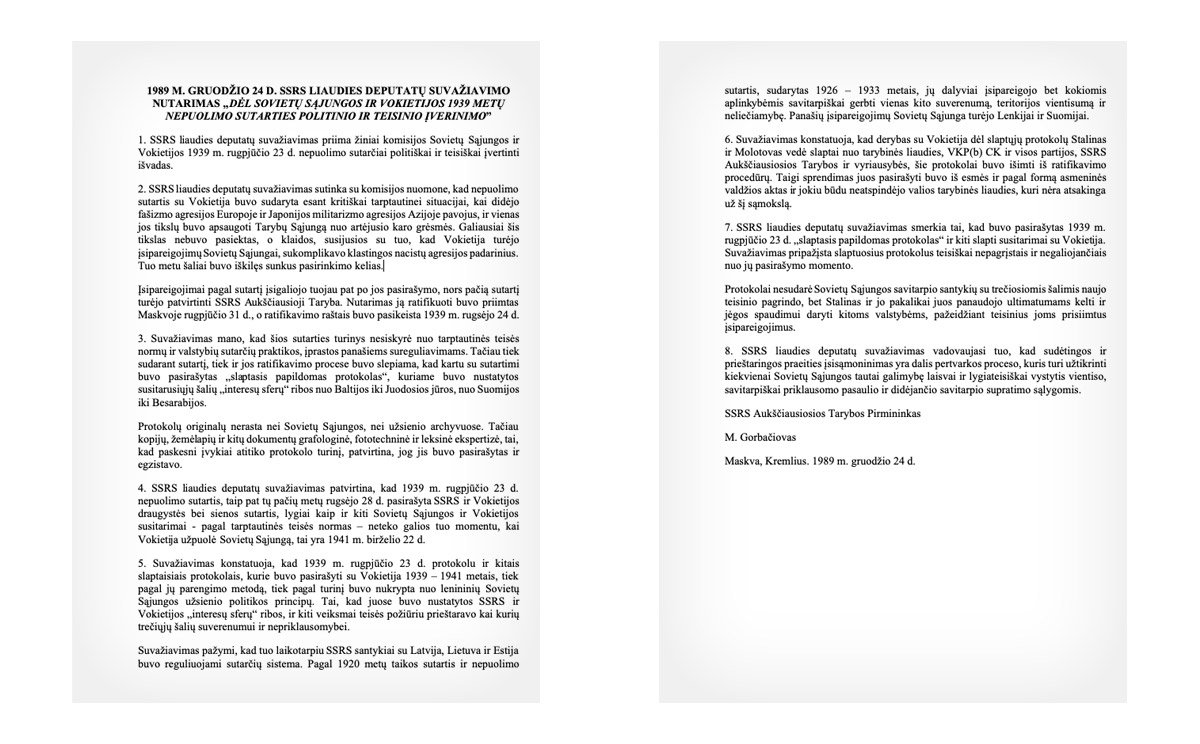 Historic Resolution of 24 December 1989 of the Second Congress of the People’s Deputies of the USSR, politically condemning the Molotov-Ribbentrop Pact, declaring it illegal and invalid from the date of its signing. (Kšanavičius, A. “Nepamirškime pirmosios pergalės” // Naujos tėviškės žinios, 26/03/2010, No 55 (4467), p. 3)
Historic Resolution of 24 December 1989 of the Second Congress of the People’s Deputies of the USSR, politically condemning the Molotov-Ribbentrop Pact, declaring it illegal and invalid from the date of its signing. (Kšanavičius, A. “Nepamirškime pirmosios pergalės” // Naujos tėviškės žinios, 26/03/2010, No 55 (4467), p. 3) -
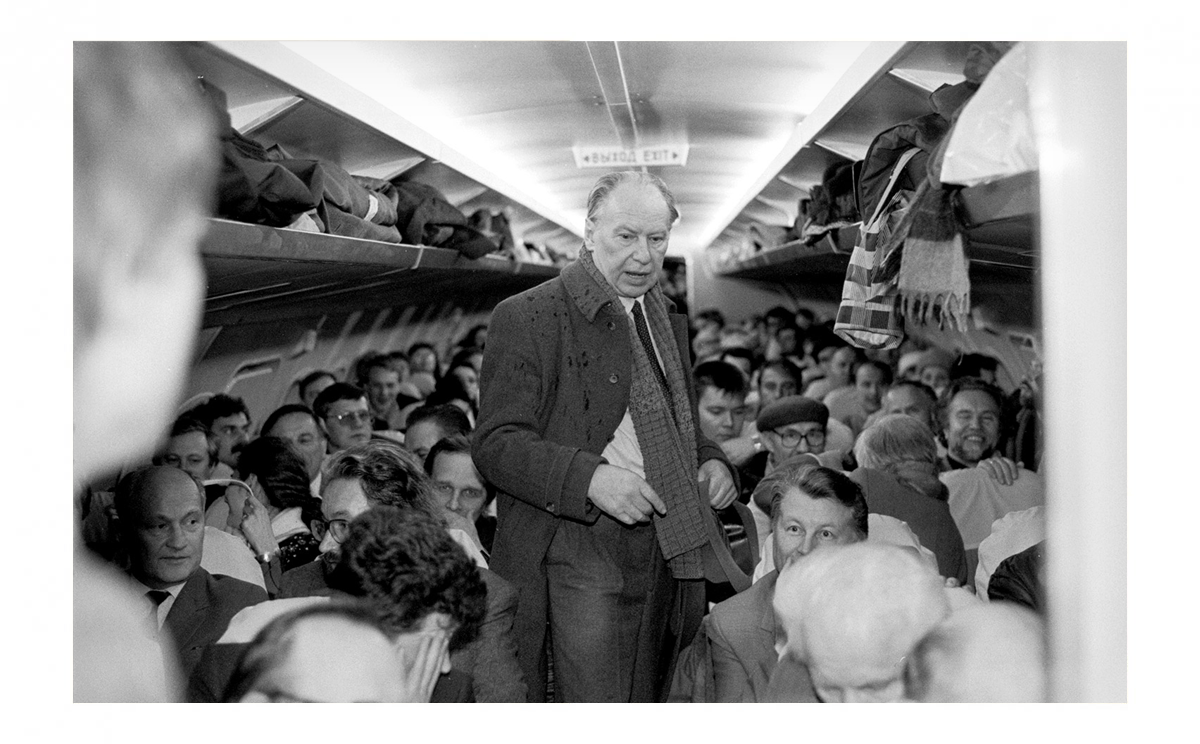 Delegates to the Second Congress of People’s Deputies of the USSR fly to Moscow. In the front: doctor Prof Alfredas Smailys. LVCA, photographer: S. Laukys.
Delegates to the Second Congress of People’s Deputies of the USSR fly to Moscow. In the front: doctor Prof Alfredas Smailys. LVCA, photographer: S. Laukys. -
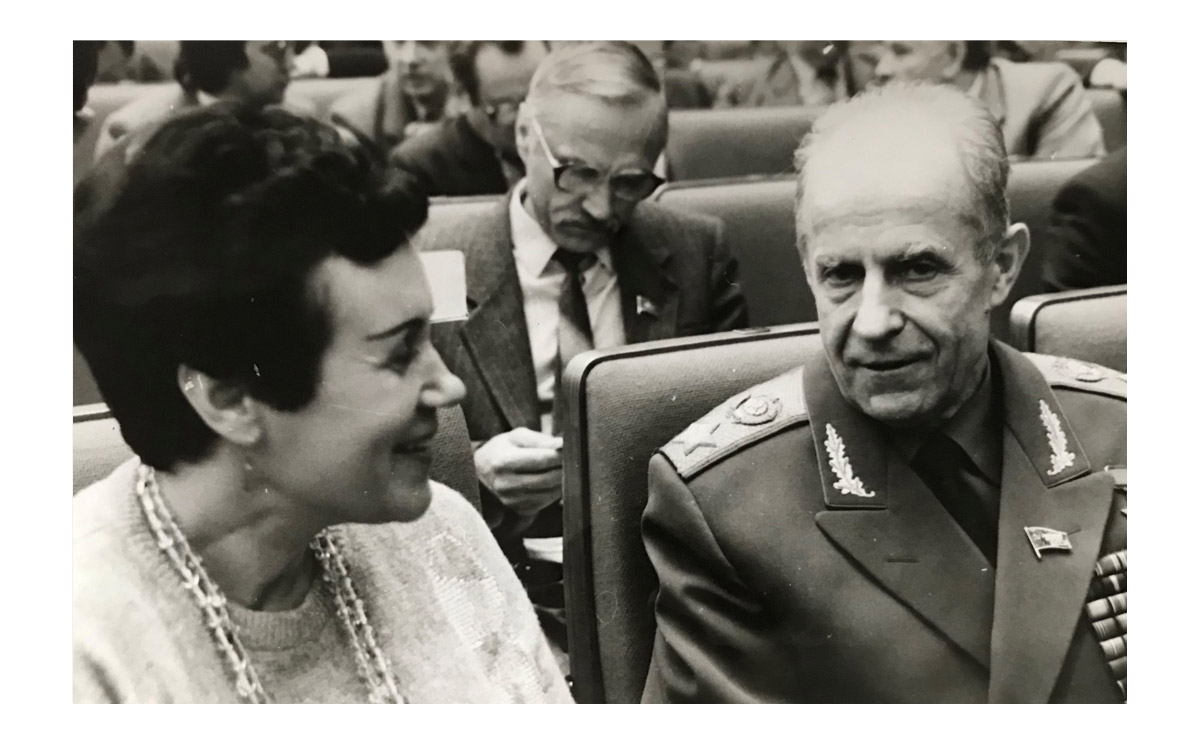 Commissioner Zita Šličytė and Advisor to Mikhail Gorbachev, Marshal Sergey Akhromeyev, at the Second Congress of People’s Deputies of the USSR in Moscow. Photo from the personal archive of Zita Šličytė, Deputy of the Supreme Council-Reconstituent Seimas of the Republic of Lithuania, 1990–1992.
Commissioner Zita Šličytė and Advisor to Mikhail Gorbachev, Marshal Sergey Akhromeyev, at the Second Congress of People’s Deputies of the USSR in Moscow. Photo from the personal archive of Zita Šličytė, Deputy of the Supreme Council-Reconstituent Seimas of the Republic of Lithuania, 1990–1992. -
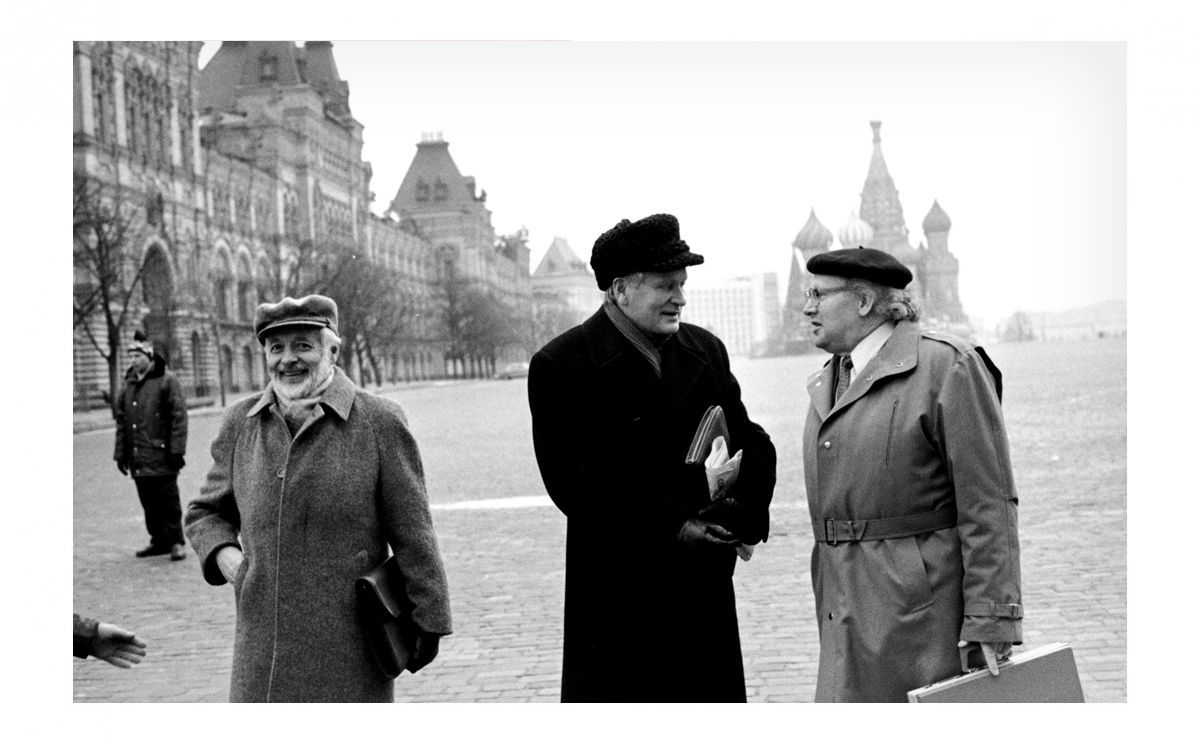 Delegates from Lithuania during the Second Congress of People’s Deputies of the USSR. From the left – first: Vaidotas Antanaitis, third: Algis Mickis and others in the Red Square in Moscow. LVCA, photographer: S. Laukys.
Delegates from Lithuania during the Second Congress of People’s Deputies of the USSR. From the left – first: Vaidotas Antanaitis, third: Algis Mickis and others in the Red Square in Moscow. LVCA, photographer: S. Laukys.
This exhibition was created after the appeal of Gitanas Nausėda, President of the Republic of Lithuania, to Angela Merkel, the German Federal Chancellor, who agreed that the facsimiles of the Molotov-Ribbentrop Pact and its secret protocols would be exhibited in Lithuania. It was decided to implement this just before Christmas Eve in order to commemorate the date of 24 December 1989, which is of considerable historical importance to Lithuania and all the Baltic nations in the struggle for the restoration of independence.
Curator: Dr Algimantas Kasparavičius (LII); editor: Brigita Kulikovskienė.
Thank you to Angela Merkel, Chancellor of Germany, and the Political Archive of the German Federal Foreign Office.
Copies, in the original languages, of the Secret Protocol of 10/01/1940 from the publication: Kavaliauskas, V. “Suokalbis”. Vilnius: Lituanus, 1989.
Exhibition organiser

Partner of exhibition



